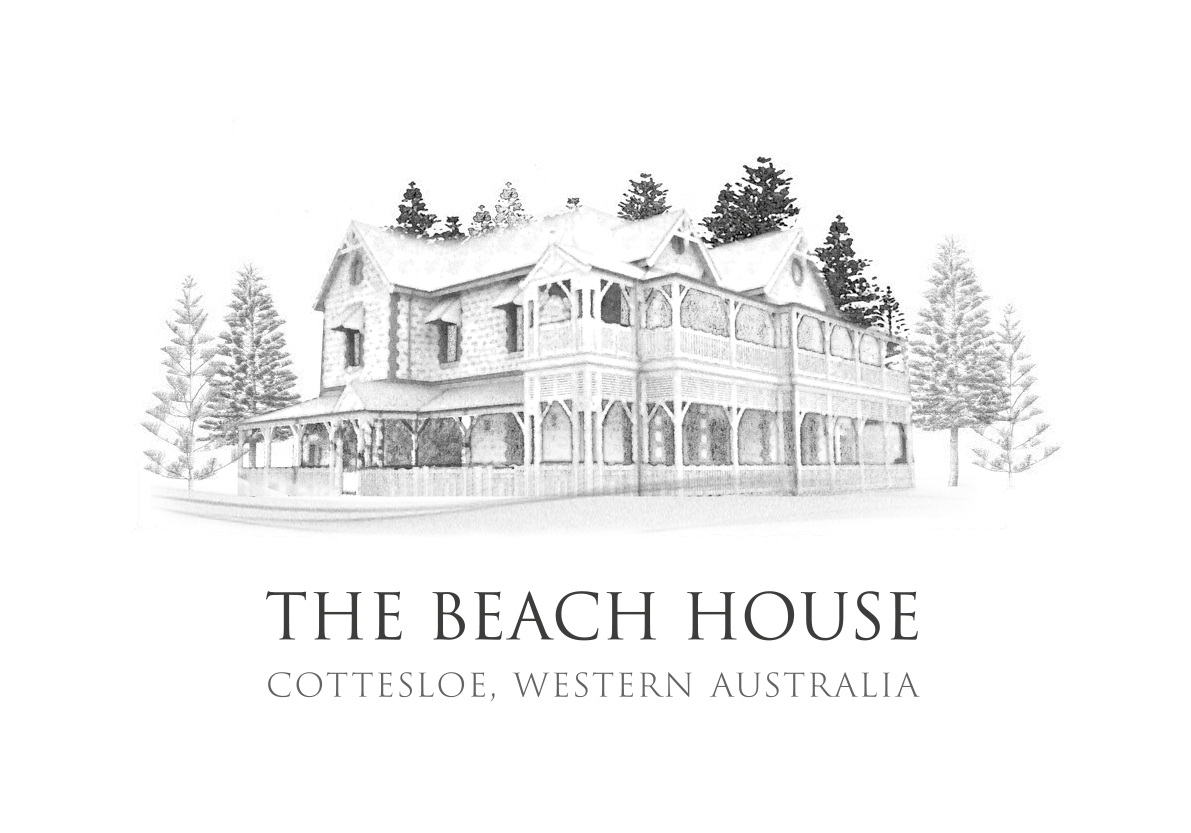
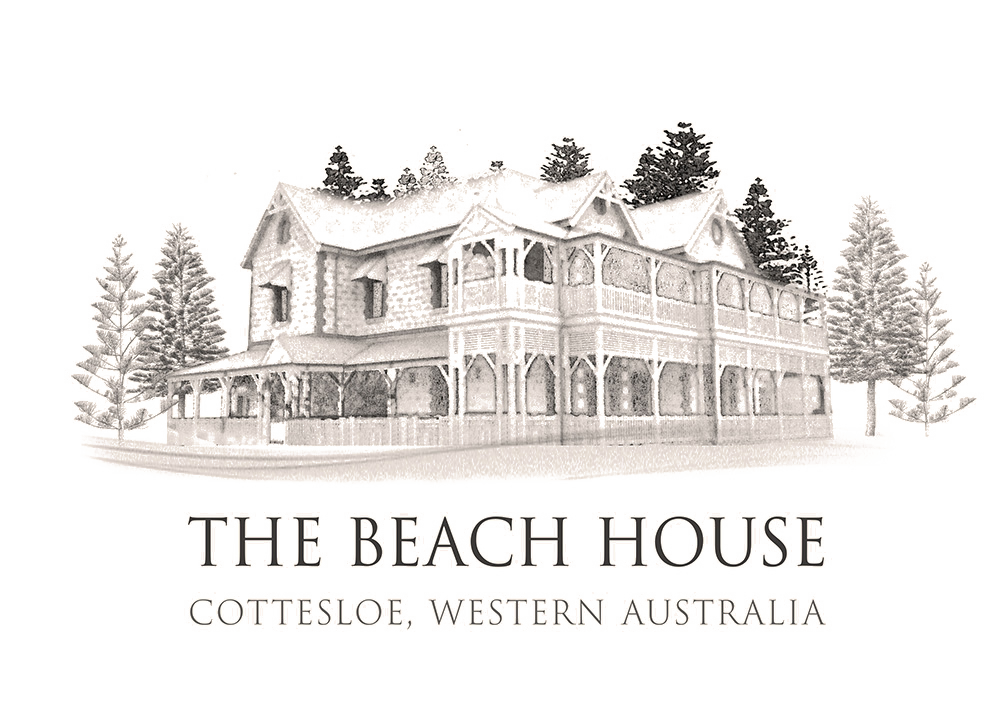

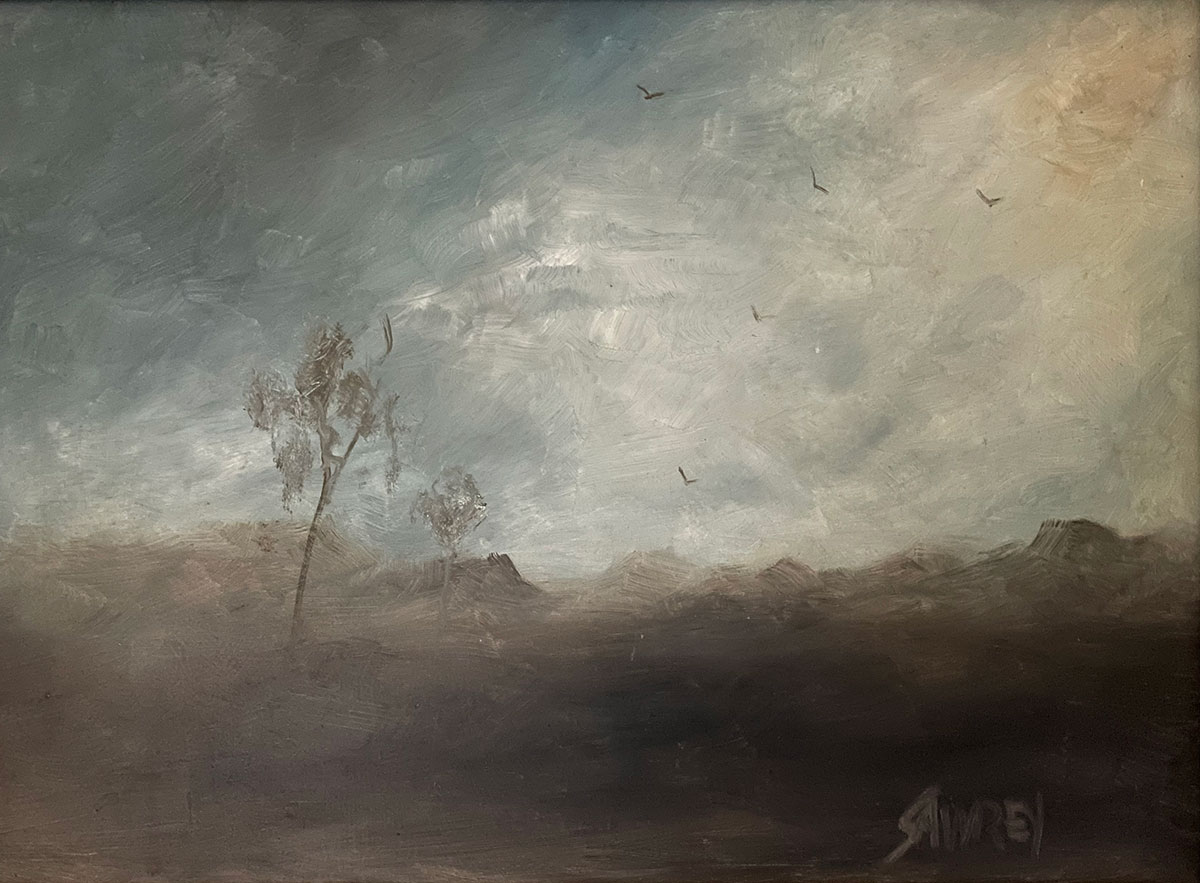

Marie Celine Porkilani was one of a group of elderly artists who lived at Paru on Melville Island in the late 1980s.
Mopaditi are spirits of the dead. Pukamani poles such as this represent individual people who have passed away and act as a symbol of the mourning process that can continue after the deceased person has been buried. These carvings are notable for energetic and provocative figures. Many were tiered as Porkilani’s work demonstrates.


Mr. Brainwash (MBW) is the pseudonym for the graffiti street artist Thierry Guetta. Mr. Brainwash was born in France in 1966.
Originally a videographer, Mr. Brainwash began his career in 1999 documenting the lives and artwork of various graffiti street artists such as Banksy and Shepard Fairey. On a visit to France, Guetta filmed his cousin, the street artist Space Invader. The experience changed Guetta’s life. He was drawn to the immediacy, impermanence and the danger of street art, and as he watched Invader install video game mosaics in Paris, he became fascinated with the role of street art in modern culture.
His works combine the bright and bold colours of urban graffiti with homages to some of pop culture’s most iconic individuals. The 2006 canvas Einstein is a recognisable Mr Brainwash work that shows his style with the figure of Albert Einstein crafted in the style of Warhol’s silkscreens.

Although a self-taught painter, Robert Dickerson (1924-2015) was a highly respected and popular Australian artist of the 20th century.
The Tourists captures the essence of Dickerson’s career-defining style which could be described as ‘surreal-figurative’. This work was painted in 2007 which is very late in Dickerson’s career, therefore representing a lifetime of practice worked into a singular canvas. The painting depicts a couple (presumably the “tourists”) resting in an empty landscape while a darkly attired figure in the background appears to take a large step into the yellow and green abyss.
In 1964 Dickerson famously noted: ‘I try to paint something that will be different from all the rubbish everywhere. Everybody is trying to run away from facing certain issues. My work is a protest against that if you like; but I am not trying to prove something. I just paint what I feel like painting.’
His work is held by all state Australian institutions such as the National Gallery of Australia in Canberra, the Art Gallery of NSW Sydney and the National Gallery of Victoria in Melbourne. Notably, his work is also held internationally by the British Museum in London.
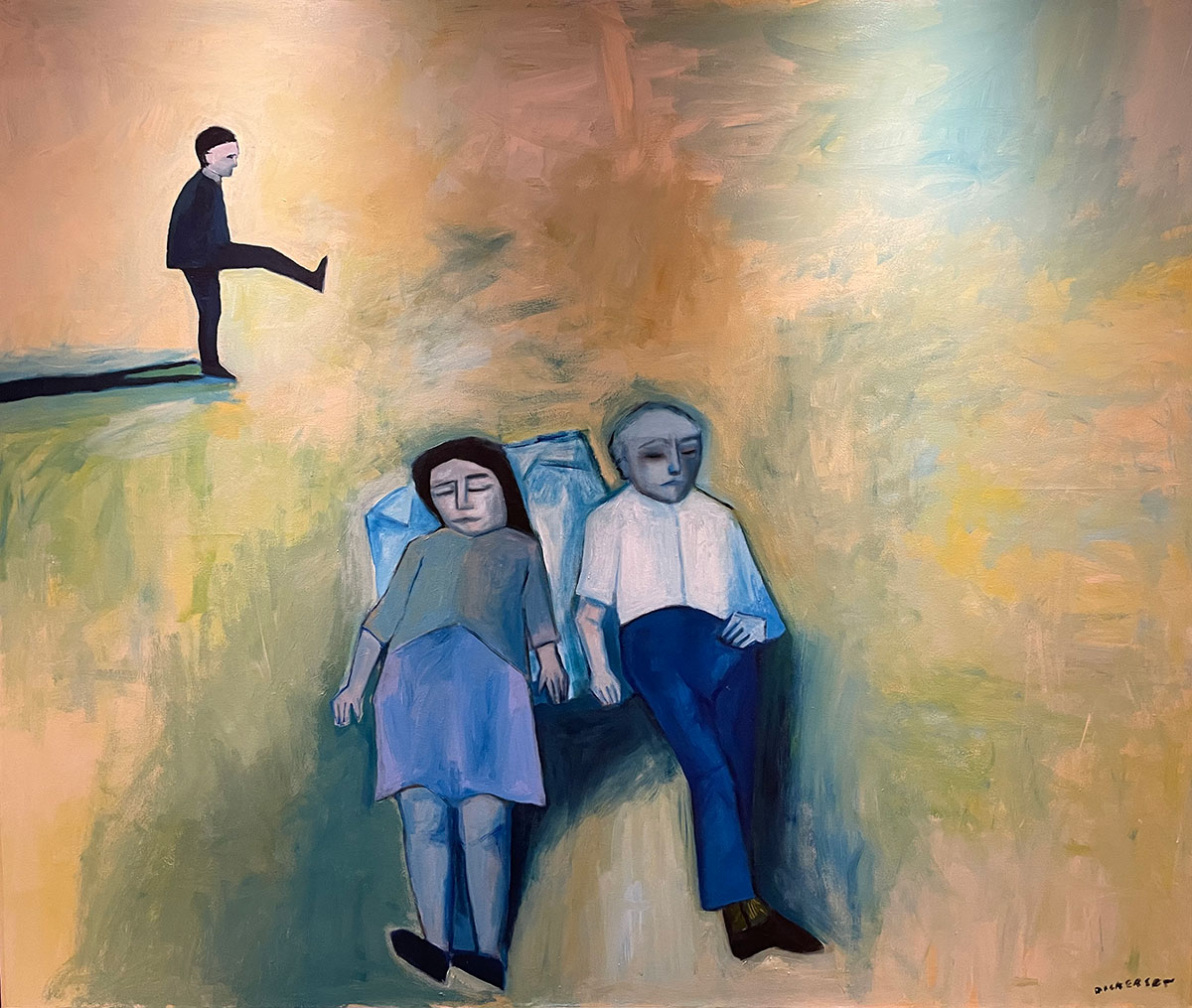
A Highly Important and Early Panoramic View of King George’s Sound, Part of the Colony of Swan River
Robert Dale was a painter, topographical draughtsman and the first European explorer to cross the Darling Range in Western Australia.
In February 1829, Dale embarked for Western Australia on HMS Sulphur as part of a detachment of troops commanded by Captain Frederick Chidley Irwin. On arrival at the Swan River colony, he was seconded as an assistant to Surveyor General John Septimus Roe.
The artwork A Highly Important and Early Panoramic View of King George’s Sound, Part of the Colony of Swan River is a detailed reflection on Dale’s time in Western Australia capturing the vastness of the Australian landscape in the early 19th century. The impressive length of the work is unique for artworks at the time as they were usually completed on a smaller scale, therefore the work offers an extraordinarily rare, in depth view of the terrain.
According to the Colonial Eye, the scene “depicts ‘Princess Royal Harbour, where the first settlement was established, and to the left of that King George’s Sound and Oyster Harbour. The cleared area to the left is the present site of the “Old Farm” Strawberry Hill. The group of soldiers and natives on the right make up a party returning from a kangaroo hunt. Nakinna, chief of the King George Sound tribe, lived most of the time at the settlement, but eventually rejoined his people. He is probably the native shown wearing European clothes. The party of natives in the centre of the panorama are returning from a fishing expedition to the coast…”
Dale’s work has been shown at the National Gallery of Victoria, Melbourne. Mount Dale, one of the highest points in the Darling Range, to the south of Mundaring Weir, is named after him. The Dale River, a tributary of the Avon River, is also named after him, as is Ensign Dale Place in Northam, Western Australia.

Born in 1929, North Korea, Kim Tschang-Yeul fled to South Korea at a young age, leaving his family behind. After studying at the Seoul’s National University College of Fine Arts, Tschang-Yeul left for New York in 1965 in order to develop his artistry. When in America, he experienced deep isolation which profoundly influenced his style for the rest of his career.
Spanning the early 1970s to the present day, Kim Tschang-Yeul devoted his career to a single optical device, the water droplet, which allowed him to confront the relationship between nature and contemporary culture. As Kim explained, “the act of painting water drops is to dissolve all things within, to return to a transparent state of ‘nothingness.’ By returning anger, anxiety, fear, and everything else to ‘emptiness,’ we experience peace and contentment. While some seek the enhancement of ‘ego,’ I aim toward the extinction of the ego and look for the method of expressing it.”
Kim’s works can be found among the collections of numerous institutions including the National Museum of Contemporary Art, Korea; Centre Pompidou, Paris, France and Museum of Fine Arts, Boston.

Antony Gormley is an internationally acclaimed sculptor who has garnered both critical and wide popular recognition. He is known for his sculptures, installations and public works that investigate the relationship of the human body to space that surrounds it.
The 2019 work Lean II is one from a career-defining series of human figure sculptures that Gormley creates to interact with the surrounding world that they are placed within. The components – resembling building blocks – are made from cor-ten steel and placed together to form a human body leaning against a wall. Gormley sees his figures as ‘reverse caryatids,’ as caryatids are sculpted figures that served as architectural pillars in the ancient world. Lean II defies its cold, heavy material to appear “human”, almost light. The magic in Gormley’s art is his ability to find endless ways to explore psychology and movement of the body – via sculptures made of materials that are hard, heavy and immovable.
Gormley’s work has been widely exhibited throughout the United Kingdom and internationally with solo exhibitions shown at The Royal Academy of Arts, London, 2019; the Philadelphia Museum of Art, Philadelphia, 2019 and a permanent installation at the Ecole Du Louvre in Paris.

From left to right:
Peaceful Dove 2017
Rose Crown Fruit Dove 2017
Superb Fruit Dove 2017
Brown Cuckoo Dove 2017
The photography of Leila Jeffreys creates a dialogue between viewer and subject, as she explores the connection between humanity and birds. Her practice suggests that there is an inherent connection to the natural world and these birds in particular facilitate this.
Jeffreys collaborates with conservationists, ornithologists and sanctuaries around the world to find her subjects before forging an intimate relationship with the birds that she photographs in her studio. The artist also places a strong emphasis on interdependence between species, a vital concept that reflects her interest in environmentalism.
Leila’s portraits of doves, unlike her cockatoos, are left unnamed and are simply titled by their presentation or species. The photographs of doves focus on their bright, unique markings and explore the breadth of natural colours outside the better known symbolic white dove.
Jeffreys’ work is held in the collections of Artbank, Macquarie Bank, Sydney, 21C Museum Hotels, USA and the Museum of Photography in Seoul, South Korea.

Albert (Elea) Namatjira is one of the most critically acclaimed Australian artists of the 20th century. He was one of the foremost painters from the Hermannsburg School, painting in a style that developed at the Northern Territory Hermannsburg Mission in the 1930s.
Painted in the final years of the artist’s life and typical of Namatjira’s later works, North Gully Looking to Mt Gillen, Alice Springs exemplifies the artist’s recurring motifs. Located in the foreground, a majestic ghost gum (Eucalyptus papuana) – known as ilwempe to the Western Arrernte – frames the view to the abrupt slopes of Akngwelye (Mount Gillen) in the middle distance and out to the distant peaks beyond. Namatjira’s familiarity with this country is evident in these views, where trees, mountains and monoliths provide a rich range of possibilities and responses that arise from constantly re-engaging with the same subject. [1]
Namatjira’s work is held at all Australian state museums and the British Museum in London. In 1953, Queen Elizabeth II personally awarded Namatjira the Coronation Medal. In 1955, he was elected an honorary member of the Royal Art Society of New South Wales.
[1] Crispin Gutteridge

Hans Heysen was a German-born Australian artist who became a household name in the early 20th century for his paintings of Australia’s monumental gum trees.
The 1897 painting Burning Off is a small yet impactful work. It depicts the practice of early pastoral management, which involved backburning. Heysen painted this scene with oil on board, giving the work a tactile texture through thick and precise brushstrokes. In doing this, the smoke is given a life of its own. Erratic, it is swept up with the wind and sent into the sky.
From 1904 to 1932, Heysen won the Wynne Prize a record nine times, with the painting Brachina Gorge winning in 1932. In 1945, he was appointed as an officer of the Order of the British Empire for his service as trustee of the Hobart National Gallery. All major State galleries hold his work.

Born at Utopia station in a remote desert community almost 300 km northwest of Alice Springs, Emily Kame Kngwarreye has become one of Australia’s most internationally recognised and significant contemporary artists.
In 1995, Emily participated in a workshop her nephew Fred Torres organised. During this workshop, several major multi-panelled masterpieces were created, including Earth’s Creation II.
The work was painted while the artist sat on the canvas, moving around as she worked continuously until the entire surface was completed. From every part of the work, its sublime orchestration engages the eye with dazzling energy and flowing movement. The painting is a luminous celebration with a mystical, ethereal presence. The painting is about her life, her story, her country. It’s about her universe and the mythologies that inform the Dreamings. filled with mystery. It pays reverence to the sacredness of the Earth, the seasons, vegetation, people, the epic adventures of her spiritual ancestors, and ceremonies that she daily engaged with during her long life.
In 1992, Emily Kngwarreye received the Australian Artists Creative Fellowship from Prime Minister Paul Keating, the first time an Indigenous Australian artist had received the prestigious award. In 1997, she represented Australia posthumously at the Venice Biennale. The Queensland Art Gallery staged a major retrospective of her work in the same year – the first retrospective of an Aboriginal artist to tour nationally. Her work is held in all major Australian art museums.
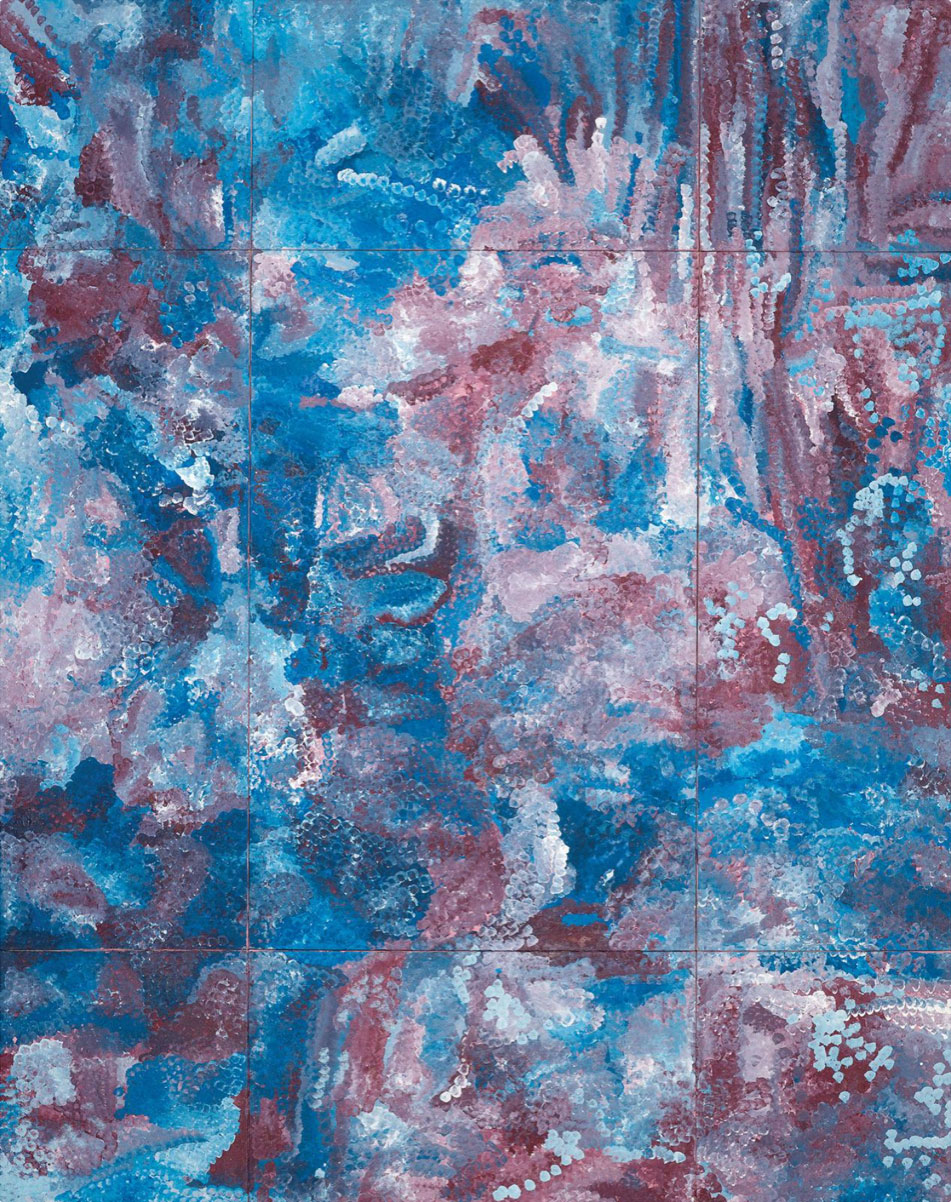
Albert (Elea) Namatjira is one of the most critically acclaimed Australian artists of the 20th century. He was one of the foremost painters from the Hermannsburg School, painting in a style that developed at the Northern Territory Hermannsburg Mission in the 1930s.
Painted in 1951, Looking West from Glen Helen observes the distant ranges far to the west of Glen Helen Gorge and appears atypical in that the viewpoint is not framed by a gum tree or rocky outcrop in the foreground. Presenting a more open horizontal and expansive landscape experience, the artist carefully directs the viewer to the distant peaks and mountain slopes in the middle distance. Namatjira’s familiarity with his country is evident in these long-distance views, where peaks and monoliths provide a rich range of possibilities and responses that arise from constantly re-engaging with the same subject. [1]
Landscape artist Lloyd Rees acknowledged Namatjira’s work, ‘I find a marvellous sense of distance and space in his [Namatjira’s] work. His eye can look far away and seem to know what’s there.’
Namatjira’s work is held at all Australian state museums and the British Museum in London. In 1953, Queen Elizabeth II personally awarded Namatjira the Coronation Medal. In 1955, he was elected an honorary member of the Royal Art Society of New South Wales.
[1] Crispin Gutteridge

Albert (Elea) Namatjira is one of the most critically acclaimed Australian artists of the 20th century. He was one of the foremost painters from the Hermannsburg School, painting in a style that developed at the Northern Territory Hermannsburg Mission in the 1930s.
Palm Valley, part of Namatjira’s mother’s country, is located in what is now known as the Finke Gorge National Park in the Northern Territory. Some of Namatjira’s compositions from the 1940s focus primarily on a single palm. Known as Arrangkeye in the Western Arrente language, the cabbage palm is a scarce plant, a remnant of a time when central Australia was much wetter and covered by such vegetation. Unique to this region, it is restricted to a small area of 60 square kilometres around the Finke River and its tributaries. [1]
Namatjira’s work is held in all Australian state museums and the British Museum in London. In 1953, Queen Elizabeth II personally awarded Namatjira the Coronation Medal. In 1955, he was elected an honorary member of the Royal Art Society of New South Wales.
[1] Crispin Gutteridge
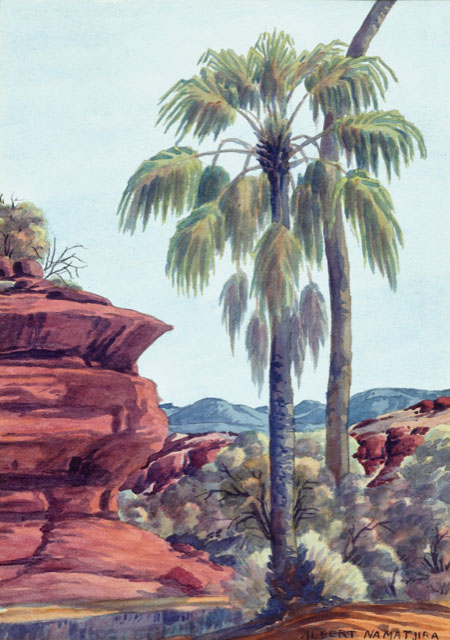
Sidney Nolan is one of Australia’s most famous artists, best-known for his iconic depictions of the 19th century outlaw Ned Kelly.
Growing up in an extended Irish clan, Sidney Nolan was enthralled by the tales of his grandfather, William (Bill) Nolan, a policeman in rural northeastern Victoria who had been involved in the pursuit of the Kelly Gang and its most famous member, Edward (Ned) Kelly. Kelly was distinguished not only by his actions, but equally by his home-made suit of armour, replete with iron helmet.
Early Morning Township, 1955 is an augury of a skirmish to come. Ned Kelly is seen studying the township in the cool light of morning. The town sleeps while Kelly, set to one side of the composition, sits astride his steed, rifle in hand. The outlaw is still but his dappled mount sniffs the air, perhaps sensing the danger to come. The composition can be read as the prelude to the violence of the Glenrowan Siege; a poignant moment as Kelly contemplates the polite society to which he will never belong. It is also a counterpoint to an important painting purchased in 1955 by the Museum of Modern Art, New York. Titled Glenrowan Siege, 1955, this work shows the ruined aftermath of the battle in which many of the Kelly Gang members were killed.
Sydney Nolan’s work is held in all major Australian institutions including the National Gallery of Australia, Canberra, the Art Gallery of NSW, Sydney and the National Gallery of Victoria, Melbourne.

A pioneer of Australian modern art, Roy de Maistre’s exploration of colour and abstract form was considered well advanced at the time. His paintings transcended geographical barriers, acknowledged in England and Europe.
Roy de Maistre’s ‘Still Life’ paintings are also held in high regard. His still life artworks act as a study in form and colour, representing his various artistic processes. Roy de Maistre was known to paint numerous preliminary studies of his compositions and once finalised, would then execute a further series of variations.
The work “Still Life” isn’t particularly complex depicting a somewhat “cubist” surface, upon which sits a vessel along with fruit that appears to have been just unwrapped. The painting, whilst not especially sophisticated, offers a window into the artist’s working process. It explores composition and colour and plays with perspective.
De Maistre’s works are held by a number of important international institutions including the Tate in London, National Gallery of Victoria, Melbourne and the Art Gallery of New South Wales, Sydney.
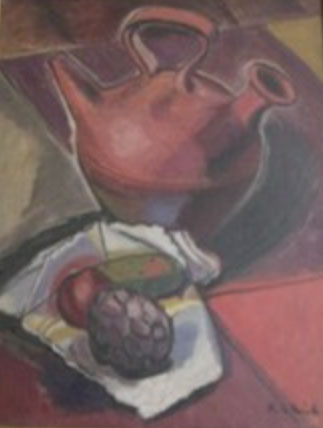
Justin O’Brien was a much-celebrated artist in 20th century Australia.
Prior to World War Two, O’Brien had an established career, teaching art and also as a finalist in the Archibald Prize (1937, 1938, 1939). In 1943 he was among a group of WW2 prisoners of war sent to Poland and Barcelona, returning to Australia in 1944. During captivity, O’Brien befriended fellow artists and upon his return to Australia he taught art at the Cranbrook School, Sydney. When O’Brien was awarded the inaugural Blake Prize for Religious Art in Sydney in 1951, he was formally recognized as one of Australia’s leading religious painters.
In 1948 O’Brien took a two-year sabbatical from his job as Master of Arts at Cranbrook School and proceeded to live overseas. He rented a flat in London and travelled in Spain, France, and Italy which informed the rich, vibrant colour palette of the 1949 work Mending of Nets. The narrative of this work is somewhat religious as well as depicting the simplicity of daily labour and leisure in a European coastal town in post-war times.
O’Brien is well represented in State institutions throughout Australia.

Justin O’Brien was a much-celebrated artist in 20th century Australia.
Prior to World War Two, O’Brien had an established career teaching art and also as a finalist in the Archibald Prize (1937, 1938, 1939). In 1943 he was among a group of WW2 prisoners of war sent to Poland and Barcelona, returning to Australia in 1944. During captivity, O’Brien befriended fellow artists and upon his return to Australia he taught art at the Cranbrook School, Sydney. When O’Brien was awarded the inaugural Blake Prize for Religious Art in Sydney in 1951, he was formally recognized as one of Australia’s leading religious painters.
In 1948 O’Brien took a two-year sabbatical from his job as Master of Arts at Cranbrook School and proceeded to live overseas. He rented a flat in London and travelled in Spain, France, and Italy where it can be assumed he studied Byzantine art, influencing The Miraculous Draught.
As noted by David Thomas: …the subject of the miraculous draught of fishes has long attracted artists from Medieval times through to the present. … These Gospel stories so appealed to Justin O’Brien that in 1978 he devoted half an exhibition to them. The Christian Gospels give us two stories of such miracles, the first relating to the calling of Saints Peter, James and John. The second comes after Christ’s resurrection. O’Brien painted both versions. In our painting, Christ is shown tall, standing in the boat as his disciples haul in their miraculous catch. In the left panel, two apostles stand by the shore, one gesturing to the extraordinary event taking place. The disciples become ‘fishers of men’, the boat an ancient symbol of the Christian Church, as over all towers the hieratic figure of Christ, clad in the red of majesty. The right hand panel has the curiosity of two devils on the other shore, introducing a touch of the Last Judgment through O’Brien’s creative imagination. In paintings of the Last Judgment, it was traditional to place the damned on Christ’s left.
O’Brien is well represented in State institutions throughout Australia.
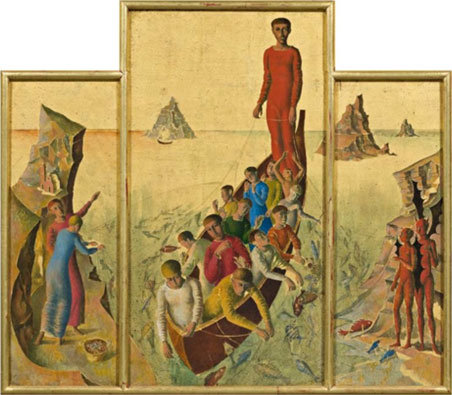
John Ogburn worked for three years as an industrial research chemist before turning away from a career in science and taking up art full-time. After his first one-man exhibition at the Macquarie Gallery in 1953, Ogburn sailed for Europe and studied in museums and galleries until his return in 1957. From there he conducted an art teaching studio in Sydney part-time while continuing to develop his painting.
For John Ogburn, the practice of still-life offers a complex appreciation for the beauty of everyday objects. The vibrant wallpaper and table laden with objects – classic still life figures of fruit, flowers and instrument – plays with depth and perspective. In a truly modernist style, Ogburn’s objects appear to be balancing on top of one another, not uniform or perfectly placed.
A leading 20th century American art critic, Clement Greenberg, who saw Ogburn’s work when visiting Sydney in 1979 recognised its inherent qualities and wrote, “John Ogburn has his own kind of newness, the kind that belongs to the truly ‘complete’ painter. There haven’t been all that many such.”
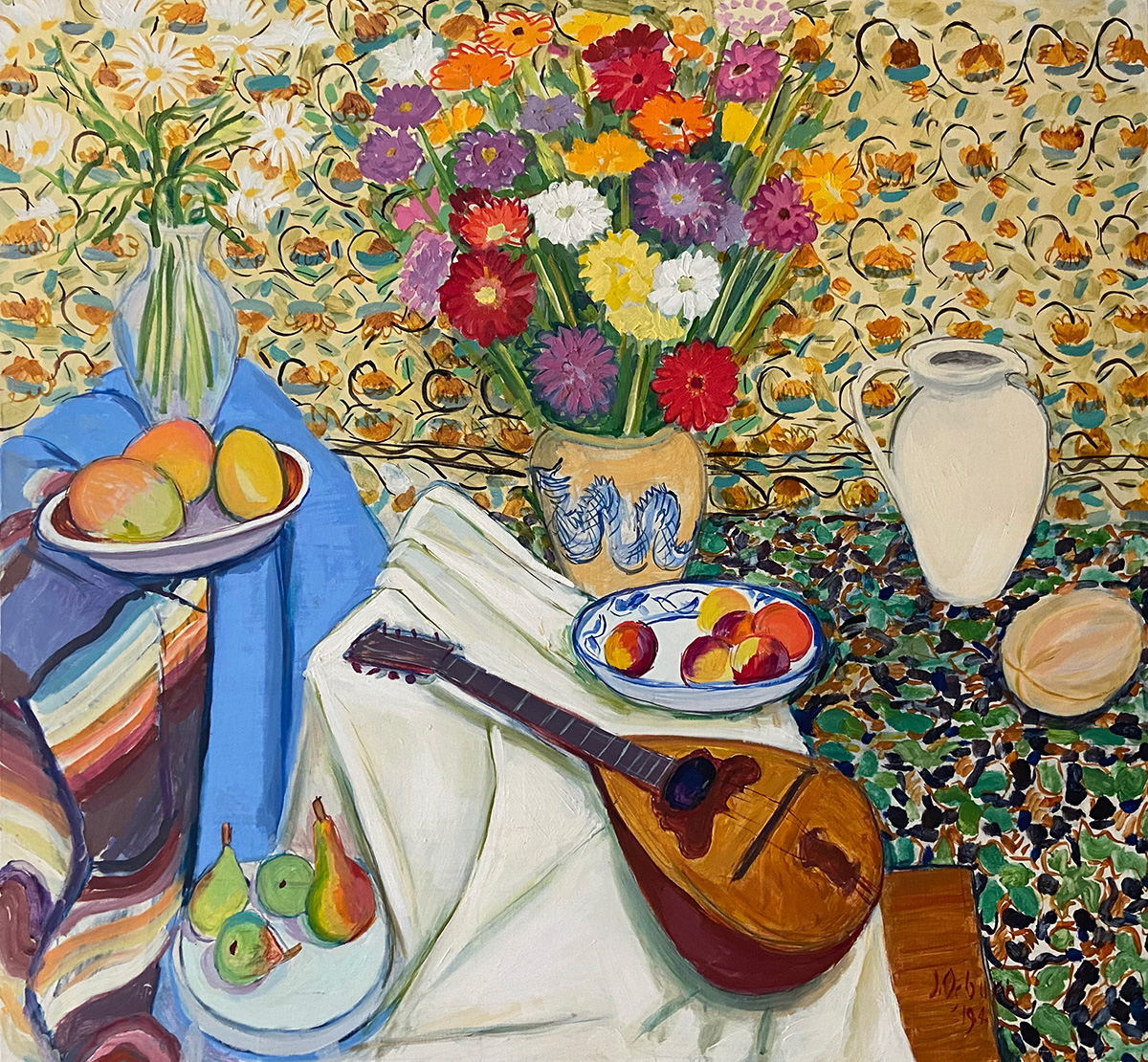
Growing up in an intellectual home environment on the Peking University campus, Chinese-Australian artist Lin Chunyan began exploring the language of art as a teenager. He first travelled to Australia as a visiting scholar to the University of Tasmania in 1989 and has lived in Australia for more than 10 years.
The painting Gum Tree and Bushfire is a detailed work that utilities definitive brushstrokes to create a feeling of a rich and crisp Aussie landscape. Blended into the scene is the depiction of a falling figure, adding a little surrealism, reminiscent of the early paintings of Arthur Boyd.
Dr Geoff Raby AO has stated, “Lin has been a prominent figure in the Beijing contemporary art scene for the past thirty years, but his relentlessly honest and individually expressive work has defied categorisation. He has stood apart from the main movements of the Beijing art scene. Refusing to be influenced by fashions of the day, he has continued to explore a highly personal emotional world through his painting.”
He has exhibited internationally, including in China, the USA, France, and a range of institutions in Australia, such as the 4A Centre for Contemporary Asian Art and QAGOMA.

Kudditji Kngwarreye was born around 1938 and comes from Boundary Bore in Utopia in Central Australia. He led a traditional lifestyle and upbringing in the Central Australian desert, learning his Dreamings and cultural responsibilities. As a young man he worked as a stockman, as did many Indigenous men who lived on or near pastoral leases in Central Australia. While not blood related, Kudditji was recognised as a skin brother of the late Emily Kame Kngwarreye (1910-1996).
During his younger days Kudditji frequently took the young boys/men of his community hunting emu in the desert, merging tradition with practice as part of their initiation as men. It is this experience that Kudditji painted his ‘Emu Dreaming’s’ and his ‘My Country’ works. The 2010 painting My Country references the Men’s Ceremonial Dreamings that connect Kudditji’s passion for the dreaming, teaching and his country. The painting features Kudditji’s famed style of coloured roundels and chequered blocks of colour that form the palette of the Australian landscape near Utopia.

Lloyd Rees was one of Australia’s most recognisable landscape painters working throughout the 20th century. He sought to build upon the legacy of the European landscape painting, taking inspiration from artists such as Jean-Baptiste-Camille Corot and J.M.W Turner – especially in relation to light and the contours of the land.
Throughout his career the Sydney Harbour foreshore and suburbs would provide one of the greatest and most enduring sources of inspiration for the artist. In the later years of Rees’ career, his practice was preoccupied with the study of light and depth, demonstrated in Looking East. In his later years, Rees moved from realism and draughtsmanship to create visionary paintings full of luminosity. Rees stated that, ‘if there is one thing I want it is for my paintings to be light right through.’ Referring to the Impressionists and the fresco painters of Italy, Rees noted his canvases had ‘the sense of the painting being on a light background.’ Adding, ‘this is what I am trying to do here, to make the lightness of the canvas the dominating thing.’ Rees was eighty-three when he painted Looking East, making it a work that not only was reflective of his late career stylistically but exemplifies his ability to capture the magical qualities of light and land throughout the later years of his life.
Lloyd Rees is held in the collections of all major Australian galleries. He was also a two-time winner of the Wynne prize in 1950 and 1982.
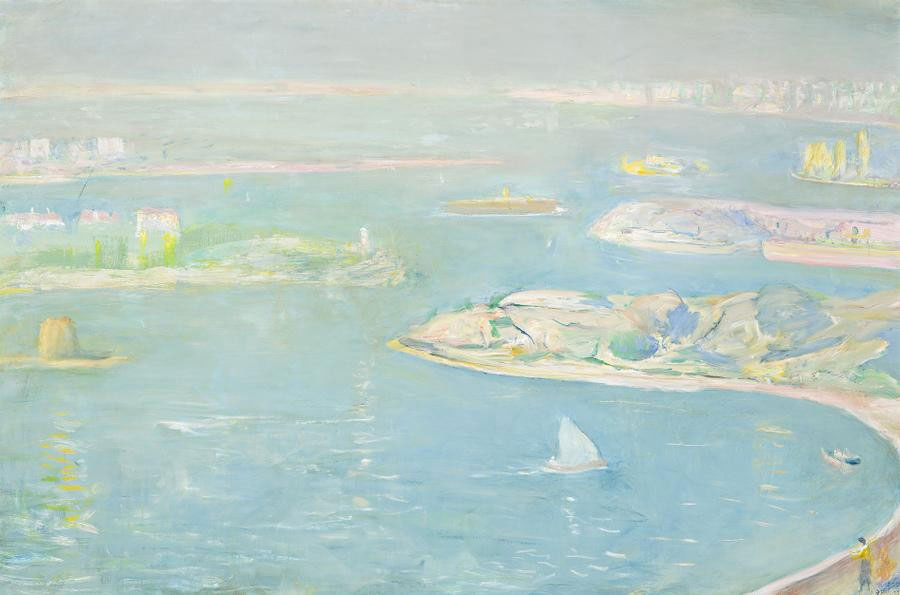
Brett Whiteley was at the forefront of Australian visual arts in the 20th century, establishing himself as one of the most influential and important painters whose work related to both the urban and natural worlds.
Birds were a driving force behind Brett Whiteley’s imagination and his love of the natural world. Herons, wrens, rosellas, owls and doves figure prominently as subjects for his major works. Orange Fruit Dove, Fiji 1969 is a fine example of Whiteley’s bird paintings which capture not only his love for fauna but demonstrate his iconic painterly (with collage) style as well. Whiteley considered the Orange Fruit Dove the most beautiful in the world. In the same year that Orange Fruit Dove was painted, Whiteley also completed his anti-war opus, The American Dream, produced in New York, which includes birds as observers to the debauchery of modern life. Culturally, doves represent love, devotion and care for the family in early Greek and Roman society. For Whiteley, birds symbolise a sense of hopefulness in the modern world.
His work is represented in the collections of all Australian State galleries. In 1978 Brett Whiteley became the first artist to win all three major Australian art prizes – Archibald, Wynne and Sulman – in the same year. He is held in the collections of many international institutions including the Tate, London.
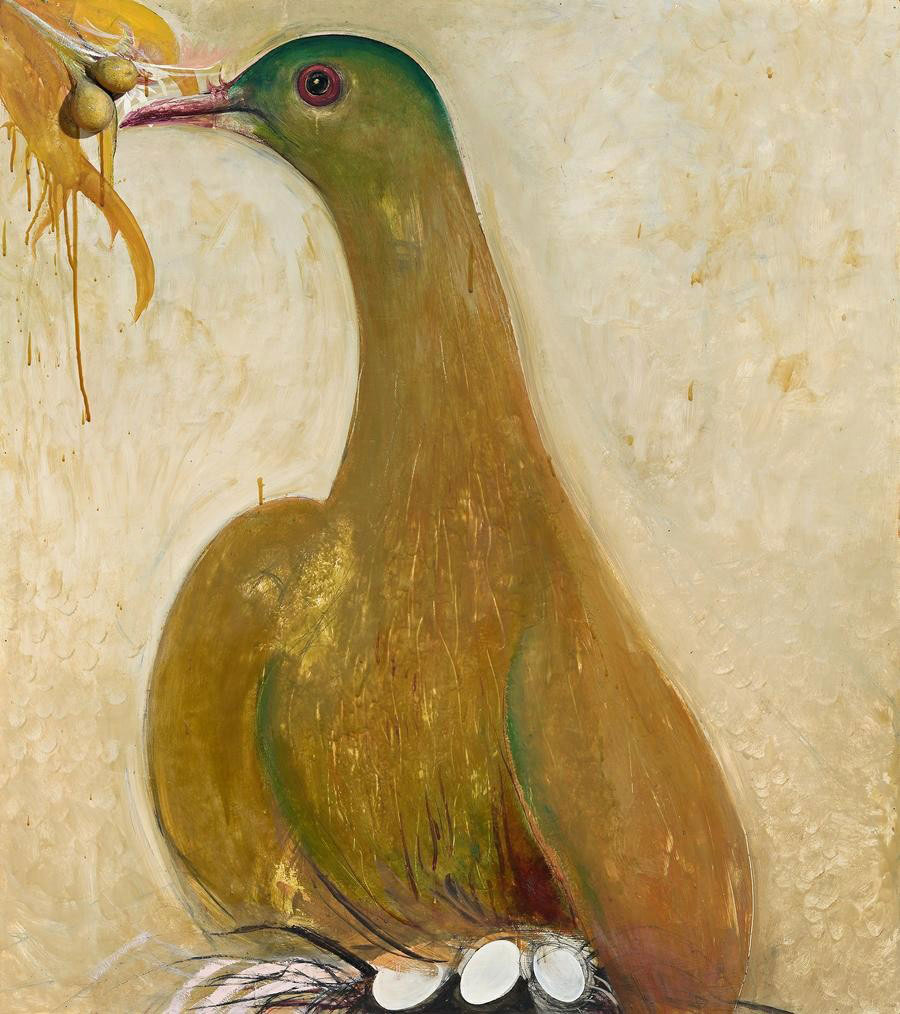
Patrick Mung Mung was born at Spring Creek and as an adult worked as a stockman on Texas Downs Station and nearby stations in the East Kimberley, Western Australia. He started painting in 1991 and was instrumental in establishing the artist-and-community-owned art centre at Warmun in 1998.
The artist’s work is influenced by the generation of Warmun artists who preceded him but his depiction of Purnululu in pastel coloured ochres is distinctly his own. The 2007 painting Purnulula is a landscape painting of Purnululu National Park in the Kimberley. The landscape contains rows of mounded rock formations, all unique throughout the vast national park. Stylistically, there is a common practice with Queenie McKenzie and Rover Thomas through the soft rounded forms and the perspective layering of mounds and hills and rocks.
In 2012, Mung Mung was awarded the Bank West Contemporary Art Prize. His work is held in a number of major Australian institutions including the Art Gallery of NSW, Art Gallery of Western Australia and the National Gallery of Australia, Canberra.
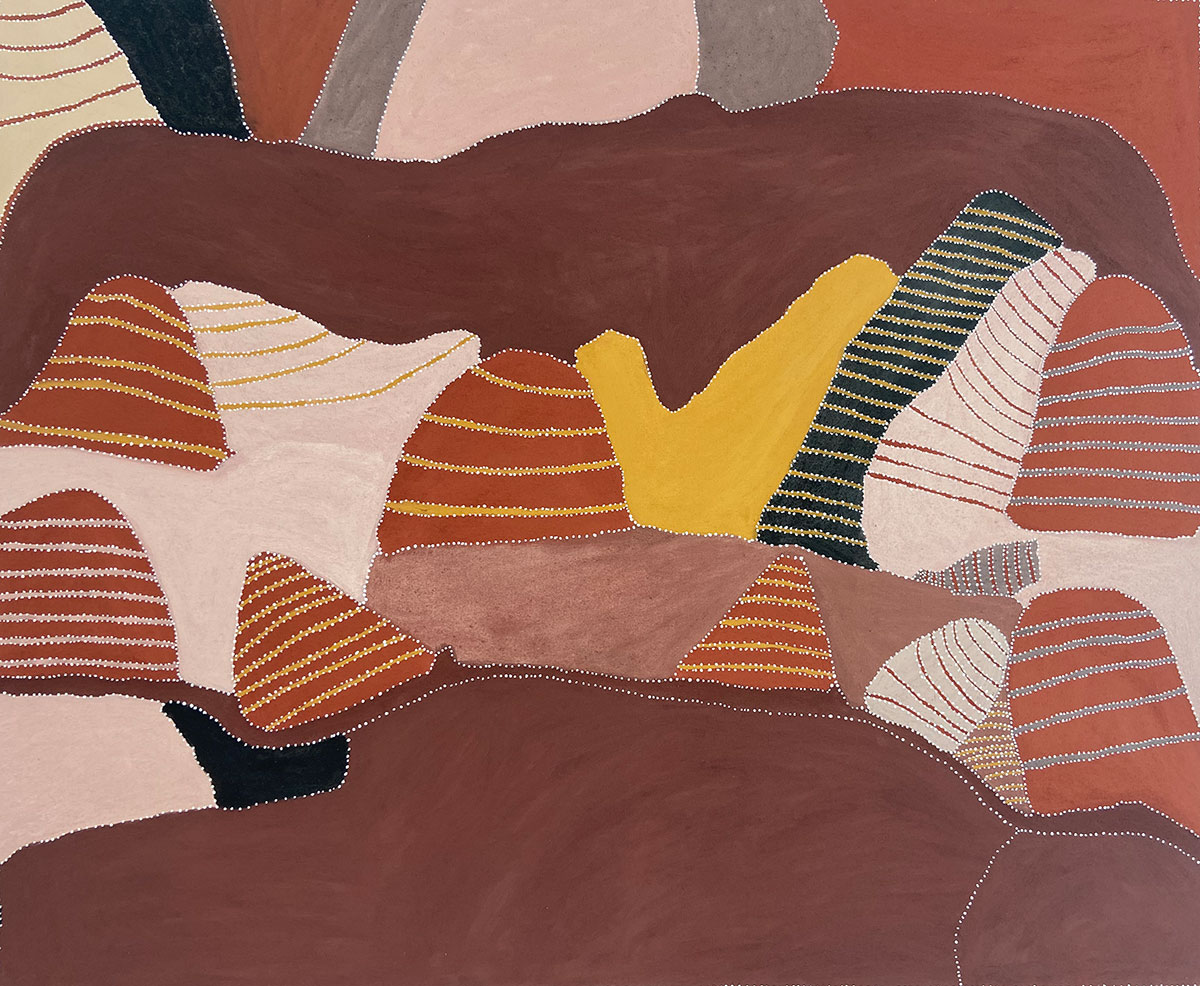
Rover Thomas was born at Gunawaggi near Well 33 on the Canning Stock Route in the Great Sandy Desert of Western Australia. As with many contemporary Aboriginal artists, Rover Thomas started to paint quite late in his life, only being introduced to the practice in the early 1980s.
From the age of ten until he settled at the Indigenous community Warmun near Turkey Creek, Rover Thomas grew up moving with his family to various pastoral stations. As an adult he worked as a stockman in the Kimberley and the Northern Territory. Thomas’ 1996 painting 41 to 42 Well, outlines the Canning cattle stock route between ‘41’ and ‘42’ water wells in the Northern desert of Western Australia. Thomas’ life experiences of movement through country are displayed here through dots and brush strokes in deep, rich red and brown ochre. The painting is displayed from a bird’s eye view, offering an artistic and personal rendition of an outback map.
Thomas’ work is held in all major Australian museums. The National Museum of Australia, Canberra recently acquired a major work by Thomas in 2022.
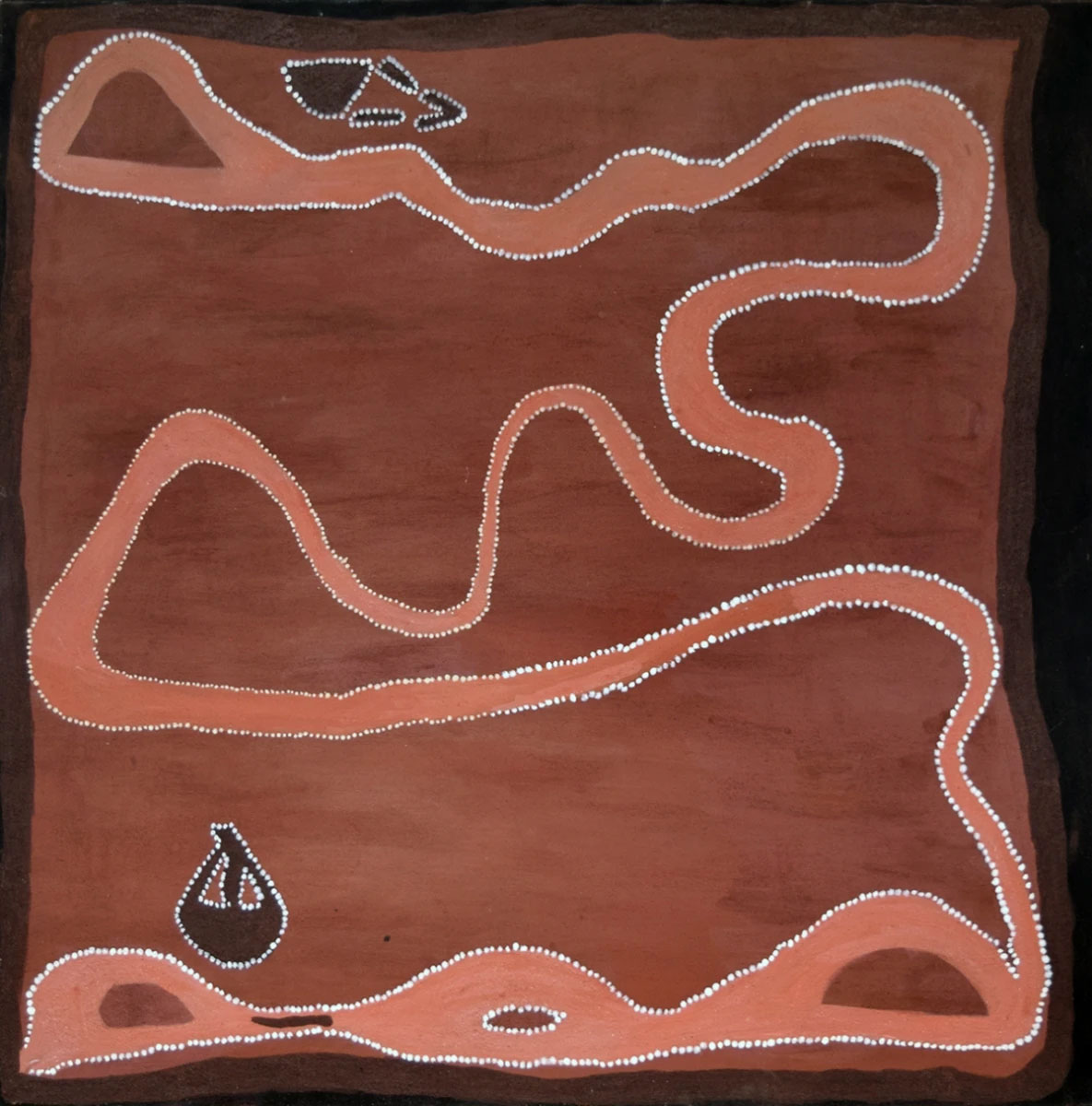
Robert Juniper enjoyed a widely successful and prolific career for his evocative depictions of the West Australian landscape.
The 1988 painting Homeward Bound is a key work in Juniper’s career which reflects on his visit to Broome in 1985. Set amidst a field of blues, pinks and browns, a group of horses and their riders descend on a lonely destination occupied by a tall figure and his dogs. This tall figure is reportedly a reflection of the artist himself, who was always identifiable by his distinctive broad hat.
Regarding his approach to painting, Juniper noted, ‘I like my landscapes to look as though they have been exposed to time and the elements like the landscapes they are derived from, hence my use of natural ochres, mineral sands, graphite, etc.’
He is held in a number of important Australian public institutions and permanent collections including the Art Gallery of Western Australia and the Art Gallery of NSW. In 1998, Robert Juniper was presented with a State Living Treasures Award by the Ministry for Culture and the Arts in Western Australia.
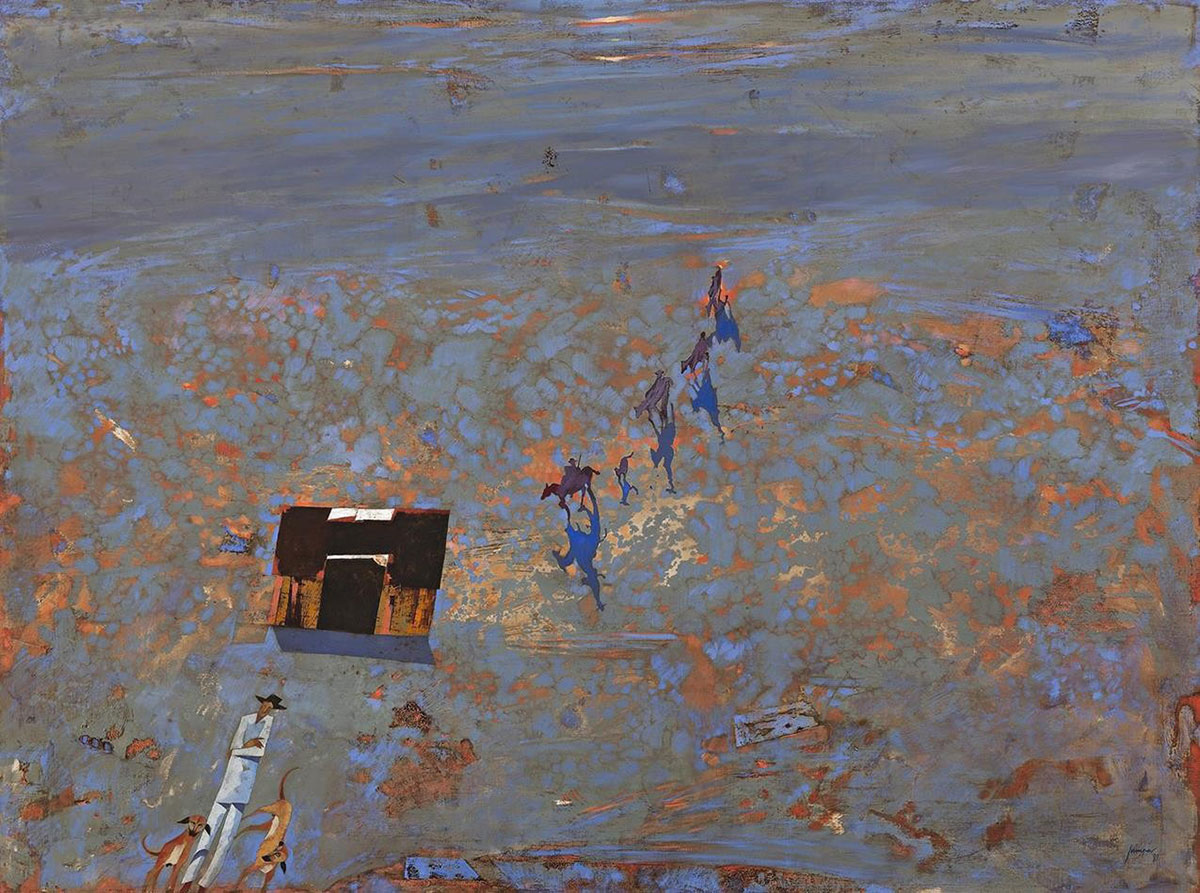
Howard Arkley is widely recognised as one of the foremost painters of Australian suburbia. He rejected the landscape tradition, celebrating instead the ubiquity of images embedded in urban and suburban environments with his vibrant airbrushed paintings.
Suburban motifs, patterns and textures offered Arkley endless possibilities for semi-abstract compositions which he used to blur the distinctions between High Art and Pop culture by referencing both art history and the everyday experience. The 1987 work Suburban Landscape is a unique collaboration between the artist and his partner at the time, Christine Johnson. Johnson contributed the freely painted garden, man and dog while Arkley added the window frame and polka dot curtains, using his characteristic flat comic-book colour and black sprayed line-work.
Arkley’s work is held in a number of private, public and university collections within Australia including the Art Gallery of New South Wales, Sydney, the National Gallery of Australia, Canberra and National Gallery of Victoria, Melbourne. Arkley also represented Australia internationally at the 48th Venice Biennale in 1999.

John Olsen was one of Australia’s most influential artists, whose impact is still widely felt across the country.
The painting Untitled, 2018 tracks the movement of water, rivers and streams pouring into a deep body of water. In Olsen’s recognisable style, the perspective has been altered to make the viewer feel as if they are looking at the land underneath, above and straight on. Olsen establishes this lens to give a unique and all-encompassing view of the landscape. Classic ‘Olsen’ details such as the flying bird and the rough pale green canopy of eucalyptus trees dots the scene as the water meanders through the land. The work feels like a painted drawing, giving the illusion that it has been created at speed – capturing a moment in time.
John Olsen won the Wynne Prize in 1969 and 1985, the Sulman Prize in 1989 and the Archibald Prize in 2005. In 2001 he was made an Officer in the Order of Australia (AO), in 1977 was awarded the O.B.E. for services to the Arts and in 1993 he was awarded an Australian Creative Fellowship. Olsen has 131 works held in the permanent collection of the Art Gallery of New South Wales alone. He is held in all major Australian art galleries.
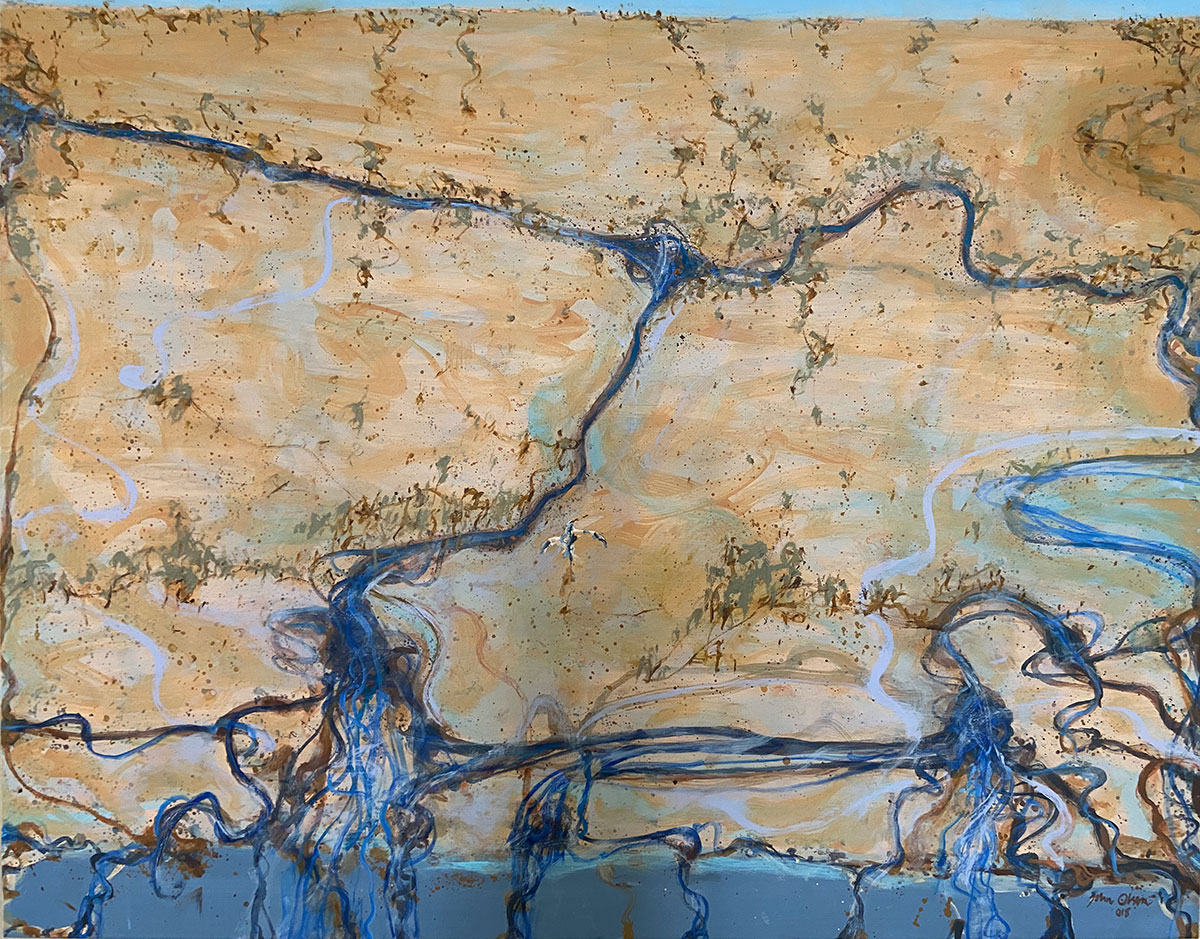
John Olsen was one of Australia’s greatest artists, who was an immensely influential figure throughout the nation’s 20th century artistic development. Through his ability to tether the abstracted and fluid movements of his paintbrush to the rich and changing imagery of the Australian identity, Olsen has perfectly captured the personality of the country in a timeless fashion.
Throughout his career John Olsen developed a love affair with the Spanish dish paella, completing at least 20 watercolours and 5 major oil paintings that featured the dish. The 1978 painting, Sun and Paella is one of those 5. Tim Olsen, John’s son, stated that “Paella is a derivative of the sun, which is a source of energy, when we eat, we eat the sun’s energy. Food provides an aesthetic which he applies to his work. He uses his cooking dexterity in his work, drizzling watercolour the way you drizzle olive oil.”
Food journalist Sheridan Rogers visited John Olsen in his home as he was cooking Paella. At a point in the day the artist exclaimed, “It’s my post-modern installation, the colour of the Spanish flag – orange, yellow and red.”
Throughout his career Olsen has won the Wynne Prize in 1969 and 1985, the Sulman Prize in 1989 and the Archibald Prize in 2005, among many other awards throughout his long career. In 2001 he was further made an Officer in the Order of Australia (AO), in 1977 was awarded the O.B.E. for services to the Arts and in 1993 he was awarded an Australian Creative Fellowship. Olsen has 131 works held in the permanent collection of the Art Gallery of New South Wales alone. His work is held in all major State galleries.
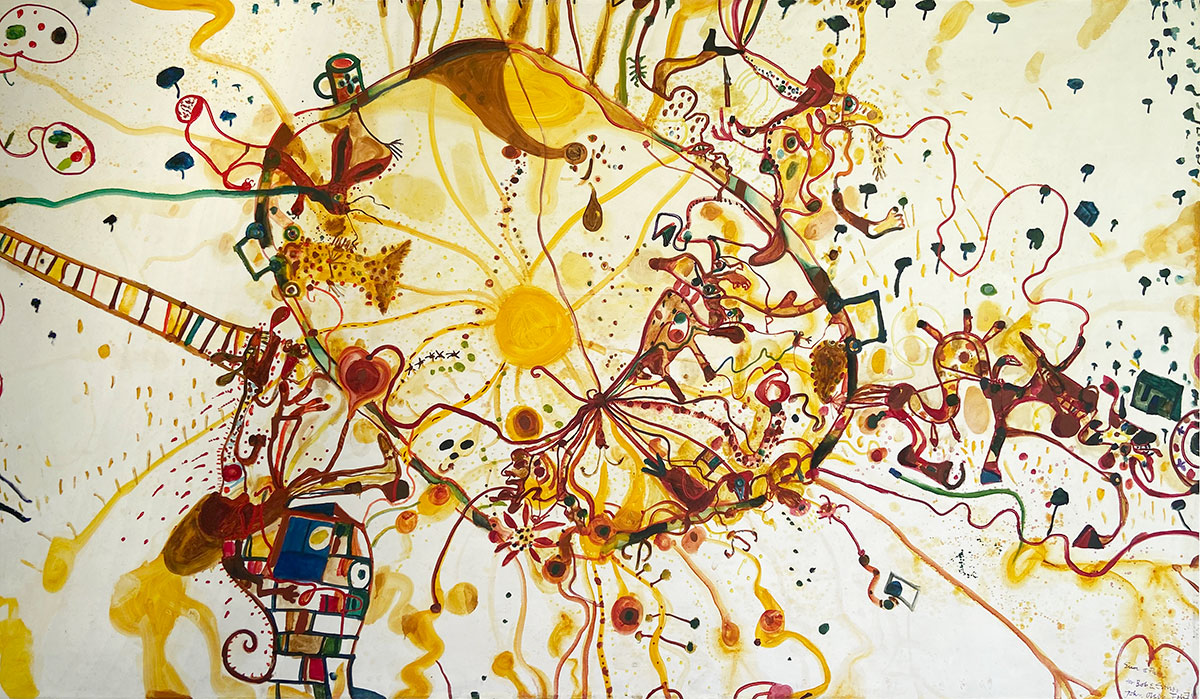
Kudditji Kngwarreye was born around 1938 and comes from Boundary Bore in Utopia in Central Australia. He led a traditional lifestyle and upbringing in the Central Australian desert, learning his Dreamings and cultural responsibilities. As a young man he worked as a stockman as did many Indigenous men who lived on or near pastoral leases in Central Australia. While not blood related, Kudditji was recognised as a skin brother of the late Emily Kame Kngwarreye (1910-1996).
During his younger days Kudditji frequently took the young boys/men of his community hunting emu in these lands, merging tradition with practice as part of their initiation as men. It is the land of this experience that Kudditji painted his ‘Emu Dreamings’ and his ‘My Country’ works. The painting Untitled (My Country) explores Kngwarreye’s rich understanding of the Australian landscape, elevated through his iconic and bold blocks of colour. The brushstrokes and lines that make up the work are imperfect, raw and immediate. The work is a representation of Country that the artist knows so well.
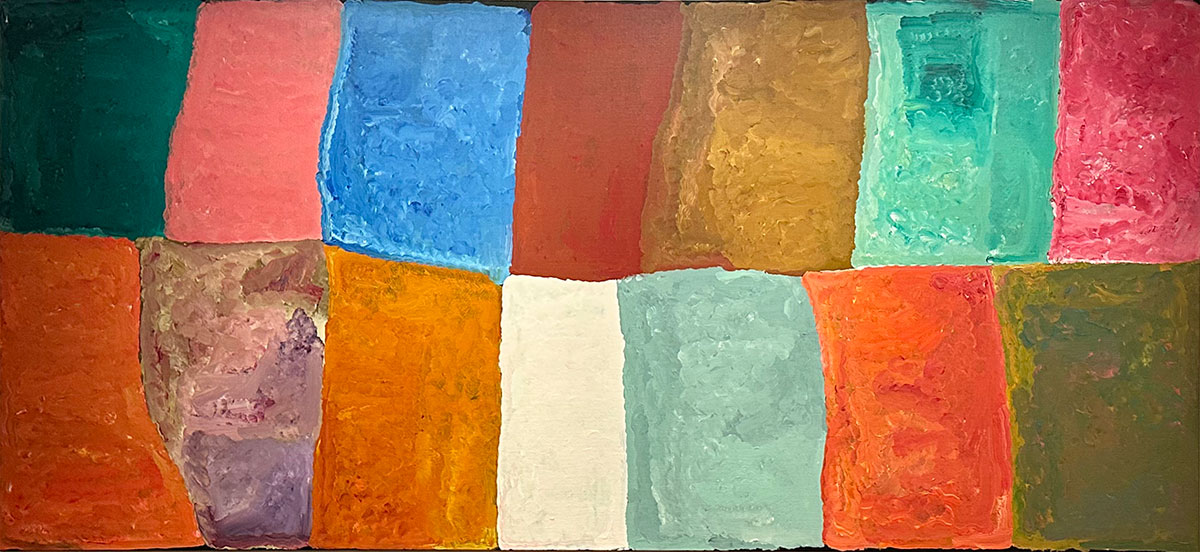
Emily Kame Kngwarreye is one of Australia’s most internationally recognised and significant contemporary artists.
The 1996 canvas Annoralya Awelye is a linear statement derived from the body paint worn by women in ceremony. Such applications of red, yellow, white and blue exude great gestural confidence. These lines also link to the random growth pattern of the Anooralya yam plant. This plant produces a long thin tuber that matures as the parent plant on the earth’s surface is in decline. One important sign of the plant’s maturity, is a crack, or cracks, in the soil’s surface. This indicates where to dig for the yam tuber. The plant’s flower called “Kame” contains seeds that can be prepared as a seed cake. Such a resourceful plant was considered very important in traditional lifestyle conditions, and for Kngwarreye, is her main custodial responsibility.
Ceremony (awelye), is an affirmation of the spiritual power of the people of the desert. Emily Kngwarreye believes that ritual procedure ensures the continuing life cycle of this desert life form, and that her knowledge is fundamental to this.
In 1992 Emily Kngwarreye travelled to Canberra to receive an Australian Artists Creative Fellowship from the Prime Minister Paul Keating, the first time an Indigenous Australian artist had received the prestigious award. In 1997, she represented Australia posthumously at the Venice Biennale and in the same year the Queensland Art Gallery staged a major retrospective of her work that travelled throughout Australia – the first retrospective of an Aboriginal artist to tour nationally. Her work is held in all major Australian art museums.

Emily Kame Kngwarreye is one of Australia’s most internationally recognised and significant contemporary artists.
The transformation of the desert after a heavy, tropical summer rain has a different colour and mood than the less frequent winter showers. In the painting Alalgura Country, 1991, Kngwarreye works alludes to a wondrously abundant summer season. The painting is thought to depict the stage of the bush foods’ life cycle where the ripe fruit and seeds are in the process of drying.
In ceremony, the life cycles of those bush sucker species (for which the artist has custodial responsibility) are sung about. So too are the stories of past ancestors and their actions that determined the social codes that are the basis for the nurturing role of women. Of paramount importance is the necessity to pass on knowledge to the younger generation and to develop the spiritual belief that fertility and hardiness are encouraged by ceremony.
In 1992 Emily Kngwarreye travelled to Canberra to receive an Australian Artists Creative Fellowship from the Prime Minister Paul Keating, the first time an Indigenous Australian artist had received the prestigious award. In 1997, she represented Australia posthumously at the Venice Biennale and in the same year the Queensland Art Gallery staged a major retrospective of her work that travelled throughout Australia – the first retrospective of an Aboriginal artist to tour nationally. Her work is held in all major Australian art museums.
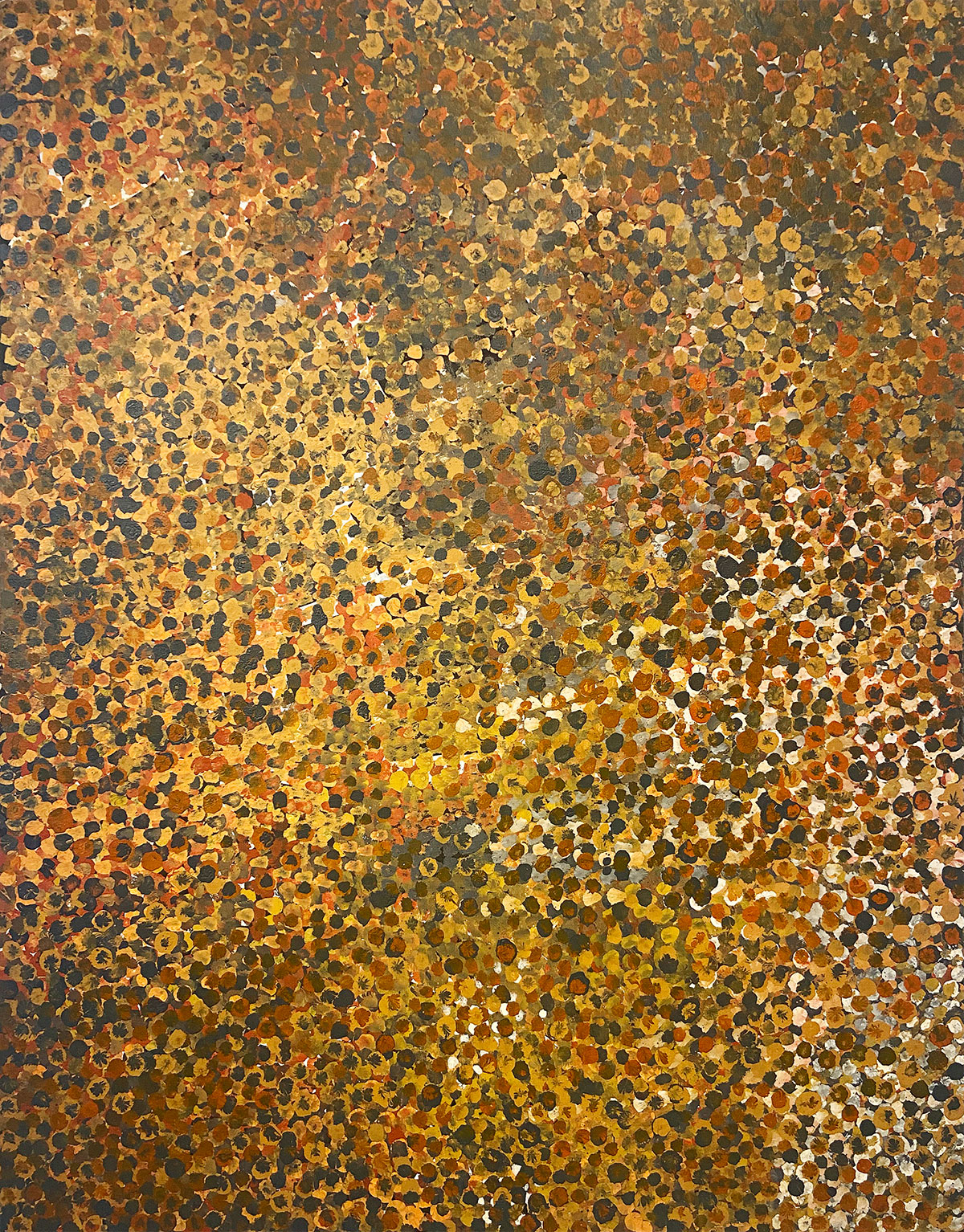
Emily Kame Kngwarreye is one of Australia’s most internationally recognised and significant contemporary artists.
The 1994 painting Abundance represents a colourful, plentiful scene of desert flora. The most important tone is yellow, which signifies the daisy of the Anooralya Yam mythology that is central to Emily Kngwarreye’s custodial responsibilities for her country on Utopia Station.
Emily Kngwarreye was known to complete a canvas in one session. Her main story of the Anooralya Yam Dreaming is applied onto a prepared black canvas. The story is viewed as a collection of lines that define the mythology. She then works in a seemingly unregulated way over the canvas, usually covering completely the lines of her story. Often, she concentrates on one area and occasionally allows a spontaneous burst of movement over the remaining canvas.
In 1992 Emily Kngwarreye travelled to Canberra to receive an Australian Artists Creative Fellowship from the Prime Minister Paul Keating, the first time an Indigenous Australian artist had received the prestigious award. In 1997, she represented Australia posthumously at the Venice Biennale and in the same year the Queensland Art Gallery staged a major retrospective of her work that travelled throughout Australia – the first retrospective of an Aboriginal artist to tour nationally. Her work is held in all major Australian art museums.
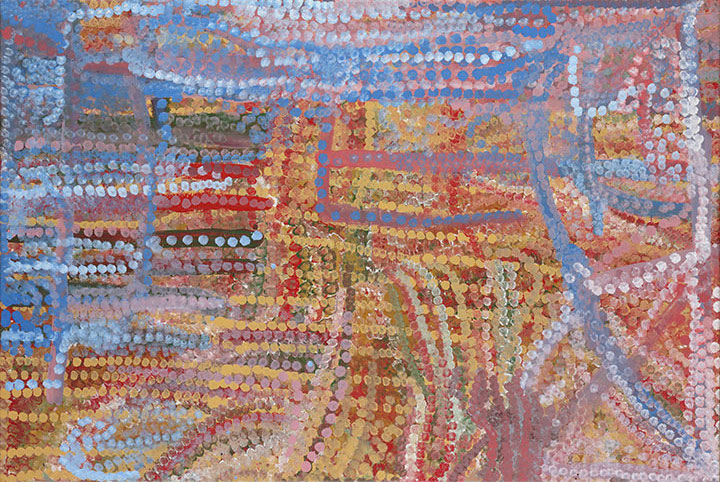
Emily Kame Kngwarreye is one of Australia’s most internationally recognised and significant contemporary artists.
Emily Kame Kngwarreye moves with confident resolve after the excitement and satisfaction of an abundant season. In the 1994 painting Radiance of Country, the artist strikes out with a lineal dotted form as an expression of the current tonal mix of bush food life cycles where the ripe fruit and seeds start the process of drying. Grass seeds fall, scatter and cluster in sweeping swathes with the changing the radiance of country. Intermingling with the fruit and seeds are the paling leaves and flowers of the season, and the red Kame seed held in the head of the Atnulare (Anooralya) Yam daisy that draws the Emus to her country Alhakere (Alalgura) to grace and raise their young chicks.
There is an exuberant energy coming through this work: the colour, particularly the red and yellow, colliding and issuing from the central area of this canvas, creates an exceptional painting, responding to a most favourable ceremonial and weather season.
In 1992 Emily Kngwarreye travelled to Canberra to receive an Australian Artists Creative Fellowship from the Prime Minister Paul Keating, the first time an Indigenous Australian artist had received the prestigious award. In 1997, she represented Australia posthumously at the Venice Biennale and in the same year the Queensland Art Gallery staged a major retrospective of her work that travelled throughout Australia – the first retrospective of an Aboriginal artist to tour nationally. Her work is held in all major Australian art museums.

Emily Kame Kngwarreye is one of Australia’s most internationally recognised and significant contemporary artists.
It is often an important and historical ceremony that is triggered by nature and/or timing of the season that provokes Emily Kngwarreye’s memory and lasting emotions. In the case of the 1993 Post-Summer Profusion, Kngwarreye has painted following summer rains that are accompanied by the annual ceremonial season. The green, pink and yellow show the lush growth and ripeness of all foods.
Kngwarreye believes that through ceremony (awelye) and her belief in the power of the desert, she can help provoke the desert’s hidden energy into a new and bountiful season, and consequent crop of bush tucker. The lineal impressions from the large-brushed dot-work gives an aerial overview of the landscape of the artist’s country. The young women who inherit custodial responsibility for the desert foods learn moral and social codes through the stories of their ancestors. Providing these codes are followed, and fortune has it, these girls will raise a family and symbolise the fertile and tough nature of the desert and of all its living species.
In 1992 Emily Kngwarreye travelled to Canberra to receive an Australian Artists Creative Fellowship from the Prime Minister Paul Keating, the first time an Indigenous Australian artist had received the prestigious award. In 1997, she represented Australia posthumously at the Venice Biennale and in the same year the Queensland Art Gallery staged a major retrospective of her work that travelled throughout Australia – the first retrospective of an Aboriginal artist to tour nationally. Her work is held in all major Australian art museums.
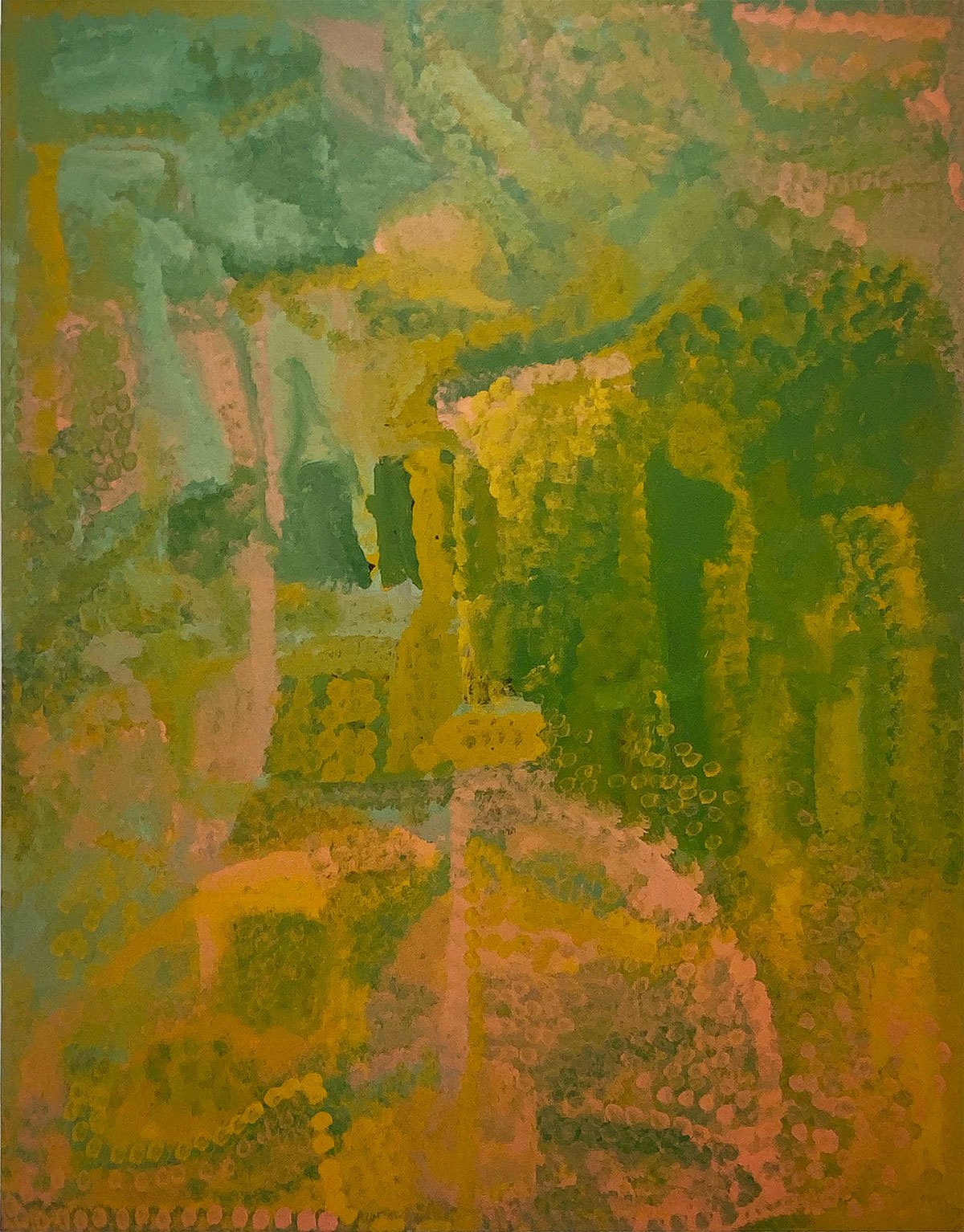
Emily Kame Kngwarreye is one of Australia’s most internationally recognised and significant contemporary artists.
The pale-coloured lines in the 1996 painting Anooralya Awelye II relate to the random growth pattern of the Anooralya yam. This plant produces a long thin tuber that matures as the parent plant on the earth’s surface is in decline. One important sign of the plant’s maturity, is a crack, or cracks, in the soil’s surface. This indicates where to dig for the yam tuber. As well, the lines link in with the ritual of body painting during “awelye,” or ceremonial proceedings. Kngwarreye’s previous work shows them underscoring her demonstrations of brilliance with colour.
Not only did the lines give structure to these works, but make a fundamental statement of their ceremonial validity, particularly when red, yellow and white, are the main colours employed in the yam ceremony. Emily Kngwarreye believes that such ritual ensures the continuing life cycle of this and other desert life forms, and that her knowledge is intrinsic to this. Her return to this gestural form is a statement of what to her is of greatest importance.
In 1992 Emily Kngwarreye travelled to Canberra to receive an Australian Artists Creative Fellowship from the Prime Minister Paul Keating, the first time an Indigenous Australian artist had received the prestigious award. In 1997, she represented Australia posthumously at the Venice Biennale and in the same year the Queensland Art Gallery staged a major retrospective of her work that travelled throughout Australia – the first retrospective of an Aboriginal artist to tour nationally. Her work is held in all major Australian art museums.

Emily Kame Kngwarreye is one of Australia’s most internationally recognised and significant contemporary artists.
The 1995 painting Annoralya Awelye is a linear statement derived from the body paint worn by women in ceremony. Such loose and busy applications of white on black exudes great gestural confidence. These lines also link to the random growth pattern of the Anooralya yam plant. This plant produces a long thin tuber that matures as the parent plant on the earth’s surface is in decline. One important sign of the plant’s maturity, is a crack, or cracks, in the soil’s surface. This indicates where to dig for the yam tuber. The plant’s flower called “Kame,” contains seeds that can be prepared as a seed cake. Such a resourceful plant was considered very important in traditional lifestyle conditions and, for Kngwarreye, is her main custodial responsibility.
Ceremony (awelye), is an affirmation of the spiritual power of the people of the desert. Emily Kngwarreye believes that ritual procedure ensures the continuing life cycle of this desert life form, and that her knowledge is fundamental to this.
In 1992 Emily Kngwarreye travelled to Canberra to receive an Australian Artists Creative Fellowship from the Prime Minister Paul Keating, the first time an Indigenous Australian artist had received the prestigious award. In 1997, she represented Australia posthumously at the Venice Biennale and in the same year the Queensland Art Gallery staged a major retrospective of her work that travelled throughout Australia – the first retrospective of an Aboriginal artist to tour nationally. Her work is held in all major Australian art museums.

Yvonne Audette is one of Australia’s most accomplished and internationally recognised abstract artists.
In 1955 Audette travelled to Europe, establishing a studio in Florence and later, Milan, where she lived and worked, presenting numerous successful exhibitions before returning to Australia in 1966. The 1967 work The Jugglers is a response to the artist’s re-introduction to Australia’s intense, shimmering light after returning from Italy. Using a dramatic palette of bold pinks and blues, the work could be considered an abstracted study of the Australian landscape. While the calligraphic marks of earlier paintings remain, they are joined here with a loose community of circles, squares and interlinked hoops that dance across the work’s light and airy surface.
The work’s physicality results from Audette’s use of a technique she adopted from Willem de Kooning after studying at the New York Academy of Design in 1952, where she would drop cut shapes onto a work as a way to discover new motifs. Audette once explained that “over many years, collage has allowed my imagination to take wings and free me from habit-forming patterns of the mind and spirit. A new range of visual associations could always be discovered and a new range of spatial and surface tensions experienced.”
Her work is held in a number of Australian institutions including the National Gallery of Victoria, Melbourne and the National Gallery of Australia, Canberra.

George Haynes was born in Kenya in 1938 and moved to Western Australia in 1962, after studying at the Chelsea School of Art, London.
Haynes’ paintings are characteristically drenched in colour and are a keen observation of everyday Australian life and especially its landscape. The artist is a master of light, creating harmonious paintings of colour, tone, and temperature with a flair for movement and composition. High Tide is a classic work depicting the incoming ripples of the ocean with a tropical colouration. Pale greens and blues fill the canvas as the water is lapping at the rough, rocky shore. Although this painting isn’t large in scale it feels expansive in experience.
Renowned Western Australian ceramicist once stated, “at the heart of George’s paintings and drawings is an unworldly beauty. Not prettiness, not cuteness, but a deep and profound beauty – lyrical, elegant, and emotionally restrained.”
George Haynes is held in all major Australian galleries, The White House Collection, USA and the University of Texas, USA.

Mabel Juli is renowned for her refined, minimal depictions of Garnkiny doo Wardel (Moon and Star), an important Ngarranggarni (Dreaming) story that explores forbidden love, kinship and the origins of our mortality.
Painted in rich, deep ochre, the painting Garnkiny Ngarranggarni, Moon Dreaming tells the story of the Moon and Star dreaming that was central to Juli’s artistic practice and community.
In the artist’s words, “this the dream by Wardel and Garnkiny (star and moon). That’s what my mother and dad told me about that Dream. The moon sits in the east. The star sits on top of the hills, the moon came and climbed that hill. That moon loved his mother in-law, but they told him he couldn’t love her and to go away. He led with shame and climbed up the hill and he was looking from on top [of the hill]. He told all the people that they were going to die. He said that he would be the only one living. He cursed those people that he would be the only one coming back alive. He told them, while they were sitting down, ‘you are all going to die and I will be still alive, coming out. Every three days I will rise from the dead.’ They all died and he was the only one that stayed alive. He came back as the moon, for three days every month.”
Juli’s work is held all across Australia at such institutions as the Art Gallery of South Australia, Adelaide; National Gallery of Victoria, Melbourne and the Art Gallery of NSW, Sydney. Juli is also in the collection of Tate, UK.

Mabel Juli is renowned for her refined black and white depiction of Garnkiny doo Wardel (Moon and Star), an important Ngarranggarni (Dreaming) story that explores forbidden love, kinship and the origins of our mortality.
The painting Garn’giny Ngarranggarni illustrates the dreamtime story of Wardal and Garn’giny (star and moon). “That’s what my mother and dad told me about that Dreamtime thing, ‘the moon sits in the east. The star sits on top of the hills. The moon went and climbed that hill. They made him run away because he loved his mother-inlaw. (That moon loved his mother in-law, but they told him he couldn’t love her and to go away). He felt shame (and climbed up the hill). He was looking from on top [of the hill]. He told all the people, ‘you will all die.’ He told them ‘I will be the only one living.’ I will keep coming back,’ he told them all while they were sitting down below. ‘You are all going to die and I will be still alive, coming out. After three days camp I will rise from the dead.’ They all died and he was the only one that stayed alive. He camps (sleeps – dies) for three days then appears (again as the moon), after three days.”
Juli’s work is held all across Australia at such institutions as the Art Gallery of South Australia, Adelaide; National Gallery of Victoria, Melbourne and the Art Gallery of NSW, Sydney. Juli is also in the collection of Tate, UK.

Nathan Beard is a Western Australian-based interdisciplinary artist whose work is primarily engaged with exploring the myriad influences of his Thai-Australian cultural background.
The 2022 sculptures Tropical Bounty II and III are from the series Low Yield Fruit, a body of sculptural work inspired by the complex personal, cultural and colonial histories attached to the tropical fruits of Thailand. The sculptures explore the unique experience of considering one’s identity and memory through food. Beard’s work dissects the potency of the fruit export industry to Thailand’s economy, memories of the artists’ childhood and his mother’s careful search for exotic fruit in Australia.
The replicas of fruits from durians and mangosteens to jackfruits are placed on top of rigid steel frames alongside limes harvested from his mother’s garden and details of hands and heads from family Buddhist shrine statues. These totem-like forms conflate the meaningful nature of both personal and cultural artefacts.
Beards’ work has been shown in a number of Australian institutions including the Perth Institute of Contemporary Arts, the Art Gallery of Western Australia and Fremantle Arts Centre.
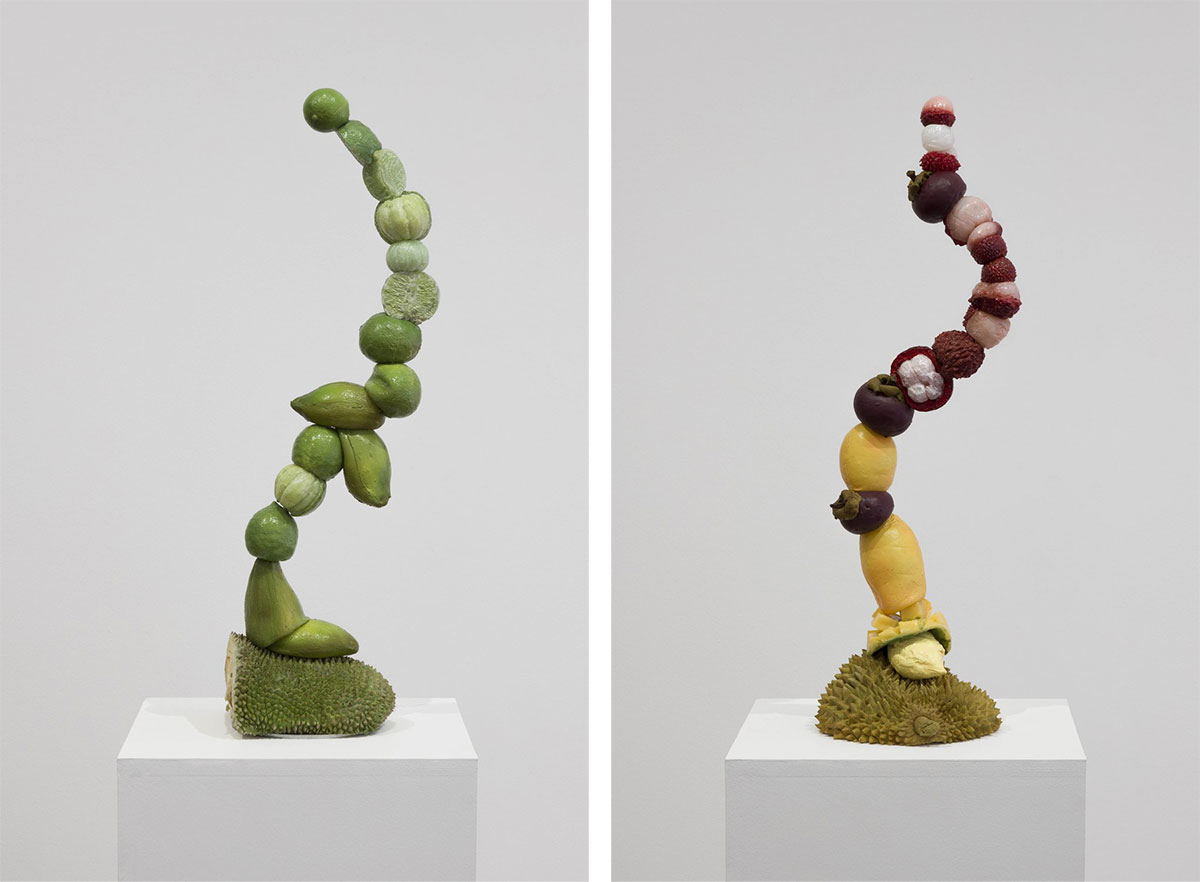
Rosalie Gascoigne is renowned for her sculptural assemblages that use natural and manufactured objects to explore the lyrical beauty of the Monaro region of New South Wales. Her work radically reformulated the ways in which the Australian landscape is perceived.
Rosalie Gascoigne’s art was deeply informed by the geographic features of her Australian homeland. Lasseter’s Reef is amongst a handful of works within Gascoigne’s oeuvre that directly reference their own retro-reflective surface, honouring the creative and poetic potential that was concealed in their original function as road-signs. The title that was applied to the final product refers to a vast mythical quartz and gold vein that Harold Bell Lasseter claimed to have found in Central Australia in 1897, before perishing on a subsequent prospecting expedition to the area in 1930. His story persisted as a famous Australian folktale throughout the mid twentieth century. This planar assemblage is almost entirely abstract, founded on the rhythm and order of a tessellated Modernist grid. The rigour of this arrangement is disrupted by the irregularities of the artist’s found materials. The variations in the wear and tear of each fragment of signage produce a dappled monochromatic surface that pays homage to the element on which Australia built its wealth, while also being “a warning and a promise, that is, of man’s ability to degrade the land and to create beauty.”
Rosalie Gascoigne is held in all major Australian State institutions.

Dreaming Places – Gidja Country 1996
Old Jack near Queenie’s place, Texas Station 1997
Queenie Nakarra McKenzie was born at Old Texas Downs on Ord River in Western Australia to a Malngin /Gurindji Aboriginal mother and white horse breaker father. McKenzie played a leading role in the Western Australian Warmun community, where she taught Gidja language and cultural traditions.
The 1996 painting Dreaming Places – Gidja Country tells of the important Dreaming Places in McKenzie’s country. The hill at the top is Wirdim on Texas Downs Station, at the base of the hill is a fishing hole where the community fish on the rock nearby. The 1997 work Old Jack near Queenie’s place, Texas Station is a similarly personal display of McKenzie’s country… “I bin born Old Texas, dat called Salt Pan country. Salt water you gotta drinkim’. No more goodfella water, all salt – bitter. I bin born la dat country.”
McKenzie’s work is held in numerous Australian institutions including the Art Gallery of NSW and the Art Gallery of South Australia.
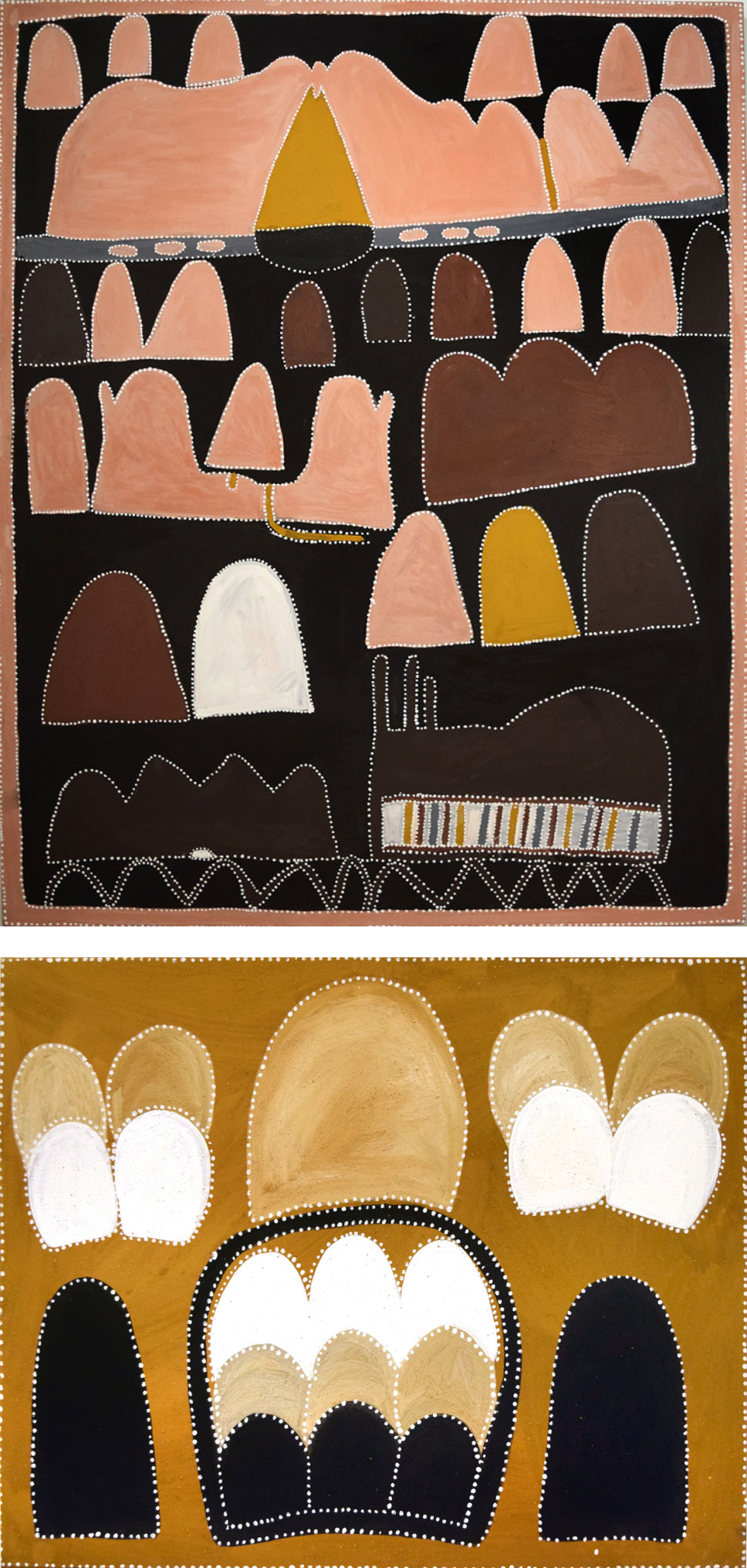
Sidney Nolan is one of Australia’s most recognisable artists whose motifs of Ned Kelly and imagery of the outback have become synonymous with the Australian national identity.
Sidney Nolan travelled extensively through Central Australia in 1949 and in addition to transforming his understanding of the country, the experience revolutionised his vision of the landscape. Throughout his travels, the subject of camels in the desert featured in numerous works around this time – notably in the 1951 painting Camels in the Desert. In relation to these paintings Nolan wrote of ‘the strange conjunction of a man on a camel, from which he surveys the landscape as if he is walking on giant stilts.’
In a letter to his friend and fellow artist Albert Tucker in January 1950, Nolan wrote of his trips to the outback: ‘The light reveals everything in a microscopic way and colours carry for almost frightening distances… Such intensity & duration of colour gives you quite a strange feeling for a while.’ The brilliant intensity of the desert light Nolan described as opalescent, ‘like mother-of-pearl and… glowing in transparent layers.’ Nolan used enamel paint, noting that, ‘in order to reproduce this light… which was flooding over everything, one had to adopt a different sort of palette from the conventional oil palette one and Ripolin on masonite seemed to set up the effect I wanted.’
Nolan’s work is held in all State galleries. He was elected an honorary member of the American Academy of Arts and Letters and a member of the Royal Academy of Arts, London.

Born in Melbourne, Ray Crooke was a highly influential Australian painter working in the 20th century and early 21st century.
His 1971 work Hamersley Ranges, West Australia highlights the breadth of Crooke’s landscapes from tropical islands to the Australian outback. After settling in Cairns, Crooke travelled extensively, developing an understanding of the people of Torres Strait, Fiji, and neighbouring Pacific Islands, as well as inland Queensland and northern Western Australia where the Hamersley Ranges are located. Within this painting, Crooke captures the vast and raw nature of the Australian landscape. The colour palette in this work however contains a soft blue in the far background that is unusual for outback Australian paintings. The colour tones give a soft wash over the painting even if the land itself is stripped back, offering an inviting feeling even though the foreground is barren.
In 1969 Crooke received the Archibald Prize for Portraiture and the first retrospective his work was held in 1972 at the Adelaide Festival of the Arts. In 1993 he was awarded the Order of Australia. In 1997 a major retrospective exhibition of Crooke’s work was held at the Perc Tucker Regional Gallery in Townsville and toured nationally. Crooke is held in a number of major Australian public collections as well as overseas collections including the Vatican Collection in Rome.

Arthur Streeton (1867-1943) was one of Australia’s finest landscape painters. He was a forefather of Australian Impressionism and is often considered one of the most influential painters in Australia’s history of art since white settlement. His landscape paintings have become key to not only an understanding of his practice but symbolise our changing relationship with this country throughout the late 19th and early 20th century.
Arthur Streeton’s 1936 painting The Cloud depicts a lightning storm above Mount Macedon, Victoria. Reflective of the Australian Impressionist style, Streeton’s brushwork creates a dappled, fading light as lighting strikes the pastoral scene. This dramatic painting was inspired by the poem ‘The Cloud,’ written in 1820 by Percy Bysshe Shelley – ‘I wield the flail of the lashing hail, and whiten the green plains under, and then again I dissolve it in rain, and laugh as I pass in thunder.’
Arthur Streeton was a frequent visitor to Macedon, painting a number of canvases in the region. This painting is considered the most significant among them, having been included in Streeton, the major retrospective of the artist’s work held at the Art Gallery of New South Wales (2020-2021).
Streeton’s work is held in the permanent collections of all State museums in Australia.
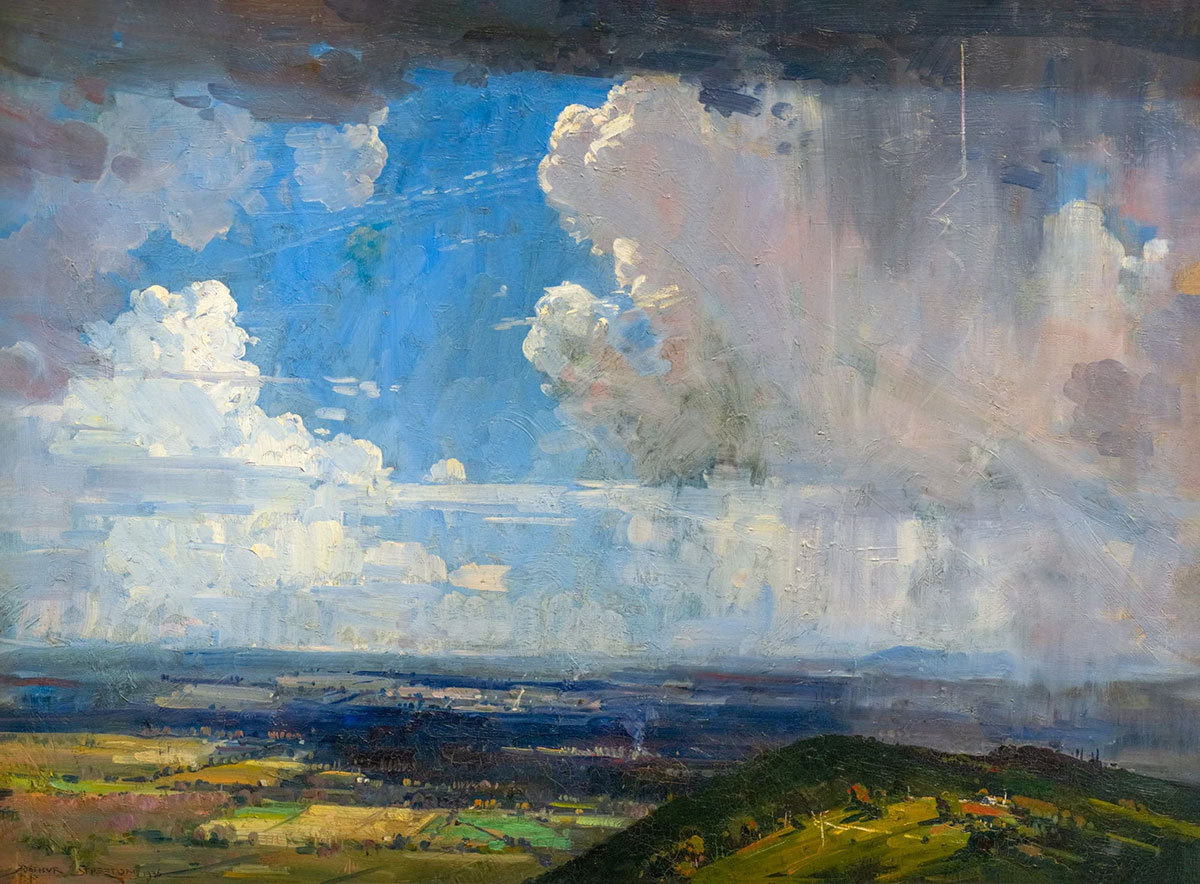
Brett Whiteley was at the forefront of Australian visual arts in the 20th century, establishing himself as one of the most influential and important artists in Australia’s modern art history.
Brett Whiteley’s 1976 painting Sydney Harbour in the Rain encapsulates his widely acclaimed and admired ability to capture the atmosphere and gravity of Sydney harbour. Whiteley used the Harbour for inspiration in the 1970s through the window of his home in Lavender Bay. Sydney Harbour in the Rain captured the drenched, grey colours of Sydney under clouds and rainfall. Wendy Whiteley recalled that ‘Lavender Bay was Brett’s paradise.’
This work belongs within a period of great critical success for Whiteley, winning three of Australia’s most coveted art awards all with Lavender Bay inspired paintings executed in or around the same year as Sydney Harbour in the Rain. These included the Archibald Prize for Self-Portrait in the Studio, 1976; the Sulman Prize for Interior with Time Past, 1976; and the Wynne Prize for The Jacaranda Tree, 1977.
His work is represented in the collections of all Australian State galleries. In 1978 Brett Whiteley became the first artist to win all three major Australian art prizes – Archibald, Wynne and Sulman – in the same year. He is held in the collections of many international institutions including the Tate, London.
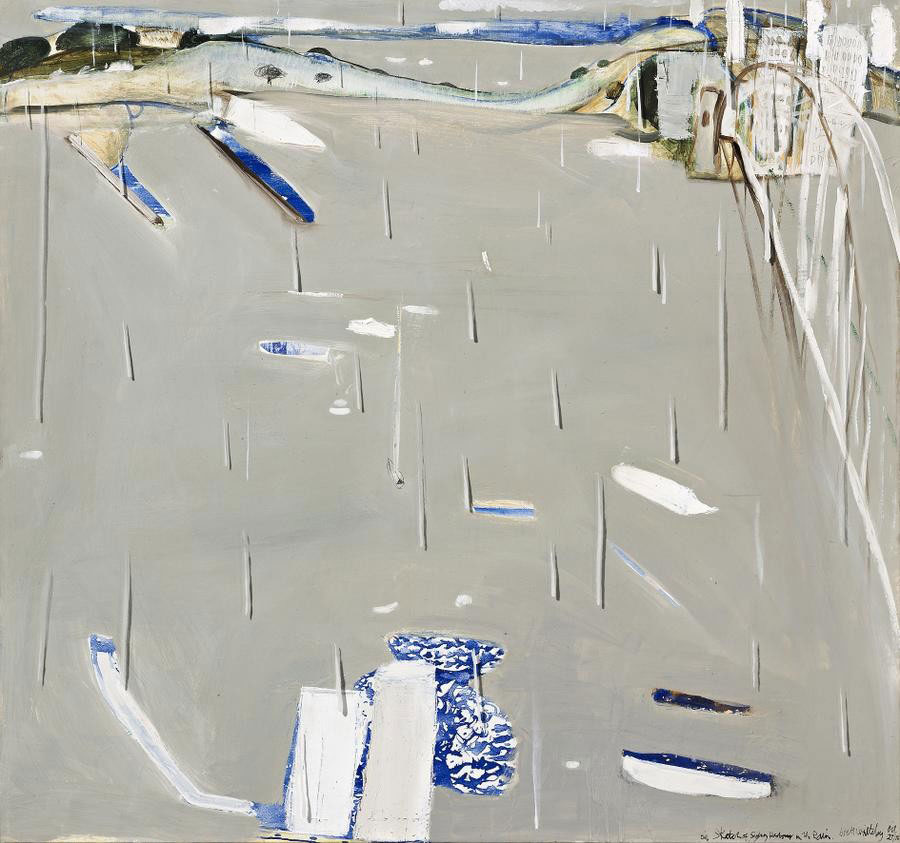
From left to right:
Ideas for Upright Internal and External Forms 1948
Maquette for Upright Internal/External Forms 1951
Henry Spencer Moore was an English artist and one of the most important sculptors of the 20th century. He is best known for his semi-abstract monumental bronze sculptures.
The 1948 drawing Ideas for Upright Internal and External Forms is an exceptional example of Moore’s vision. In this drawing, Moore employs various techniques to counter the two-dimensionality of the paper, including the use of light colours on a dark ground, and the play of light, shade and reflection on the surface of the object rendered, showing where it recedes from, and advances towards, the viewer. It also uses a technique developed by Moore where his hand traces imaginary horizontal and vertical sections, which bisect each other at right angles. These ‘contours’ allow viewers to perceive the form’s volume, and coupled with the play of light and shade, lend the drawing its relief-like quality.
During the 1950s, Henry Moore gradually changed his preparatory approach to sculpture. From 1921 onwards, drawing had been the vital generator of his ideas. However, from the early 1950s he turned increasingly to the use of small-scale sculpted models stating, “because now I am aiming at sculpture that is truly three-dimensional, I prefer to work out my ideas in the form of small maquettes which I can hold in my hand and look at from every point of view.” Maquette for Upright Internal/External Forms is one of the earliest examples of this practice.
Moore’s work can be found in 369 public exhibition spaces and is found in a number of important public institutions including the MET in New York, Guggenheim Museum, National Gallery of Australia and Courtauld Institute of Art, London.

Henry Spencer Moore was an English artist and one of the most important sculptors of the 20th century. He is best known for his semi-abstract monumental bronze sculptures.
The work Upright Internal/External Form is a bronze sculpture of a life form occupying a cocoon; inner and outer forms complement each other in a symbiotic, organic relationship. Moore recalled in the creation of the Upright Internal/External Form, ‘I have done other sculptures based on this idea of one form being protected by another. I suppose in my mind was also the Mother and Child idea and of birth and the child in embryo. All these things are connected in this interior and exterior idea.’ The works owned in the Forrest collection Ideas for Upright Internal and External Forms, 1948 and Maquette for Upright Internal/External Forms, 1951 are the pre-cursors to this sculpture.
The figure is an important sculpture in Moore’s illustrious career. The Tate Gallery in England owns an Upright Internal/External version in plaster and a twenty-foot-high version is sited in the atrium of Three First National Plaza in Chicago.
Moore’s work can be found in many public exhibition spaces and is found in a number of important public institutions including the MET in New York, Guggenheim Museum, National Gallery of Australia and Courtauld Institute of Art, London.
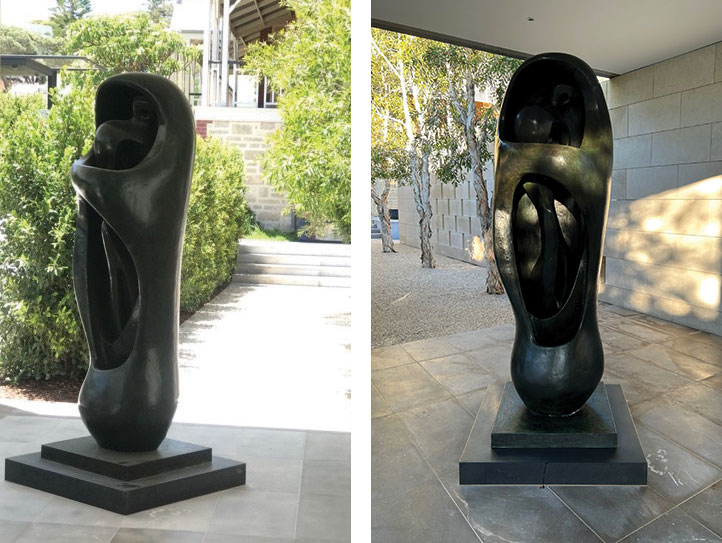
Sir William Dobell KBE was one of Australia’s most important portrait painters of the 20th century.
Often primarily working in portraiture, the 1960 painting The Spotted Dog depicts a rare landscape setting. The work is a quiet, intimate glimpse into a day of relaxed waterside activities. The spotted dog in the foreground of the painting creates an air of familiarity, a friendly figure that invites the onlooker to become present within the scene. Dobell’s signature painting style is prevalent here with his unique sense of light and delicacy of brushstroke.
In 1942, William Dobell had a solo exhibition at the Art Gallery of New South Wales. The artist then won the coveted Archibald Prize on the three occasions in 1943, 1948 and 1959. The Dobell Prize, Australia’s foremost drawing competition is named in his honour. Further, in 1954 he represented Australia at the Venice Biennale with Russell Drysdale and Sidney Nolan.
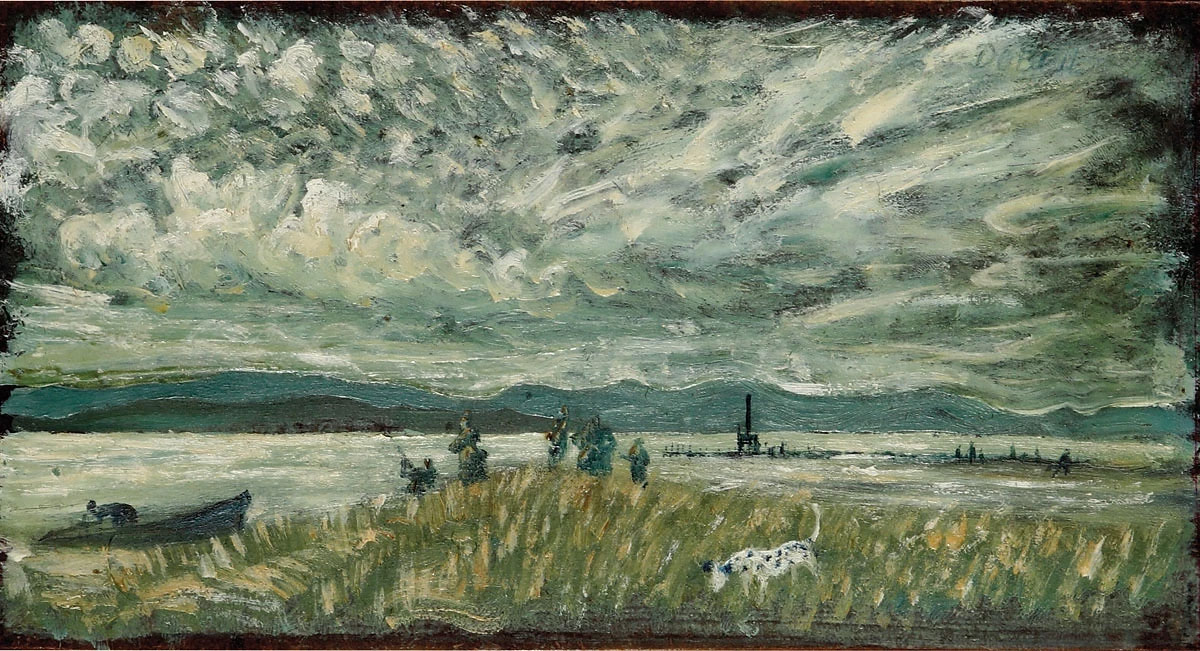
Fred Williams was one of Australia’s most recognised 20th century artists and an important figure in shaping Australian art’s relationship with landscape painting.
In the mid-1960s, the suburb of Lysterfield near Williams’ home became a regular destination for outdoor painting trips. Within the 1967 painting Hillside at Lysterfield II, Williams creates a spare and spontaneous depiction of the Australian landscape. As Kirstly Grant writes, “the hieroglyphic-like marks that Williams used to describe the tall foreground grasses, the scrubby growth across the hillside and the trees lining the horizon, are distinctively his, and typical of what Patrick McCaughey described as ‘his refined method of painting’ which was at this time, ‘as spontaneous as handwriting.’”
Williams’ practice at this time represented a unique depiction of the Australian landscape that saw him repeatedly move between representation and abstraction. Compared with the English landscape that was tamed and ordered, Williams recognised that the soul of the Australian landscape was the random scatter of elements with no focal point. He was able to conceptualise this landscape from an aerial perspective and translate rocks and small trees into touches of paint.
In 1977 Williams was the first Australian artist to hold a solo exhibition at the Museum of Modern Art in New York. His work is owned by all State museums in Australia
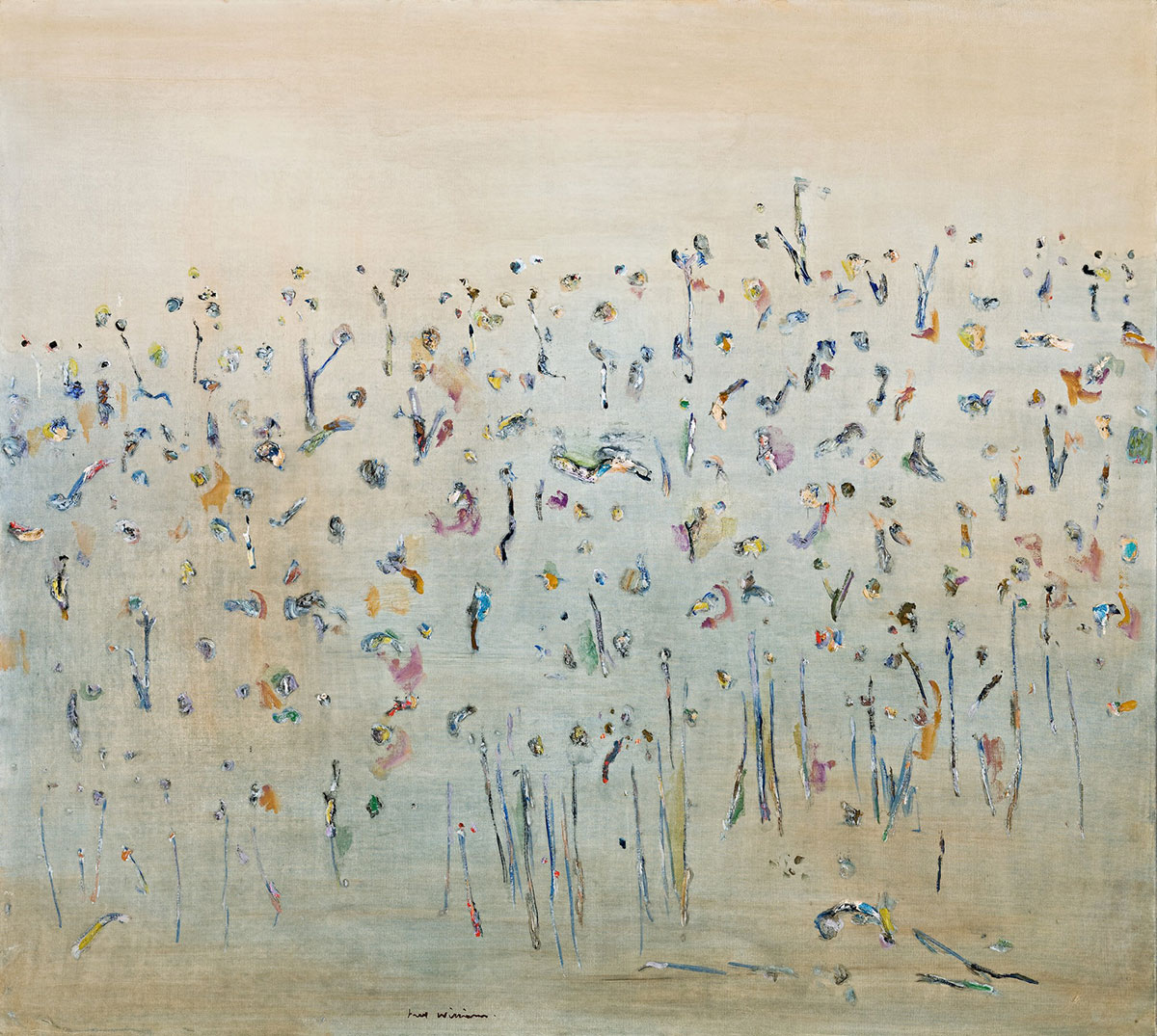
Elioth Gruner is one of Australia’s most revered landscape painters. Gruner was at the forefront of Australian en plein air painting in the manner of the French Impressionists.
The 1932 work The Gulf, Avoca illustrates Gruner’s expert ability to manipulate light and colour to capture the world as it was in the moment. Australian artist Norman Lindsay described Gruner as “the greatest painter of pure light the world has ever seen.” The practice of en plein air painting allows the viewer to feel like they are standing in the place of the artist, seeing and feeling what it was like from their easel. Further, Gruner’s landscape paintings allow the viewer to reflect on the unique light and colours of the Australian landscape.
Gruner’s work is held in all major State public galleries. Gruner won the Wynne Prize seven times in 1916, 1919, 1921, 1929, 1934, 1936, 1937.
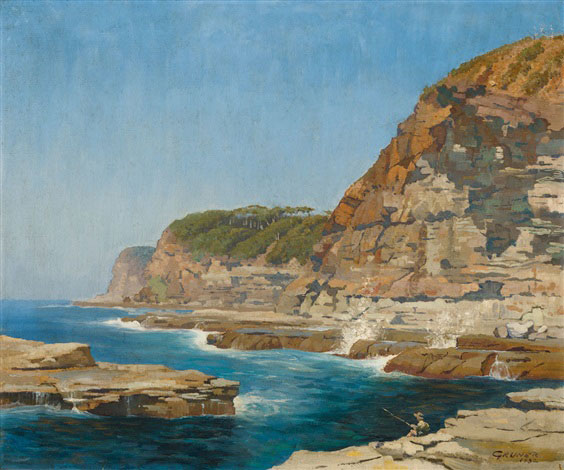
Russell Drysdale is considered one of the first Australian artists to examine the complex relationships between the landscape and inhabitants of inland Australia. Russell Drysdale attained international status for the distinctly ‘Australian’ character of his work.
Drysdale’s depictions of Indigenous people, small town dwellers and rural workers isolated within a harsh and dramatic environment were in stark contrast to the dominant imagery of the Australian landscape as a land of pastoral plenty. The 1946 drawing Shapes for Textile Designs depicts a dusty scene of petrified, weathered wood laying on barren ground. Drysdale focuses on the idea of form and decay, unlike other Australian artists of the time he takes a lens to the harsh reality of life in the outback. The colour palette of the work is honest and it is clear that the artist isn’t attempting to inject any form of life or colour into a scene that is already scattered with death.
The drawing is highly reminiscent of Henry Moore’s work of the same period, Upright Internal/External Forms (1948-1951). The figures relate to a family grouping similar to Henry Moore’s work however their contexts are wildly different.
Drysdale’s works are held in the Art Gallery of NSW, the National Gallery of Victoria and the Art Gallery of Western Australia. He won the prestigious Wynne Prize for Sofala in 1947, and represented Australia at the Venice Biennale in 1954.

Hailed as the father of Australian landscape painting, Tom Roberts had a profound impact on shaping the national artistic identity throughout the late 19th and early 20th century. He was considered the leader of the Heidelberg school (also known as the Australian Impressionists) which was the first distinctively Australian school of painting.
Throughout his career, Tom Roberts developed close friendships with women in his social circle. His paintings of these companions often presented an aesthetic response to the decorative elements of women’s dress. As Kirsty Grant writes, “the full-length pastel of Florence Greaves (painted 1898) exemplifies this aspect of his work, making a feature of the flowers on her hat, the delicately-speckled veil and ruffled white petticoats glimpsed beneath the hem of her skirt – highlighting ornamental details in what is otherwise a plain, although very stylish outfit.” His depiction of the subject in a side profile offers an intimate emphasis on her fine features, sharp jawbone and the movement of her body.
Roberts is held by all major Australian State institutions. His work is further held internationally by the British Museum in London.

Frederick McCubbin (1855-1917) is considered one of the most influential Australian artists of the late 19th century and early 20th century.
Recognised for his ability to capture the complexities of people and the richness of the Australian landscape, McCubbin was a highly prominent figure in the Australian impressionist movement also known as the Heidelberg School of Art. The ‘school’s’ efforts lay the foundation for painting distinctly Australian subjects in the late 19th and early 20th century.
When Frederick McCubbin moved to Macedon in 1901 he entered upon, as his son Alexander wrote, ‘the most fertile and vigorous period of his life.’ The painting Bush Landscape, Macedon, 1905 is a masterful example of McCubbin’s ability to capture the radiance that sunlight creates upon the natural world. The artist devoted himself enthusiastically to the subjects around him, writing to his friend Tom Roberts in 1904 ‘the bush up our way looks more charming than ever, pictures everywhere.’ Bush Landscape, Macedon further represents a transitional state in his work from the smoothly painted, tight style of earlier years to the freer, textured brushstroke and palette knife.
Frederick McCubbin’s work is held in the permanent collection of all major State galleries.

Frederick McCubbin is considered one of the most influential Australian artists of the late 19th century and early 20th century.
Bush Idyll, 1893 is widely regarded as one of the finest masterpieces in Australian art history. In the year it was created, the McCubbin family moved to Lot 52 Wolseley Crescent, Blackburn in Victoria. Bush Idyll was painted within walking distance of the property and the distant lake depicted is thought to be the Blackburn Lake Sanctuary. The painting depicts a girl and boy, the latter is playing a tin whistle. The model for the girl was Mary Jane Lobb who born in Castlemaine in 1881 and died in 1959. The model for the boy is unknown. Painted at the mid-point of McCubbin’s national narrative paintings period— between the execution of A Bush Burial and On the Wallaby Track—Bush Idyll’s youthful subjects are considered to represent the promise and potential of a pre-Federated nation.
Bush Idyll was exhibited at the Paris Salon Societé des Artistes Français exhibition of 1896. McCubbin then gifted the painting to a friend who sold it at auction in 1919 to showbusiness promoter Hugh D. McIntosh, who took the painting to England. The painting was only returned to Australia in 1984.
Frederick McCubbin’s work is held in the permanent collection of all major State galleries. The work was on loan to the National Gallery of Australia between 2017 and 2020. In late 2021 and early 2022 the painting was a part of the “Frederick McCubbin – Whisperings in wattle boughs” exhibition at the Geelong Art Gallery, Geelong.

Brett Whiteley was at the forefront of Australian visual arts in the 20th century, establishing himself as one of the most influential and important painters whose work related to both the urban and natural worlds.
Birds were a driving force behind Brett Whiteley’s imagination and his love of the natural world. He considered the dove one of his favourite birds for its beauty and historical significance of peace and cultural harmony. The Dove is a large work on paper at 110 by 79 cm which is etched and printed. While simple in its appearance, the artwork is a view into Whiteley’s appreciation for the bird and his attention to studying life and form
Whiteley’s work is represented in the collections of all Australian State galleries. In 1978 Brett Whiteley became the first artist to win all three major Australian art prizes – Archibald, Wynne and Sulman – in the same year. He is held in the collections of many international institutions including the Tate, London.

Emily Kame Kngwarreye is one of Australia’s most significant contemporary artists producing internationally recognisable paintings. As a first nations artist, the language within her work represents thousands of years of stories, visual and verbal.
Emily was born at the beginning of the 20th century and grew up in a remote desert area known as Utopia, 230 kilometres north-east of Alice Springs. She began painting without any formal or informal art training. Emily’s languages were the traditional Indigenous dialects of Anmatyerre and Alyawarr. Although bound to these constraints of rural geography and language barriers, her work has been an internationally recognised symbol of Australian art.
Earth’s Creation was painted in 1994 and comprises of four adjoining panels that represent the north-central desert region of Alhalkere after the rains. Kngwarreye called it “green time,” based on a bright palette of greens, yellow, blue, and red as the painting invokes a vibrant field with pools and dots of paint. Her canvases attest to her connection between self and country. Emily Kngwarreye painted with a ‘dump dot’ technique, using her brush to pound the acrylic paint onto the canvas and create layers of colour and movement. The work has often drawn connections to that of the French Impressionists for its ability to create movement with the vibrancy and softness of its colour palette. The work captures the vastness and colour of the landscape that Emily’s core existence was so entwined with.
The painting was included in the 2008 exhibition “Utopia: The Genius of Emily Kame Kngwarreye” that toured the National Museum of Australia and Tokyo and Osaka. In 2015 the work was shown at the 56th Venice Biennale. Earth’s Creation is considered the most important painting created by Emily Kngwarreye.
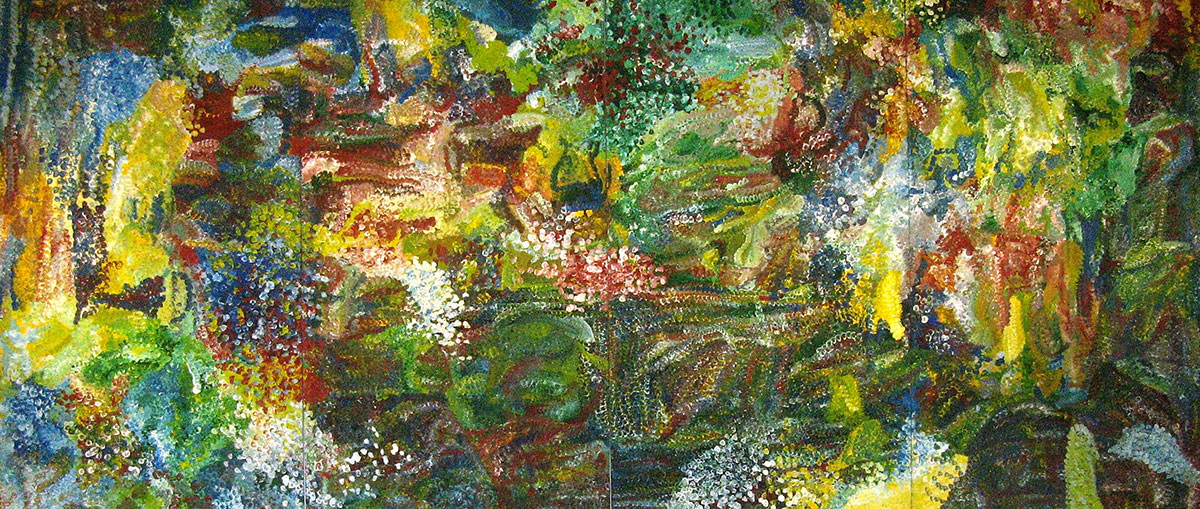
William Robinson is one of Australia’s foremost landscape painters. Known for shifting perspectives in one canvas, his voice and interpretation of landscape is unique and instantly recognisable.
In the 1990s, in response to personal tragedies, Robinson immersed himself in a new environment at Springbrook where he had acquired a property. Here in the rainforests of Queensland, Robinson played with the idea of time beyond our day-to-day conception and explored imaginary depictions of Australia as an ancient continent. The 1995 painting Towards the Sea, from Springbrook encapsulates his deep admiration for the land, encouraging us to experience it differently through varying perspectives within its composition. Describing the experience of walking through the forest of 2000 year-old beech trees near his property at Springbrook, Robinson recalls his visit: ‘I want to show the presence of God somehow, not only through the mystery of walking through Chartres Cathedral and walking through this forest, but also something about the nature of providence.’
Robinson noted regarding the Springbrook Trees that “they are worn and old and link us with the time of Christ. We walk this path every day we are at Springbrook and see this rainforest in virtually all of its moods. It begins in the morning with the emerging golden sea and clouds forming and casting shadows.”
Robinson’s work is held by a number of important Australian institutions including the Art Gallery of New South Wales in Sydney and won the Archibald Prize in 1987. He further has a dedicated gallery called the William Robinson Gallery at the Queensland University of Technology. Robinson’s work is also held internationally by the Metropolitan Museum of Art in New York and the British Museum in London.
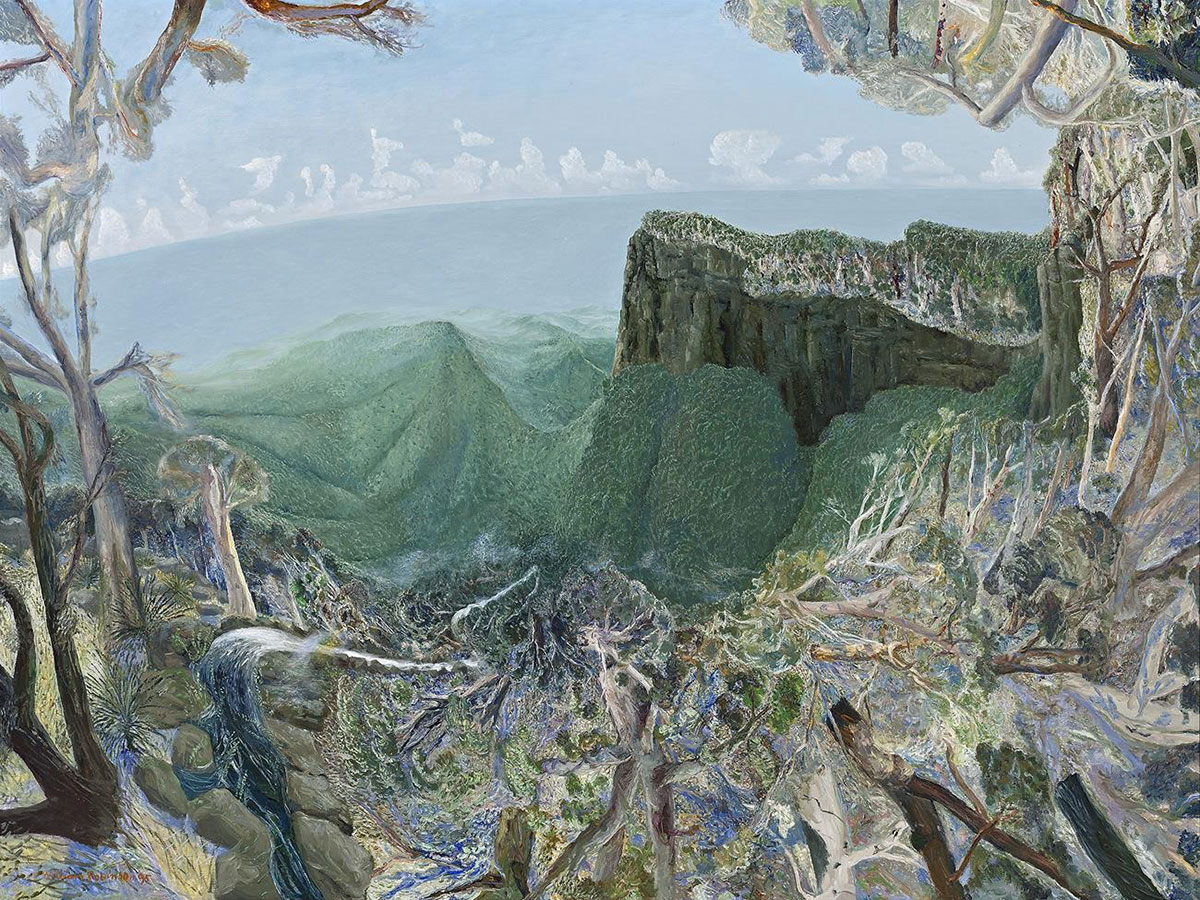
John Olsen was one of Australia’s greatest artists, who was an immensely influential figure throughout the nations 20th century artistic development. Through his ability to tether the abstract and fluid movements of his paintbrush to the rich and raw Australian landscape he has perfectly captured the personality of Australia in timeless fashion.
In 2020, Olsen stayed at Minderoo Station where he painted a number of works inspired by the property and its surroundings.
When one looks upon an Olsen work they are experiencing the lifeblood of the world around them and the Australian landscape in all its vivid glory. In reference to his form, Olsen stated:
I wanted to really come to terms with the experience of a total landscape. Not like there is the foreground, there is the middle distance and there is the horizon. I wanted that overall feeling of travelling over the landscape. There you can see the dry creek beds, the nervous system… Then you begin to somehow see the wholeness, the essential untidiness.
Throughout his career Olsen won the Wynne Prize in 1969 and 1985, the Sulman Prize in 1989 and the Archibald Prize in 2005, among many other awards throughout his long career. In 2001 he was further made an Officer in the Order of Australia (AO), in 1977 was awarded the O.B.E. for services to the Arts and in 1993 he was awarded an Australian Creative Fellowship. Olsen has 131 works held in the permanent collection of the Art Gallery of New South Wales alone. His work is held in all major State galleries.

From left to right:
Landscape at Twilight 1890
Undergrowth 1889
Fishing Boats on the Beach at Les-Saintes, Maries-de-la-mer 1888
Wheatfield under Thunderclouds 1890
The Bedroom 1888
Almond Blossom 1890
The Harvest 1888
Sunflowers 1888
Boulevard de Clichy 1887
Van Gogh often used thick applications of paint on his canvas, making his works perfectly suited for 3D reproduction. The Van Gogh Museum worked closely with Fujifilm Belgium to develop a special technique combining a three-dimensional scan of the painting with a high-resolution print.
The collection features a limited print run of 260 reproductions of each of the featured masterworks. Each Museum Edition is numbered and certified by a Van Gogh Museum curator.

One of Australia’s most significant artists, Margaret Preston was a key figure in the development of modern art in Sydney from the 1920s to the 1950s. Preston was renowned for her paintings and woodblock works that portray both the Australian landscape and its native flora.
The 1956 painting Black Jug with Kangaroo Paws is representative of Preston’s long-standing commitment to the genre of still life that showcases her ability to capture light, colour and context within this static subject. The vibrancy of Australian native pigments and flowers that define Australia’s unique natural world are present in this work.
Preston’s first article promoting Australian Indigenous art, ‘The Indigenous art of Australia,’ was published in 1925. In this she argued that a national art would only develop from paying attention to Aboriginal art and in her own art she borrowed influences without making specific reference to the work of individual artists. In adapting aspects of Australian Indigenous art, the artist also focused on arrangements of native flowers and fruit. Preston’s work is therefore important due to her ability to connect Western artistic styles to the history of Australia.
Preston’s artworks are held by all major Australian museums with multiple works on display at the Art Gallery of New South Wales in their permanent collection.

Brett Whiteley was at the forefront of Australian visual arts in the 20th century, establishing himself as one of the most influential and important painters whose work related to both the urban and natural worlds.
In the mid to late 1970s, Whiteley painted a number of major still life works. These paintings involved the artist reflecting on objects in his personal space, offering viewers a lens into his daily life.. Alongside the Orange Table (1977-78), Whiteley completed canvases including Still Life with Cornflowers (1976), Still Life with Banana (1977) and Table and Fruit (1978). The Orange Table radiates the warmth of a Sydney afternoon from the Lavender Bay home and studio that he shared with his wife, Wendy. Drawing inspiration from Henri Matisse, Whiteley’s canvas employs bright, bold colours to explore his emotional relationship to the simple yet impactful items around him.
His work is represented in the collections of all Australian State galleries. In 1978 Brett Whiteley became the first artist to win all three major Australian art prizes – Archibald, Wynne and Sulman – in the same year. He is held in the collections of many international institutions including the Tate, London.
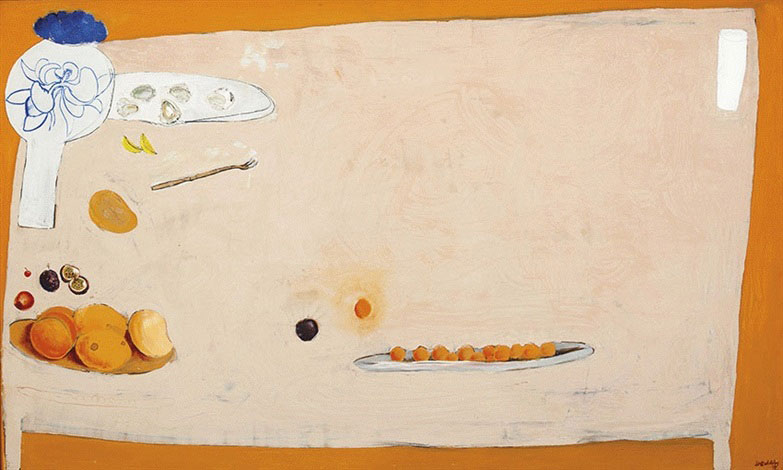
Fred Williams was one of Australia’s most recognised 20th century artists and an important figure in shaping Australian art’s relationship with landscape painting.
In Fred Williams’ 1978 canvas Acacias in the You Yangs II, the golden wattle flower lights the forest’s darkness through a luminous yellow palette and rich, thick texture. Close-up in view, the ascending background and absence of horizon increase the intimacy of the depicted landscape. The subtle beauty of the floating forms tells of the influences of Chinese art, referential of Williams’ visit to China in 1976.
Williams’ interest in painting wattle goes back to the winter of 1969 when he visited Clifton Pugh at ‘Dunmoochin’ in Cottlesbridge, north-east of Melbourne. Writing in his diary on the 24th of July, he said he found it ‘fascinating painting the wattles’. The following day he added: ‘I would really like to work from them as they mature.’
In 2017, the significance of the You Yangs in his oeuvre was acknowledged by the Geelong Gallery when it gave their major exhibition the title – ‘Fred Williams in the You Yangs: a turning point for Australian art.’ In 1977 Williams was the first Australian artist to hold a solo exhibition at the Museum of Modern Art in New York. His work is owned by all State museums in Australia.

John Brack was one of Australia’s most prominent modernist painters in the 20th century and remains one of the key figures in the nation’s art history.
Brack’s style and subjects brought life to mid-century Australian society and have remained a reflection of Australia’s national identity throughout the 20th century. The 1958 painting Knives and Forks is a still life that focuses on the iconography of ritualised, daily life in 20th century Australian households. In the 1950s, Brack’s career focused on the somewhat surprising beauty of everyday items such as hairbrushes, kettles and vases. These works act as a reflection upon how we, even today, find meaning in the simplest activities throughout our lives. Brack’s painting alludes to busy family life that revolves around cutlery and the act of eating meals together. The background of the work comprises of a pale green and lilac colour palette, classic colours of 1950s domestic interiors, setting the work forever in a moment of time.
Noted by Australian art historian Patrick McCaughy, ‘the still life enables Brack to ruminate and reflect on ideas and arguments beyond the scope of observed experience. Brack becomes a ‘modern history painter,’ able to take on the largest speculations pictorially through the humble genre of the studio still life.’
Brack’s work is held in all major Australian institutions including the National Gallery of Victoria, Melbourne and the Art Gallery of New South Wales, Sydney.

Paddy Bedford was a senior Gija lawman and a highly important figure within contemporary East Kimberley painting. He was born on Bedford Downs Station south-west of Warmun (Turkey Creek) in Western Australia.
Thoowoonggoonarrin (2006) was one of the last paintings executed by Bedford and can be seen as a culmination of the innovative changes in style and technique he developed to create his own representations of country. Painting for Paddy Bedford was multi-layered; an expression of country and cultural memory, as well as a declaration of identity and statement of claim to the land itself. Art historian Michael Dolk argues that his painting suggests a physical and tactile relation to land, ‘to behold painting is to hold country and to remain beholden to its ancestral tradition.’ Thoowoonggoonarrin explores rocky escarpments, rivers and other amorphous features of the Kimberley landscape, while at the same time containing a learned and poetical knowledge of the land and its creation stories. Tunganary Gorge is home to a permanent waterhole and is the dreaming place for Thoowoonggoonarrin, a large tree with dark leaves that is related to the fig tree. The artist’s maternal aunt died and is buried at this place, giving it a unique spiritual and familial connection to the artist.
His work is held in numerous Australian institutions including the Museum of Contemporary Art, Sydney and the Art Gallery of New South Wales. His work is further held internationally at the British Museum.
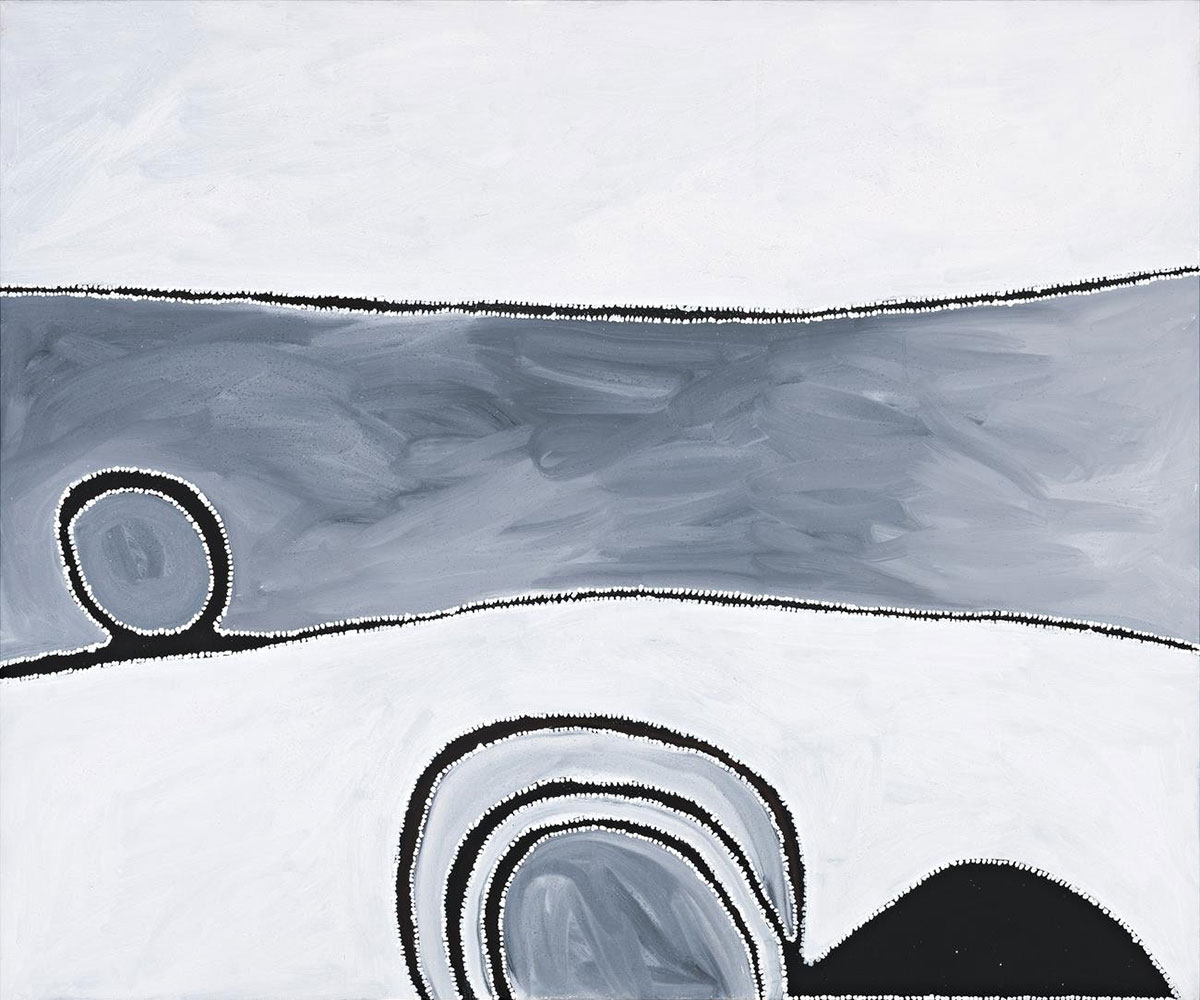
Elioth Gruner is one of Australia’s most loved landscape painters. Gruner was at the forefront of Australian en plein air painting in the manner of the French Impressionists.
His canvas Pastoral Landscape is a small bright, charming rural scene. The artist’s expert use of light and colour generates a radiant glow from behind the tree, reflecting off the grass and the backs of the animals. The painting is modest in scale with a classic story that conveys an idyllic life – especially for the depicted beasts.
Gruner’s work is held in all major State public galleries. Gruner won the Wynne Prize seven times in 1916, 1919, 1921, 1929, 1934, 1936, 1937.

Hailed as the father of Australian landscape painting, Tom Roberts had a profound impact on shaping the country’s national artistic identity throughout the late 19th and early 20th century. He was considered the leader of the Heidelberg school (also known as the Australian Impressionists) which was the first distinctively “Australian” school of painting.
The 1925 painting Dandenongs Landscape represents the golden summers of Australian Impressionism that focused on the dry vast plains and light pale blue open skies.
In the 1920s, both Tom Roberts and Arthur Streeton moved their focus from the Victorian locality of Heidelberg to the Dandenong Ranges outside of Melbourne. Sunny days offered the artists the opportunity to paint landscapes with long cast shadows that lengthen and create depth and space along the vast mountain ranges. This painting illustrates Robert’s ability capture the sharpness of Australian light and the unique sense of space and colour of the landscape.
Roberts is held by all major Australian State institutions. His work is further held internationally by the British Museum in London.

Frederick McCubbin is considered one of the most influential Australian artists of the late 19th century and early 20th century.
Recognised for his ability to capture the complexities of people and the richness of the Australian landscape, McCubbin was a highly prominent figure in the Australian impressionist movement also known as the Heidelberg School of Art. The school’s efforts laid the foundation for painting distinctly Australian subjects in a European style.
Frederick McCubbin’s 1906 painting The Bathers is a stellar example of the artist’s ability to breathe life into a canvas through precise brush work and soft tones. The swimming figures to the bottom right of the canvas are made small as the vast setting extends far into the distance on the left. McCubbin portrays the Australian landscape through a romantic Impressionist lens. The painting feels more “European” than “Australian”. As art historian Barry Pearce wrote, “McCubbin was one of the very few Australian painters who found an exalted resolution of vision that progressed with age.”
Frederick McCubbin’s work is held in the permanent collections of all major State galleries.

In 1917, Harold Septimus Power was appointed the official Australian war artist. He is considered one of Australia’s finest realist painters, through his ability to capture light and a distinctly Australian character.
Throughout the first world war, Power’s most iconic figures in war scenes were horses. In the work Summer Pastoral, the artist explores the nature of animals in a rural setting rather than on the battlefield. Through the lens of bright but gentle colour tones, a herd of cows rests comfortably under a bridge without disruption. Arthur Streeton once remarked about Power’s work, “one is impressed first by a tremendous display of colour and a dauntless feeling of optimism… He displays remarkable knowledge and vigour in his paintings of animals.”
Power’s overseas influence was highly impressive, having been exhibited at the Royal Academy in England, the Royal Scottish Academy, the Royal Society of Portrait Painters, London and the Paris Old Salon. His work is held by a number of important Australian public institutions namely the Art Gallery of New South Wales, Sydney, Art Gallery of South Australia in Adelaide and the Australian War Memorial in Canberra.
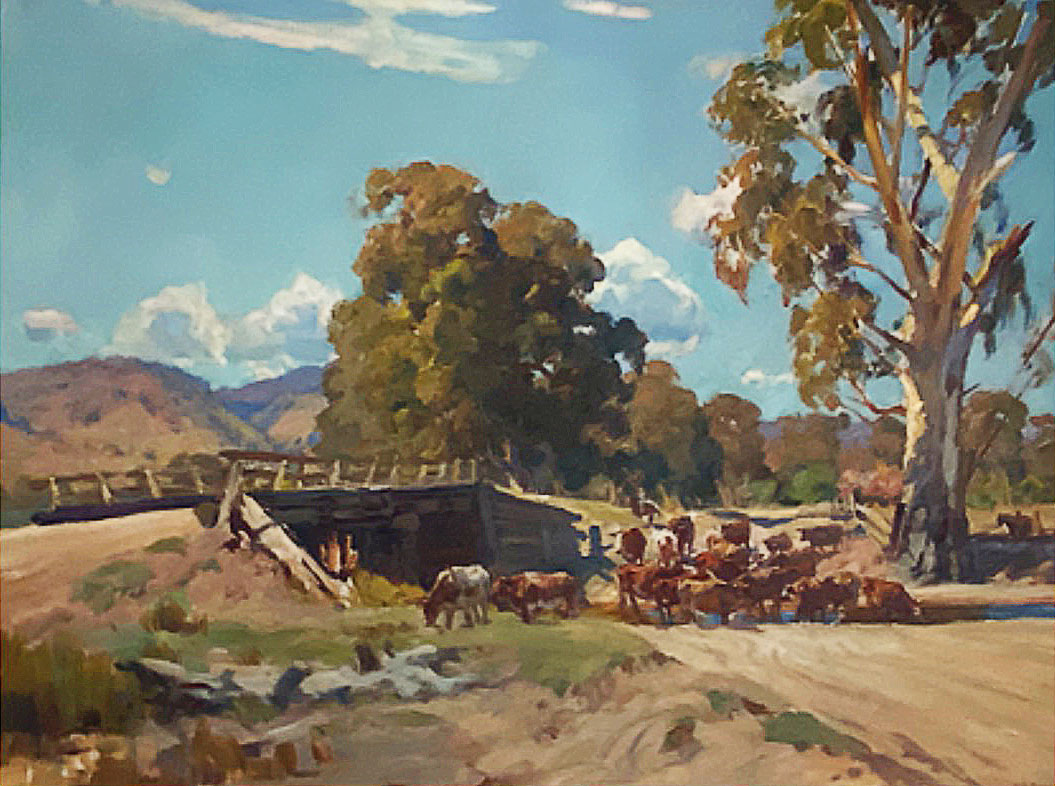
Fred Williams (1927-1982) was one of Australia’s most recognised 20th century artists and an important figure in shaping Australian art’s relationship with landscape painting.
Residing at Karratha Station in 1979, a country property fifteen kilometres from the coast of Western Australia, Williams was well placed to survey the rugged setting of the Hamersley Ranges. The 1979 painting Spinifex Landscape, Hamersley Ranges has a high horizon line dotted with a number of distinctive Kimberley boab trees. The work is characterised by touches of paint and lines laden with pigment set against bands of wash, evoking the vastness of the Australian landscape. Flying over the region in a biplane and taking hundreds of photographs, Williams sought to capture the nuances of the land, using the fast-drying medium of gouache to faithfully and immediately transcribe its saturated mineral-rich colours.
In 1977 Williams was the first Australian artist to hold a solo exhibition at the Museum of Modern Art in New York. His work is owned by all State museums in Australia.

A pioneer of Australian 20th century art, Roy de Maistre’s explorations of colour and abstraction brought Australian modernist painting to an international stage.
The Pines (1921) is a small work that depicts a rural scene near de Maistre’s family home in the Southern Highlands of New South Wales. The canvas reflects the artists’ feelings of familiarity and comfort, achieved through the gentle colours and soft-edged layering of trees. While the scale of the painting itself is small, de Maistre creates an expansive scene as the road reaches further towards the centre of the painting and beyond. The scene gives the impression of a well maintained farm bathed in mid-summer light.
De Maistre’s works are held by a number of important international institutions including the Tate in London, National Gallery of Victoria, Melbourne and the Art Gallery of New South Wales, Sydney.

Albert Tucker was one of Australia’s foremost 20th century painters. Tucker was a key member of the important Angry Penguins and Antipodean movements of the 1930s alongside John Brack and Robert Dickerson.
The drawing City, completed in 1939 is a complimentary piece to the painting also held in the Forrest Family Collection of the same name and completed in the same year. The sketch is raw and simplistic, with minimal detail and no colour. It also offers an important and unique lens into the mind of the artist and the process Tucker experienced to construct his paintings.
Tucker’s work is held in a number of major Australian institutions including the Art Gallery of NSW, Sydney, the National Gallery of Victoria, Melbourne and the National Portrait Gallery in Canberra.

Albert Tucker was one of Australia’s foremost 20th century painters. Tucker was a key member of the important Angry Penguins and Antipodean art movements of the 1930s alongside John Brack and Robert Dickerson.
Concerned by the social injustices he saw around him, Tucker’s 1939 painting City focuses on Melbourne’s inner-city, implying the impoverished working class residents of the scene. He recalled at the time, his ‘mood was one of depression –a sense of inadequacy’– he may have been contemplating the enormity of the Second World War that had begun to unfold overseas. Tucker’s yellow sky and soft colours create a sense of possible foreboding in the city, dense with architecture and lacking street life and community.
Tucker’s work is held in a number of major Australian institutions including the Art Gallery of NSW, Sydney, the National Gallery of Victoria, Melbourne and the National Portrait Gallery in Canberra.

Frederick McCubbin is considered one of the most influential Australian artists of the late 19th century and early 20th century.
The late 1914 work Burnley is an example of McCubbin’s ability to create an expansive vision and textural form on a small scale. Throughout this work McCubbin maintained a wide breadth of colour found in the style of French Impressionism. The artist layers paint, allowing it to dry before being rubbed back to reveal layers of colour beneath. The paint is further manipulated with palette knives, the handles of brushes and even cloth.
To quote the Curator of the National Gallery of Australia – “McCubbin’s art was most remarkable during his final years. His daring, his experimental painterliness, and his ability to capture the Australian landscape produced some incredible work.”
Frederick McCubbin’s work is held in the permanent collection of all major State galleries.

Elise Blumann was a German modernist painter who brought her European practice to Perth in the 20th century.
Elise Blumann left Germany in 1934, settling in Perth, Western Australia. While living in Berlin, Blumann had been taught by Max Liebermann who led the Berliner Secession. After her relocation to Perth, Blumann melded the European modernist style with influences from her new surroundings. Entranced by the extraordinarily different colours and light in Perth, she developed a distinctive palette of warm sandy ochre hues which she often juxtaposed against the colours of the local flora. In the 1965 work Still Life, Blumann includes the local flora, with the leaves bright and green from the Perth sunlight.
Elise Blumann’s work is held in the National Gallery of Australia, Canberra, the Art Gallery of Western Australia, Perth and the University of Western Australia.

A pioneer of Australian 20th century art, Roy de Maistre’s explorations of colour and abstraction brought Australian modernist painting to an international stage.
Between 1926 and 1930, de Maistre produced an extended series of floral still life paintings many with the title of Flower Piece. However, some works from this period such as the 1926 canvas Gerberas, bear titles that identify their subject and make them a unique example within a grouping of still life works. In classic modernist style, de Maistre tilts the angle of the table to accentuate his own raised perspective. The ‘oriental’ patterning of the cloth contrasts with the simplicity of the highly glazed ceramic pots which sit off-centre. On the wall behind the flowers hangs a memento from his early art-pioneering days Colour Study (1920), where a view of boatsheds on Sydney Harbour is painted in the style of his ‘colour music’ works.
De Maistre’s works are held by a number of important international institutions including the Tate in London, National Gallery of Victoria, Melbourne and the Art Gallery of New South Wales, Sydney.

One of Australia’s most significant artists, Margaret Preston was a key figure in the development of modern art in Sydney from the 1920s to the 1950s. Preston was renowned for her paintings and woodblock works on paper that portray both the Australian landscape and its native flora.
Preston’s early 1917 painting Still Life captures the essence of Australian modernist art and the tableware fashion of the time. Acting as a time capsule, the painting takes a number of simplistic everyday items and elevates them to markers of style. In what would become a classic Preston composition repeated in many still life works, the elements on the table are both drawn together and also reach to the sides of the canvas. It is both a study of forms and space, but also light.
She is held by all major Australian museums with multiple works on display at the Art Gallery of New South Wales in their permanent collection.

Award winning Australian contemporary photographer Leila Jeffreys specialises in portraiture photography of birds.
Jeffreys collaborates with conservationists, ornithologists and sanctuaries to find her subjects before forging an intimate relationship with the birds that she photographs in her studio. Leila’s portraits of Cockatoos, such as the 2017 Cyril Moluccan Cockatoo and Prudence Moluccan Cockatoo are highly personalised, with each portrait featuring the name of the bird. Jeffreys’ relationships with the birds explore the idea of closeness and interdependence of humanity and the natural ecosystem.
Jeffreys’ work has been collected by institutions including Artbank, Sydney, Macquarie Bank, Sydney, 21C Museum Hotels, USA and the Museum of Photography in Seoul, South Korea.
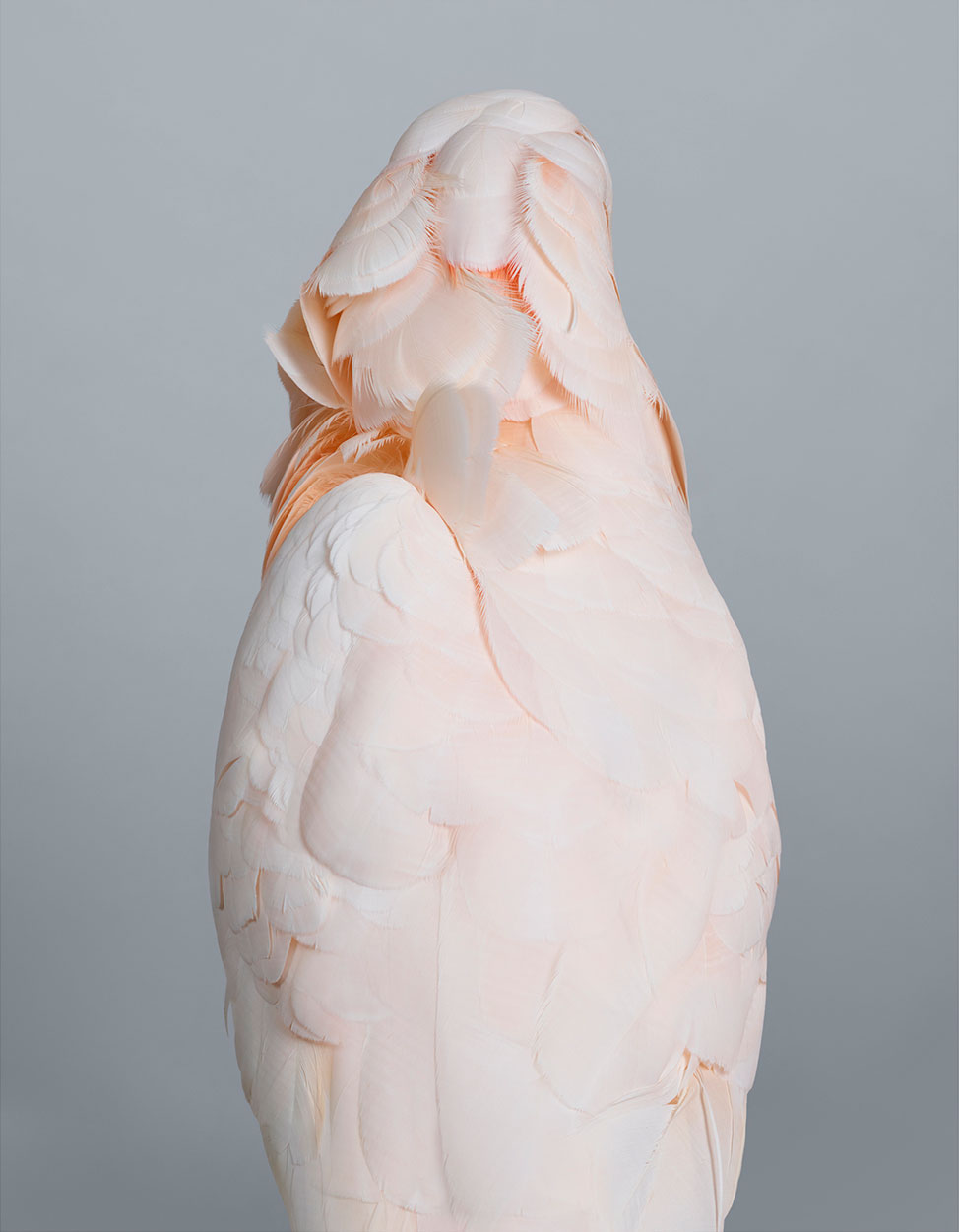
Award winning Australian contemporary photographer Leila Jeffreys specialises in portraiture photography of birds.
Jeffreys collaborates with conservationists, ornithologists and sanctuaries to find her subjects before forging an intimate relationship with the birds that she photographs in her studio. Leila’s portraits of Cockatoos, such as the 2017 Cyril Moluccan Cockatoo and Prudence Moluccan Cockatoo are highly personalised, with each portrait featuring the name of the bird. Jeffreys’ relationships with the birds explore the idea of closeness and interdependence of humanity and the natural ecosystem.
Jeffreys’ work has been collected by institutions including Artbank, Sydney, Macquarie Bank, Sydney, 21C Museum Hotels, USA and the Museum of Photography in Seoul, South Korea.
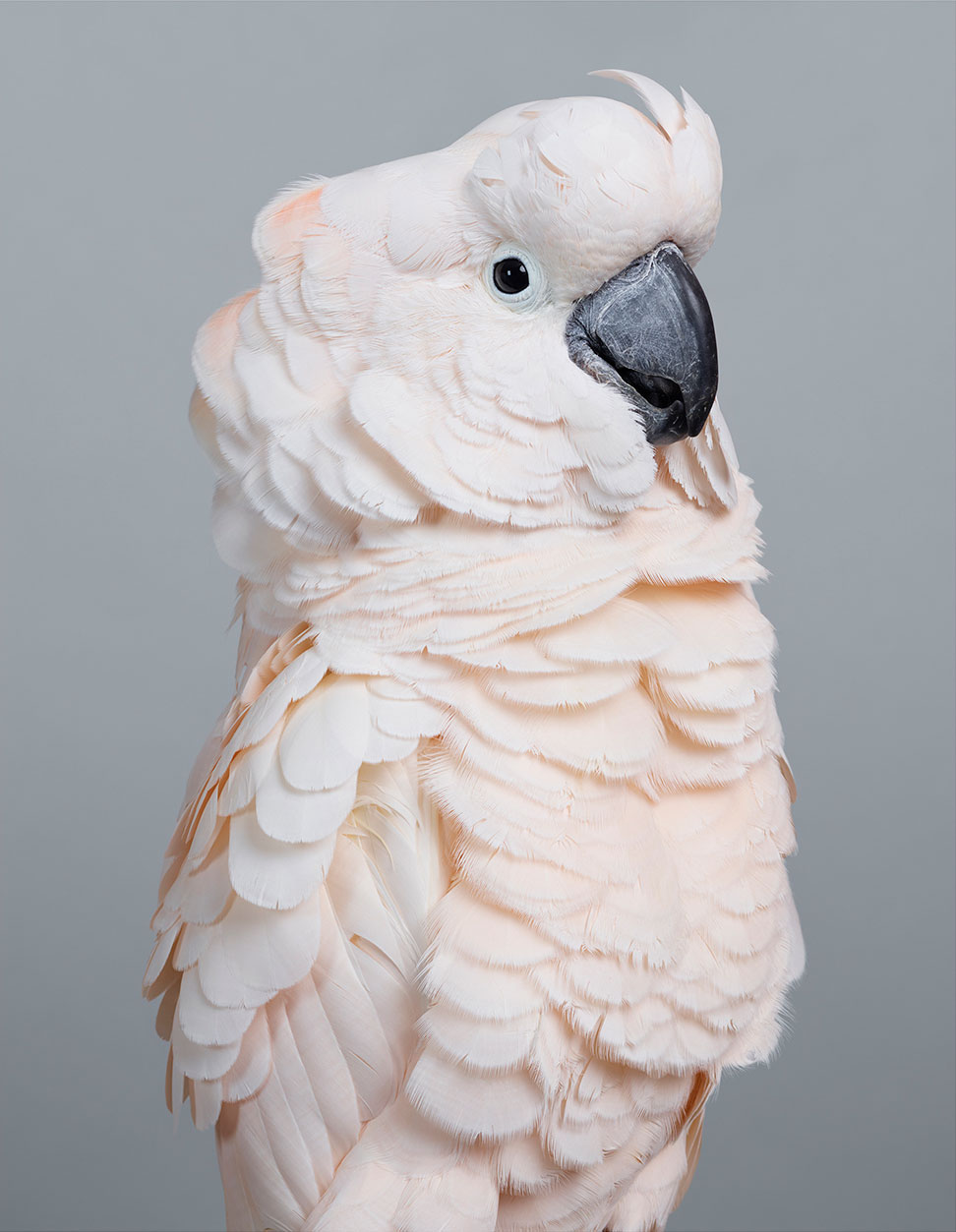
Madigan Thomas was born on Violet Valley Station just south of Warmun, Western Australia. As a child, she assisted the women with yard and domestic duties around the station and learnt from her elders the rich history of her culture which remain with her today.
Madigan’s canvas Menaliya Hill – Mount House is a vertical landscape of smooth brushwork interlinked with white dots. The painting represents a Goanna catching its prey within Menaliya Hill. The vertical form of the painting gives the viewer a perception that we are looking at the land from both above and below.
Thomas’ work is held in the Parliament House Collection and the collections of the Art Gallery of New South Wales and Art Gallery of Western Australia.

A pioneer of Australian 20th century art, Roy de Maistre’s explorations of colour and abstraction brought Australian modernist painting to an international stage.
The 1920 work Colour Sketch is a small, intimate rural English landscape painting. The artist utilises cool tones and fine brushstrokes to replicate the soft British outdoor colours and light. Similar to the 1921 work in the collection The Pines, both paintings are composed of oil paint on board indicating preferred materials of small-scale landscape painting for the artist in the early 1920’s
De Maistre’s works are held by a number of important international institutions including the Tate in London, National Gallery of Victoria, Melbourne and the Art Gallery of New South Wales, Sydney.

Arthur Streeton was one of Australia’s finest landscape painters. He was a forefather of Australian Impressionism and is often considered one of the most influential painters in Australia’s history of art since white settlement. His landscape paintings have become key to not only understanding his practice but also symbolise our changing relationship with this country throughout the late 19th and early 20th century.
The 1938 work Bridge in New Norfolk, Tasmania resulted from a trip Streeton made to the southern island in 1938 on a commission from the Tasmanian Tourist Bureau. The work was a part of a series of ‘impressions’ as Streeton called his reflections of the Tasmanian landscape. The painting calls to Australian Impressionist traditions as Streeton blends soft light with bright greens and blues, placing the bridge in the centre, offering a bold focus that demands our attention.
Streeton’s work is held in the permanent collections of all State museums in Australia. He won the Wynne Prize in 1928 for the work Afternoon Light, Goulburn Valley.
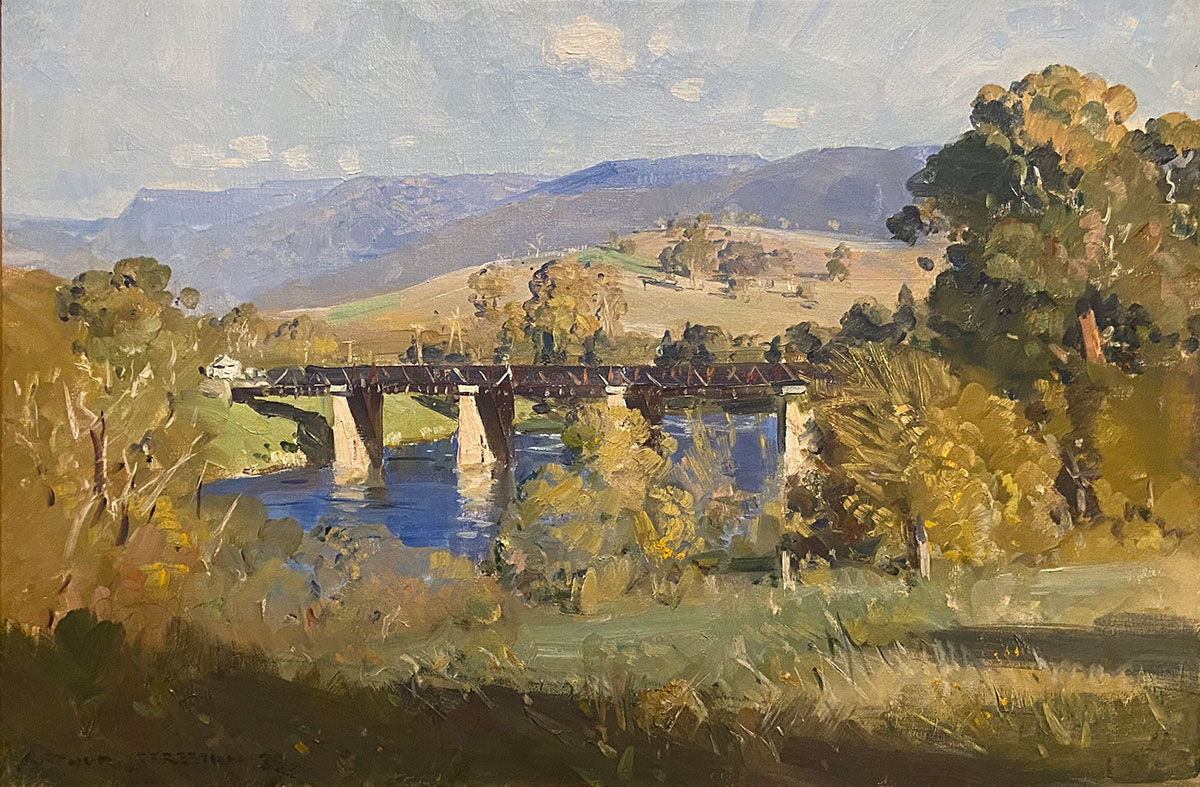
Austrian born Eugene von Guérard is best known for his dramatic views of the Australian bush, painted in the style of German romanticism.
Guérard’s canvases are known to translate the harsh Australian bush into the romantic tradition of the sublime. The ‘sublime’ was a German landscape movement that explored the presence of divine powers in nature through grandeur. The 1873 painting Mount Kent, on the Wonnangatta, Gipps Land captures the expansive mountain ranges of Victoria. Noted in a magazine in 1874 regarding his time in Mount Kent, Guérard stated, ‘the emu peoples the land, while birds of prey startle white cockatoos in the sky. The untamed grandeur of the scene is given a dramatic touch by profiling the mountain peaks against the sky. Yet, all is enveloped in a civilising calm of enchanting beauty.’
In 1870, Guerard had been appointed the first Master of the School of Painting and Curator of the National Gallery of Victoria, after the gallery had acquired two of his major paintings. Guerard’s work is held by all Australian state galleries.
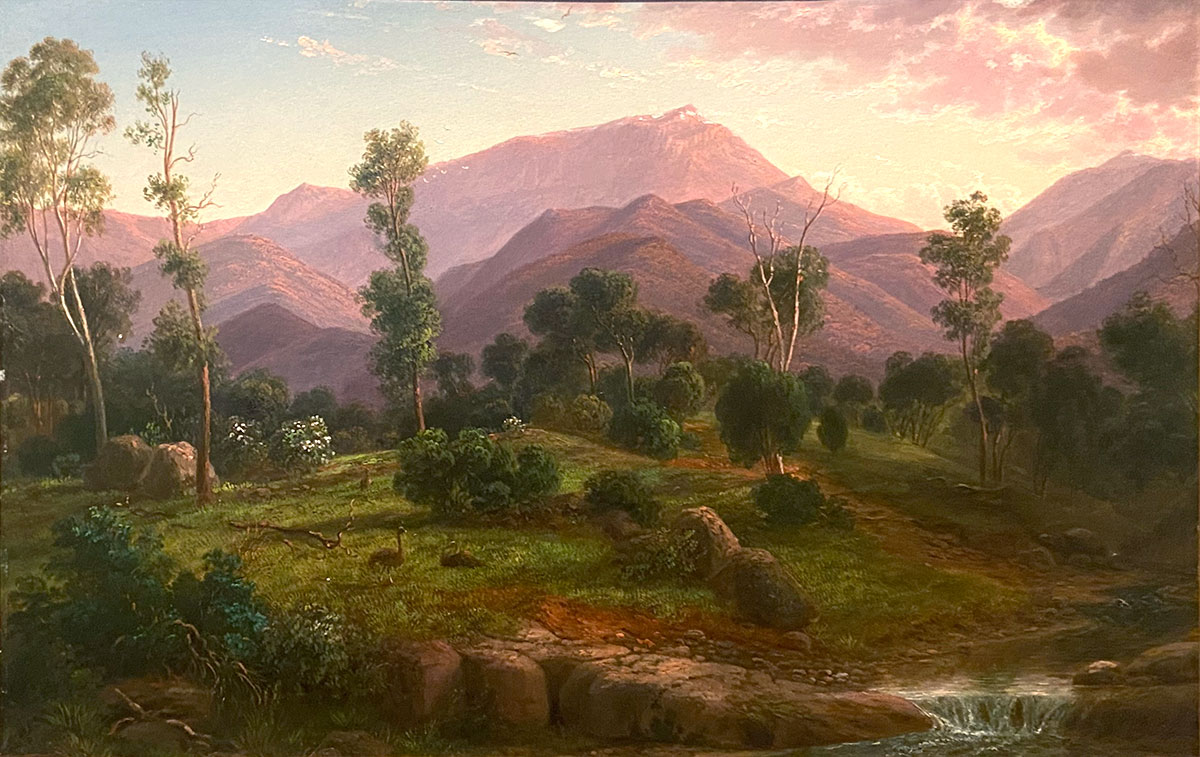
John Kelly is an internationally acknowledged painter and sculptor whose work has become instantly recognisable.
Throughout John Kelly’s career the motif of the ‘Dobell Cow’ has been used to explore Australian history and ingenuity. When World War II broke out, the artist William Dobell served as a camouflage labourer and was one of a group of several – later famous – artists who had been ordered to make papier-mache cows and move them around the base in the hope of fooling Japanese pilots.
The 2002 work Shadow on Aerial View is painted from a unique perspective. Here the viewer is looking not from the popular perspective of on the ground but from the air from where the viewer perceives the cows. The work implies a kind of pastoral surveillance – with some humour added for good reference.
Kelly’s work is held in a number of important Australian institutions including the Art Gallery of NSW, the National Gallery of Victoria and the National Gallery, Canberra.
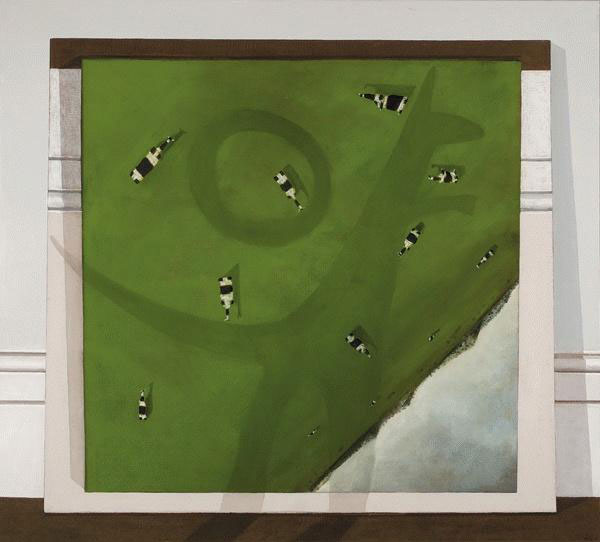
Arthur Streeton was one of Australia’s finest landscape painters. He was a forefather of Australian Impressionism and is often considered one of the most influential painters in Australia’s history of art since white settlement. His landscape paintings are not only an important part of his practice but they symbolise our changing relationship with this country throughout the late 19th and early 20th century.
In the early 1890s, Streeton established an artists’ camp at Sirius Cove, Mosman in Sydney. The 1895 work Sirius Cove is a fine example of the influence of French Impressionism on Streeton’s paintings. Streeton created a number of works (mostly small in scale) of Sirius Cove and each one explored the sharp Australian light and the natural beauty of the landscape along the harbour. The series remains one of Streeton’s most beloved.
Streeton’s work is held in the permanent collections of all State museums in Australia. He won the Wynne Prize in 1928 for the work Afternoon Light, Goulburn Valley.

Catherine Hickson, friend of the Forrest family, is a contemporary painter whose practice focuses on still-life.
Hickson’ process always begins with sketches and detailed tonal drawings before she begins to paint. For the artist, still-life painting is a place to explore relationships between objects, colour and light. Within her 2004 canvas Pears, Lemon and Jug, Hickson’s influences (as noted by the artist) are the 18th century French painter Chardin and the 20th century Italian painter Georgio Morandi. Similar to these artists, Hickson paints to understand stillness, composition and light in a deeply contemplative manner.
Hickson received her degree from the National Art School, Sydney in 1999 and in 2012 she was awarded her Masters in Art History and Museum Studies from the University of Sydney.
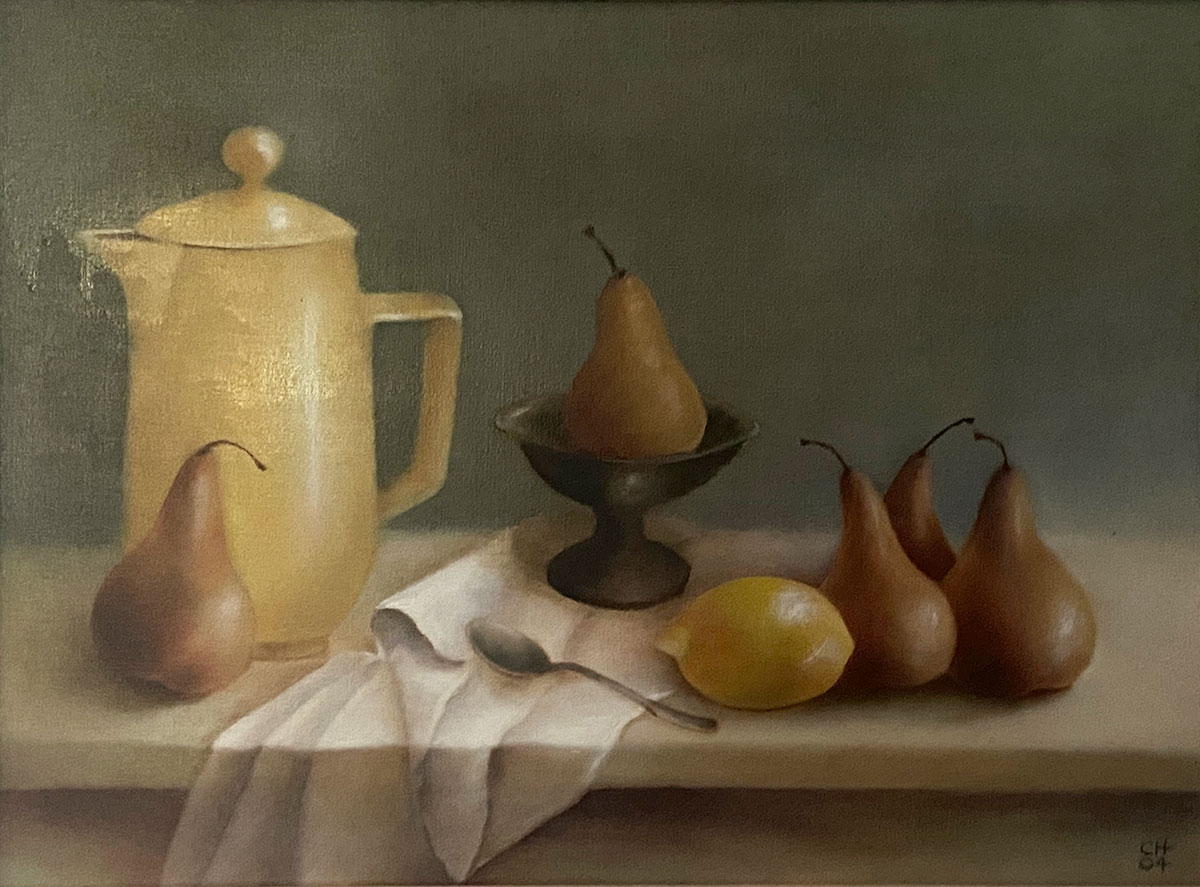
Ray Crooke was a highly influential Australian painter working in the 20th century and early 21st century.
In the painting Desert Landscape, Ray Crooke explores the vast, desolate nature of the outback. Crooke utilises dark colour tones against the flat desert plain and low horizon line to accentuate the expansiveness of his surroundings. The two figures under their dwelling are painted in a bright blue and white to draw the viewers’ attention. Overall, the scene is simplistic, open and authentically “Australian”.
In 1969, Crooke received the Archibald Prize for Portraiture and in 1993 he was awarded the Order of Australia. A major retrospective exhibition of Crooke’s work was held in 1997 at the Perc Tucker Regional Gallery in Townsville and toured nationally. Crooke is held in a number of major Australian public collections as well as overseas collections including the Vatican Collection in Rome.

Catherine Hickson’s classical training in oil painting supports her work across several genres. While the artist concentrates on still life compositions she also works in landscape, abstraction and assemblage.
When Hickson was cooking for her family of seven, her frequent trips to the green grocer inspired paintings of fruits and vegetables in season. The artist is interested in the subject of the changing of fruit as it ripens. The deepening hues of fruits as they change over time is conveyed in canvases such as the 2005 Apples, through bright and blurred brushwork.
Catherine has a background in art history and theory and completed her Master Museum Studies/Art History at the University of Sydney in 2014. Her work has been shown in the Glebe Art Show and the Festival on Forbes, Darlinghurst.

Arthur Streeton (1867-1943) was one of Australia’s finest landscape painters. He was a forefather of Australian Impressionism and is often considered one of the most influential painters in Australia’s history of art since white settlement. His landscape paintings are key to his practice and symbolise our changing relationship with this country throughout the late 19th century and early 20th century.
When Arthur Streeton painted Green Valley (c.1929-30), he was at the height of his fame. Art Critic Will Ashton wrote in 1929 that he knew of “no other artist who is painting better landscapes than those by Streeton”… “His unfailing sureness of the beauty in the sweeping green landscapes of the Australian valley is a source of genuine wonder.” Green Valley evokes emotions of the Australian pastoral ideal: abundant and full of life.
To quote art critic Harold Herbert’s review of Streeton’s 1931 exhibition in the Argus – “Streeton’s unerring vision and sense of colour and atmosphere in Australian landscape are unique”… “he is a master of his medium, the great thing is the lasting impression of a landscape filled with light, a valley panorama such as we know and enjoy.”
Streeton’s work is held in the permanent collections of all State museums in Australia. In 1929 Streeton was awarded the 1928 Wynne Prize.
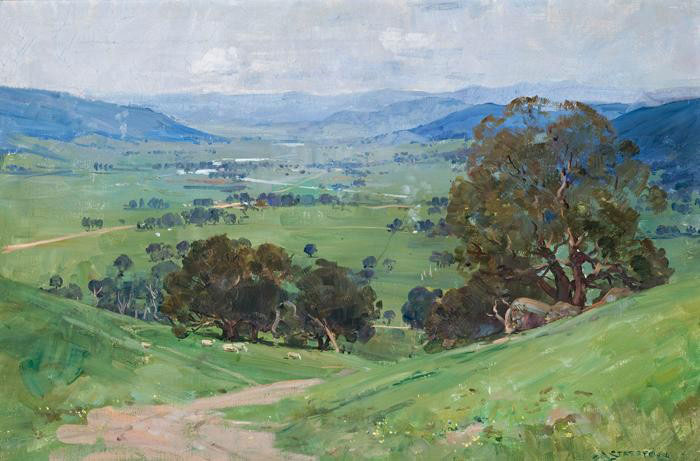
Frederick McCubbin is considered one of the most influential Australian artists of the late 19th century and early 20th century.
McCubbin’s 1890 canvas Summer Morning, Kew is an Impressionistic canvas that explores the rural landscape of the Melbourne suburb, Kew. The composition of the work is vertical, offering a slice of the landscape rather than capturing the entire surroundings. The focus is therefore placed on the two cows approaching the creek to drink, reflecting on the quiet, slow nature of pastoral Australia in the late 19th century. The painting stands as a historical reminder of Kew before its modern transformation into a bustling suburb.
Frederick McCubbin’s work is held in the permanent collection of all major State galleries.
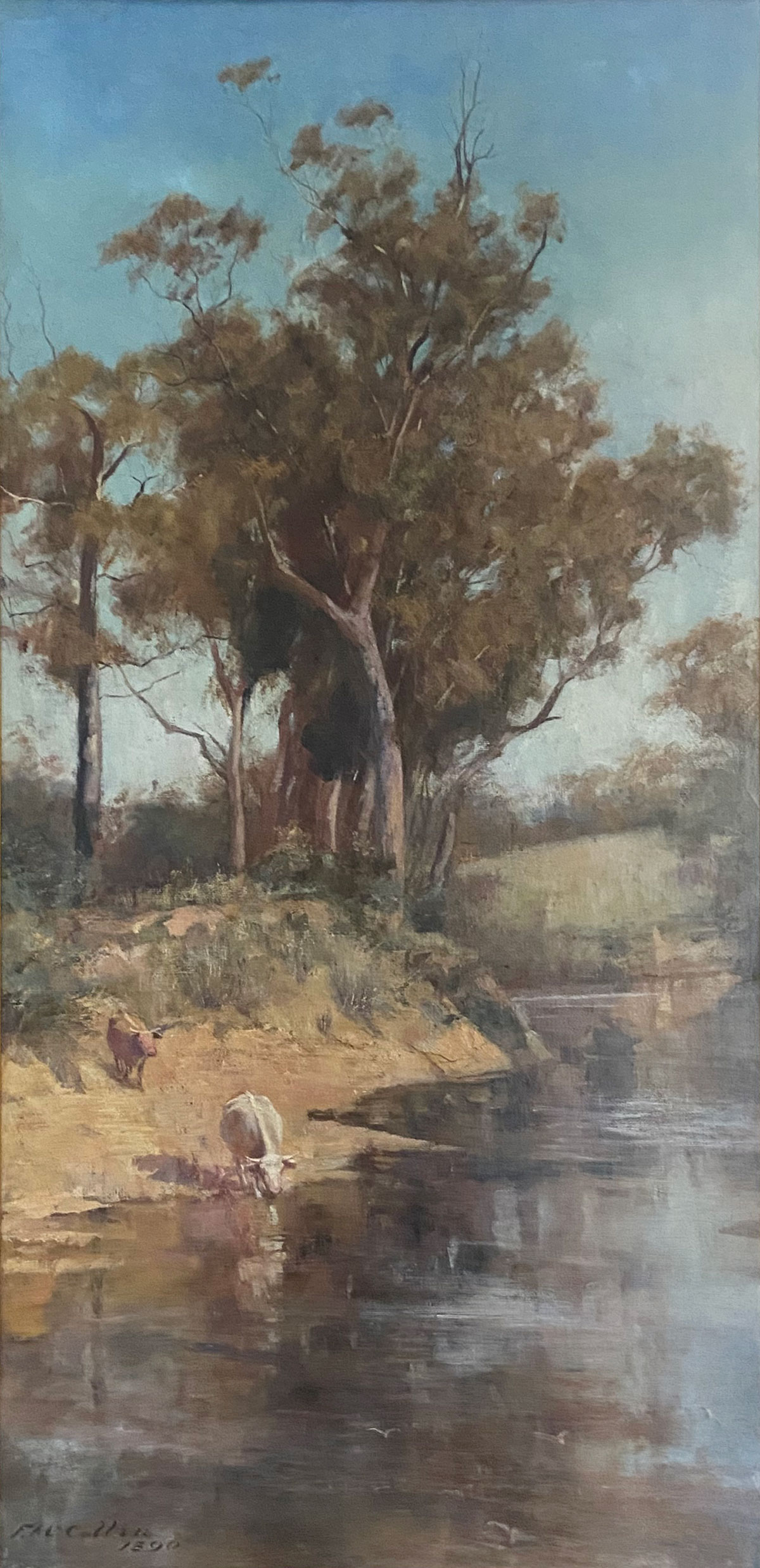
Hans Heysen was a German born Australian artist who became a household name in the early 20th century for his watercolour paintings of Australia’s monumental gum trees.
The 1932 oil painting Brachina Gorge illustrates the Australian gum tree within the arid, rocky landscape of the Southern Australian Flinders Ranges. In 1939 Heysen stated, “in all its stages the gum tree is extremely beautiful—first for being a tiny sucker with broad leaves, shooting up like a fountain answering to the slightest breeze—at middle age it becomes sturdy, more closely knit and bulky, yet never losing grace in the movement of its limbs and the sweep of its foliage.” For Heysen, the gum tree wasn’t just a part of the landscape but an important central subject in how he portrayed the Australian national identity.
From 1904 to 1932 Heysen won the Wynne prize a record nine times, the painting Brachina Gorge winning in 1932. In 1945 he was appointed an Officer of the Order of the British Empire for his service as trustee of the Hobart National Gallery. His work is held by all major State galleries.

This painting was created by a friend of the family, Jann Rowley, and offers an artistic snapshot of life on Minderoo Station.
A few key elements punctuate the scene including a stockman on horseback in the foreground with an obedient dog, a windmill (pumping precious water supply), an aeroplane in the upper corner overseeing the vast landscape, and what appears to be a golden river fl owing through the centre of the composition.
The painting’s perspective is purposefully ambiguous with the rocky hills, sandy mounds and eucalypts lined up before us – one horizontal band of visual information hovering over the next. Verging on abstraction, this work is a poem about life at Minderoo Station.

Guy Edward Grey-Smith was a Western Australian painter and one of the most significant Australian artists from the 20th century. Often travelling through the Kimberly and Pilbara, Grey-Smith had a deep attachment to the state of Western Australia.
The 1966 canvas Old Mine at Nannine offers a historical reflection of the ghost town, Nannine. The town was a former gold mining town, the site of the first discovery on the Murchison Goldfield in Western Australia. The town was in serious decline by 1919 and by Grey-Smith’s visit in 1966 it was long gone. Now all that remains is a railway platform and information sign represented by the black structure in the painting. Grey-Smith uses thick and undetailed brush strokes to create an eerie, faded memory of the rural Western Australian gold rush town.
Grey-Smith was represented in several international exhibitions of contemporary Australian painting and between 1955 and 1978 won eleven important Australian art prizes including the Walter Murdoch Prize. His work is represented in all major State galleries.

Guy Edward Grey-Smith was a Western Australian abstract painter and one of the most significant Australian painters from the 20th century. Often travelling through the Kimberly and Pilbara, Grey-Smith had a deep attachment to the state of Western Australia and its unique landscape.
Grey-Smith’s 1966 canvas Salt Lake is an almost abstract, thick oil painting that illustrates the colourful, bold Australian landscape. While it’s unknown which lake is portrayed, the pink tones suggest Grey-Smith is portraying one of the bright Western Australian pink lakes. The thick blocks of colour capture the vibrancy and massive scale of the lakes found in the Southern region of the state.
Grey-Smith was represented in several international exhibitions of contemporary Australian painting and between 1955 and 1978 won eleven important Australian art prizes including the Walter Murdoch Prize. His work is represented in all major State galleries.

Hans Heysen was a German-born Australian artist who became a household name in the early 20th century for his paintings of Australia’s monumental gum trees.
The 1926 painting The South Coast, Victor Harbour is a watercolour on paper that was painted in the South Australian town of Victor Harbour. Heysen developed a meaningful connection to South Australia after settling with his wife in the town of Verdun, east of Adelaide. Heysen’s paintings rarely dealt with the subject of the seaside, more often focusing on the rural landscape. Due to this, the work Victor Harbour offers a unique lens into lesser known aspects of Heysen’s practice and his personal life.
From 1904 to 1932 Heysen won the Wynne prize a record nine times, the painting Brachina Gorge winning in 1932. In 1945 he was appointed an Officer of the Order of the British Empire for his service as trustee of the Hobart National Gallery. His work is held by all major State galleries.

Arthur Boyd is recognised as one of Australia’s most important artists from the middle of the 20th century. As a member of the 1950s Antipodean figurative art movement, Boyd has had a wide influence over the development of Australian art.
In 1937 (aged 17), Arthur Boyd moved to a family cottage at Rosebud on the Mornington Peninsula with his grandfather, the painter Arthur Merric Boyd Snr. During his three-year tenure at Rosebud, Boyd painted numerous landscapes such as the 1940 beach scene Rosebud. Art Historian Patricia Dobrez stated that, “most of the oil landscapes Arthur produced in this period emphasised flat planes, toying with colour in a way which tended towards abstraction, while delicacy of tone, impasto brushstrokes and sudden appreciation of detail introduced a lyricism reminiscent of Streeton.” This painting clearly indicates the promise of talent for the then 20 year old artist.
Arthur Boyd’s work is held in all major State public galleries.

Guy Edward Grey-Smith was a Western Australian abstract painter and one of the most significant Australian painters from the 20th century. Often travelling through the Kimberly and Pilbara, Grey-Smith had a deep attachment to the state of Western Australia.
From 1945 to 1947, Grey-Smith studied at the Chelsea School of Art under Henry Moore and Robert Medley. After his time in Europe, the artist’s practice became strongly influenced by Paul Cézanne as seen in his 1946 Self Portrait through the definitive forms depicted in strong colours. The bright shading on the side of Grey-Smith’s head is a direct nod to Cezanne’s 1879 Self Portrait, tethering his identity directly to the French Impressionist.
Grey-Smith was represented in several international exhibitions of contemporary Australian painting and between 1955 and 1978 won eleven important Australian art prizes including the Walter Murdoch Prize. His work is represented in all major State galleries.

Guy Grey-Smith AM was an Australian painter, printmaker and ceramicist. Grey-Smith pioneered modernism in Western Australia, and has been described as one of Australia’s most significant artists of the 20th century.
In 1945, Guy Grey-Smith began studying at the Chelsea School of Art, learning under Henry Moore. After moving home, Grey-Smith formed the Perth Group in the late 1950s with fellow artists Robert Juniper, Brian McKay, Tom Gibbons and Maurice Stubbs. The group’s aim was to promote European modernism, which was not yet accepted in Australia.
The 1967 work Seated Nude is a charcoal study of a human figure. Grey-Smith was strongly influenced by the work of Paul Cézanne and through the Seated Nude similarities can be drawn between both artist’s representation of the human form.
His work is held in the collection of the Art Gallery of Western Australia and the University of Western Australia.

John Ogburn worked for three years as an industrial research chemist before turning away from a career in science and taking up art full-time. After his first one-man exhibition at the Macquarie Gallery in 1953, Ogburn sailed for Europe and studied in museums and galleries until his return in 1957. From there he conducted an art teaching studio in Sydney part-time while continuing to develop his painting.
John Ogburn’s Landscape is a small watercolour that feels immediate and responsive to the artists’ surroundings. The brush strokes and lines are executed with pace in order to capture a fleeting moment in the Australian bush. The clouds in the background are half painted with unfinished outlines suggesting fast moving winds. Although Ogburn’s watercolour isn’t highly detailed, it is an authentic reflection of the scale and energy of the Australian landscape.
A leading 20th century American art critic, Clement Greenberg, who saw Ogburn’s work when visiting Sydney in 1979 recognised its inherent qualities and wrote, “John Ogburn has his own kind of newness, the kind that belongs to the truly ‘complete’ painter. There haven’t been all that many such.”

John Ogburn worked for three years as an industrial research chemist before turning away from a career in science and taking up art full-time. After his first one-man exhibition at the Macquarie Gallery in 1953, Ogburn sailed for Europe and studied in museums and galleries until his return in 1957. From there he conducted an art teaching studio in Sydney part-time while continuing to develop his painting.
In Hillview Through the Trees, Ogburn manipulates light and perspective to create a vast landscape rich with rolling hills and bountiful pastures. The mountain in the far background creates a focal point that lures the viewer into the large, quiet expanse of rural Australia.
A leading 20th century American art critic, Clement Greenberg, who saw Ogburn’s work when visiting Sydney in 1979 recognised its inherent qualities and wrote, “John Ogburn has his own kind of newness, the kind that belongs to the truly ‘complete’ painter. There haven’t been all that many such.”
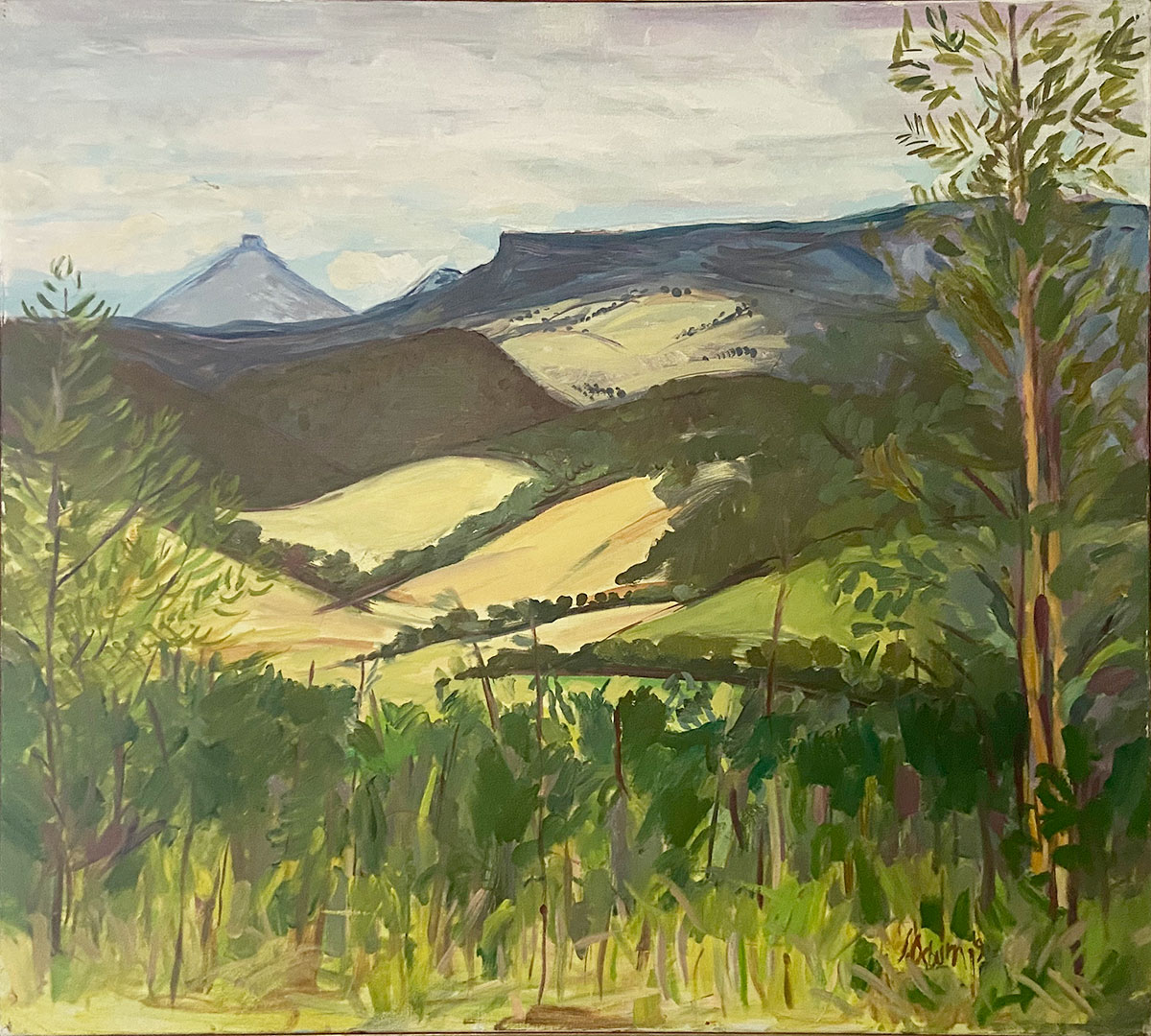
Working from a studio in Quindalup in the south west of Western Australia, Mary Knott is an artist who works in both two and three dimensions, making sculptures and mixed media drawings.
Using a muted palette, Knott’s images are enigmatic and leave an ambiguous impression for the viewer. The work Italian Scene is a quiet picture with an inviting charm. We stand from the viewpoint of the outskirts of the city walls looking into the community below. Knott here evokes ideas of exploration and the desire for people to look further.
Knott’s work is held in a number of important public collections including the University of Western Australia, Perth, Parliament House, Canberra and the Art Gallery of Western Australia, Perth.

Roland Wakelin was a central figure in the development of modernist Australian art during the early to mid 20th century.
From the mid 1930s until the 1960s, Wakelin’s works were predominately regional landscapes and urban scenes characterised by romantic, moody light and shadow. Wakelin’s 1945 canvas Hayes Street, Neutral Bay is a suburban afternoon scene that offers reflection upon Sydney’s past bustling tram network. The track down Hayes Street was the steepest hill in Sydney without specially fitted brakes, Wakelin captures this through the precarious placement of the tram on the very edge of its rails.
Referring to these ‘softly lit’ landscape scenes, collector Leslie Walton wrote, ‘in these landscapes there is an absence of the traditional preoccupation with the effects of the hot sun, the electric blue skies, the brittle torrid climate so frequently felt and represented in Australian painting. They have a rich, luminous effect more akin to the subdued tonality of Constable.’
Wakelin’s work is held in the Art Gallery of New South Wales, Sydney, National Portrait Gallery, Canberra and the National Gallery of Victoria, Melbourne.
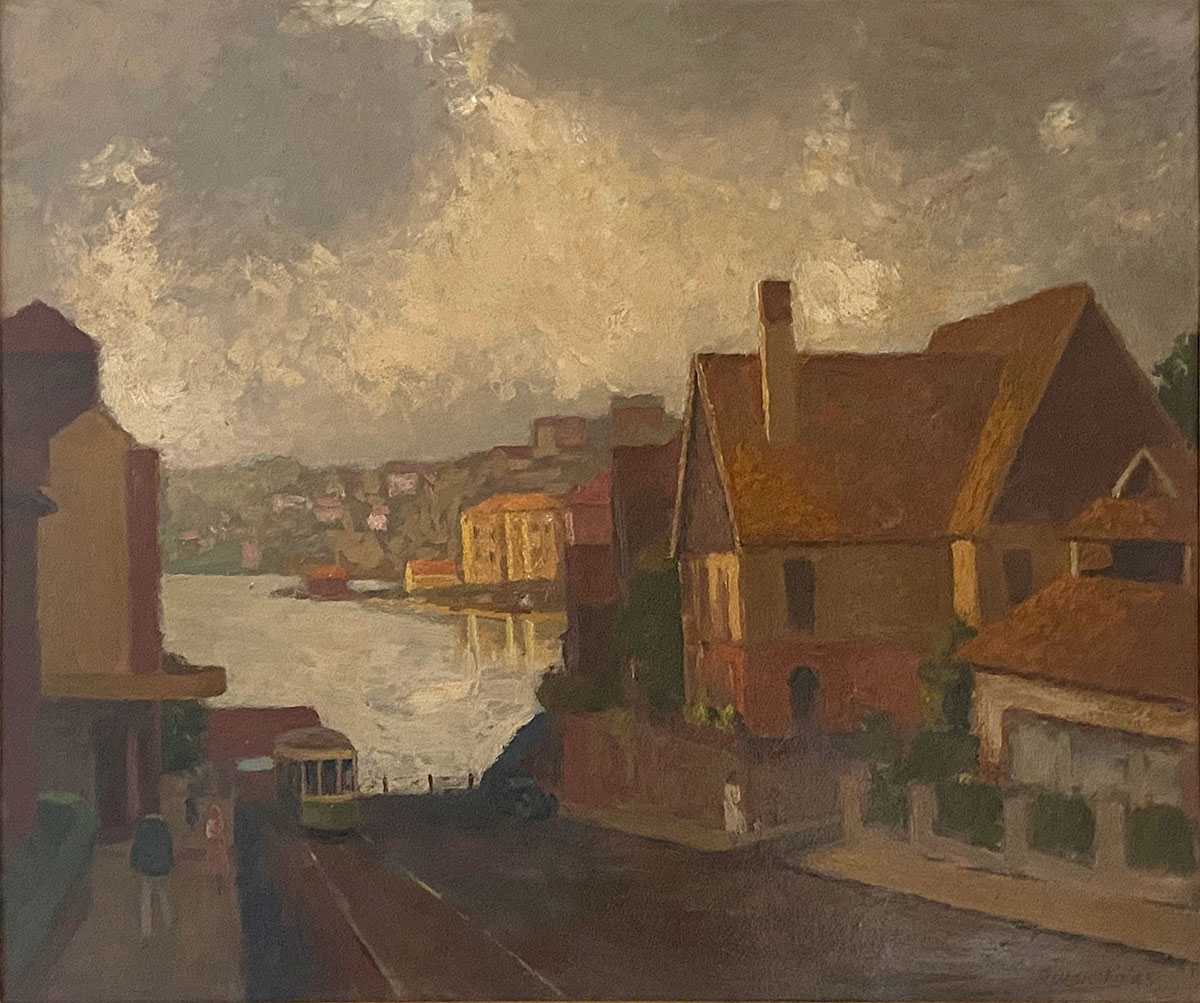
Albert (Elea) Namatjira is one of the most critically acclaimed Australian artists of the 20th century. He was one of the foremost painters from the Hermannsburg School, painting in a style that developed at the Northern Territory Hermannsburg Mission in the 1930s. Artworks from this era are characterised by watercolours and European-style landscapes that depict the striking unique colours of the Australian outback. Namatjira became highly influential and popular thanks to this ‘modern’ visual language depicting an ancient place.
The painting Near Hermannsburg, Central Australia, is an accurate portrayal of the Hermannsburg school style with its washes of cool purple and blue tones that soften the often brutal and raw palette of the Australian landscape. There is a deeply rooted connection between the artist and the land, felt through the works’ softness and the acknowledgement for the details of the scene.
Namatjira’s work is held at all Australian state museums and at the British Museum in London. Namatjira was awarded the Coronation Medal in 1953 by Queen Elizabeth II. In 1955 he was elected as an honorary member of the Royal Art Society of New South Wales.
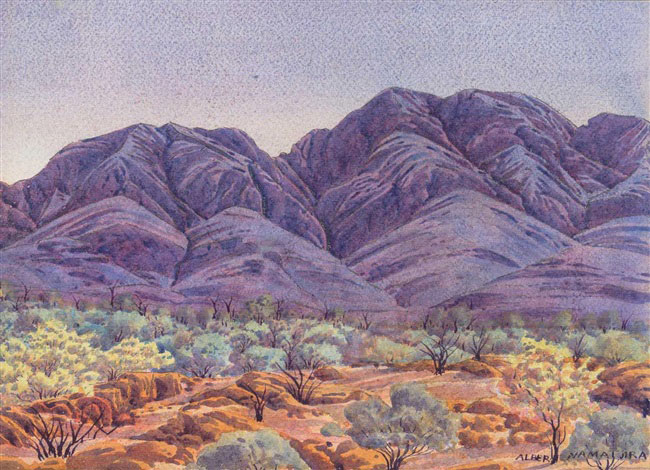
Albert (Elea) Namatjira is one of the most critically acclaimed Australian artists of the 20th century. He was one of the foremost painters from the Hermannsburg School, painting in a style that developed at the Northern Territory Hermannsburg Mission in the 1930s. Artworks from this era are characterised by watercolours and European-style landscapes that depict the striking unique colours of the Australian outback. Namatjira became highly influential and popular thanks to this ‘modern’ visual language depicting an ancient place.
The 1958 watercolour The Bend of the Todd, Heavitree Gap is a quintessential Namatjira view of the dried-out riverbed of the Todd River, which ran through Ntaripe. Ntaripe is a gap in the McDonnell Ranges that provides a Southern entrance to Alice Springs. It features the jewel-like tones and delicate textures typical of Namatjira’s practice, applied to scenes of his father’s country. Using his familiarity with a camera’s viewfinder, Namatjira was able to create a tightly cropped and carefully observed composition framed by ghost gums, featuring an accurate depth of field.
Namatjira’s work is held at all Australian state museums and at the British Museum in London. Namatjira was awarded the Coronation Medal in 1953 by Queen Elizabeth II. In 1955 he was elected as an honorary member of the Royal Art Society of New South Wales.
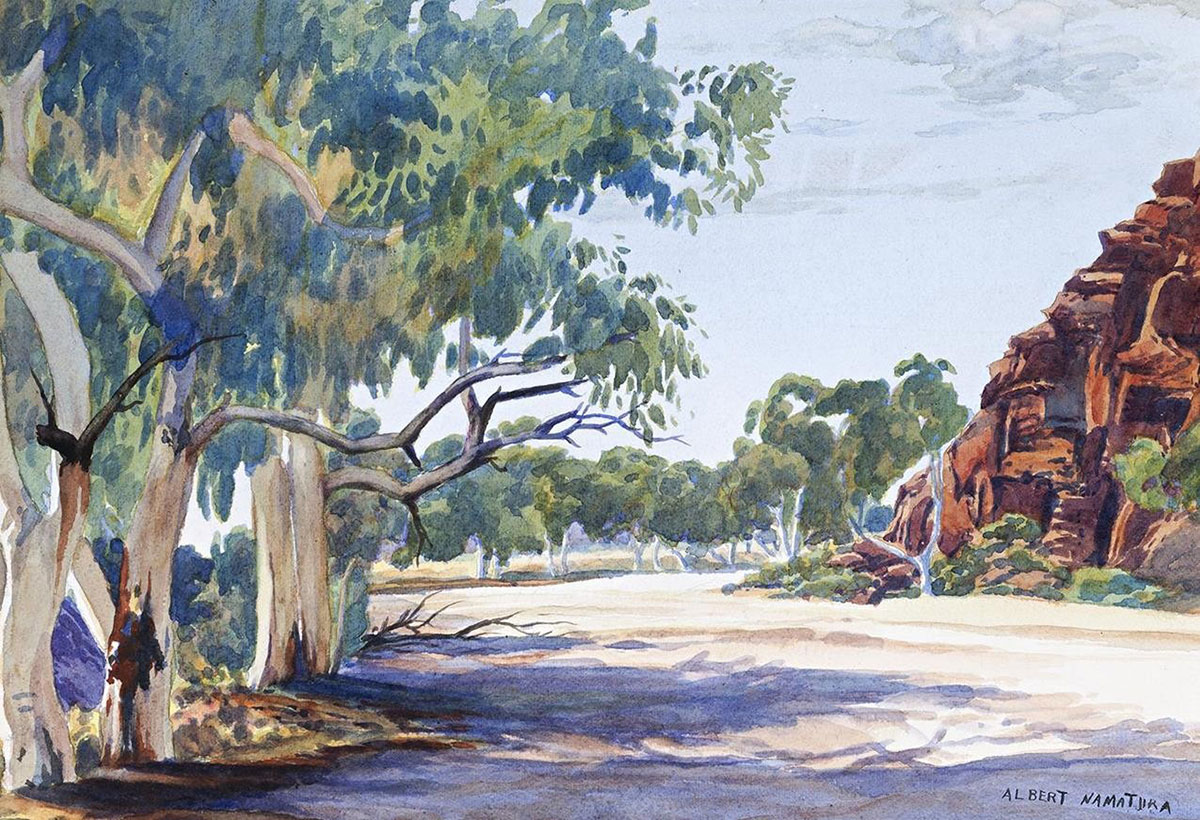
John Ogburn worked for three years as an industrial research chemist before turning away from a career in science and taking up art full-time. After his first one-man exhibition at the Macquarie Gallery in 1953, Ogburn sailed for Europe and studied in museums and galleries until his return in 1957. From there he conducted an art teaching studio in Sydney part-time while continuing to develop his painting.
Ogburn’s Poppies and Irises is a cheerful still-life painting that explores the artist’s everyday surroundings. Ogburn utilises clear decisive brushstrokes and bright colour tones to reflect this radiant domestic setting. Golden light indicates the sunlight shining from the top right corner of the canvas whilst the background transitions into a darker blue on the left, illustrating Ogburn’s masterful use of light and colour.
A leading 20th century American art critic, Clement Greenberg, who saw Ogburn’s work when visiting Sydney in 1979 recognised its inherent qualities and wrote, “John Ogburn has his own kind of newness, the kind that belongs to the truly ‘complete’ painter. There haven’t been all that many such.”
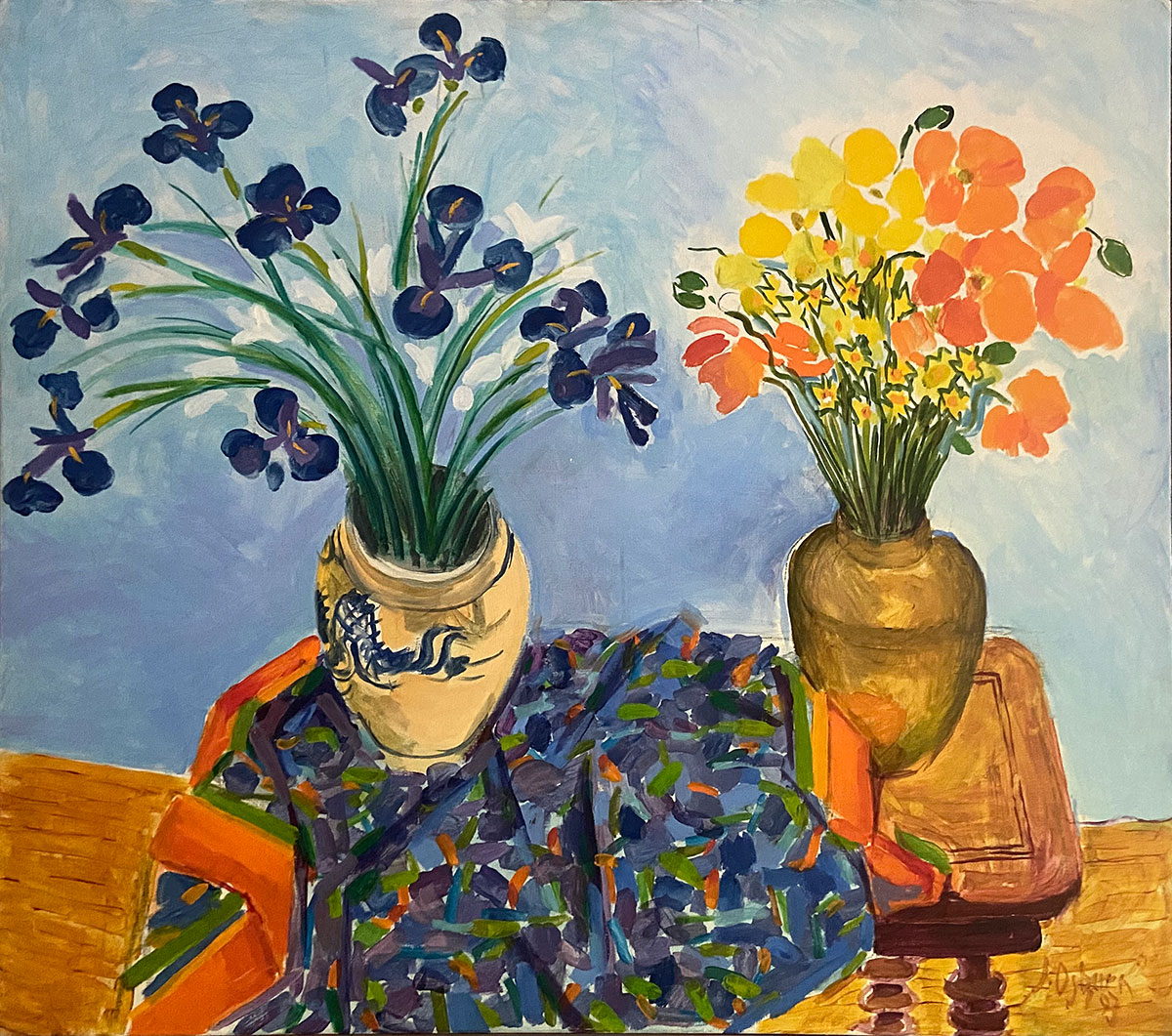
David Gregson is one of Western Australia’s most highly regarded figurative painters, whose career spanned over 50 years.
Rottnest is a work on paper that depicts a bustling scene within Rottnest Island off the coast of Western Australia. The scattered bikes reference the popular way of commuting around the island and explores Rottnest as a melting pot of Western Australians and tourists enjoying the natural landscape.
Gregson studied at the Ecole Nationale Superieure des Beaux-Arts in Paris in 1955. His works are held in the collection of the Art Gallery of Western Australia.

Albert (Elea) Namatjira is one of the most critically acclaimed Australian artists of the 20th century. He was one of the foremost painters from the Hermannsburg School, painting in a style that developed at the Northern Territory Hermannsburg Mission in the 1930s. Artworks from this era are characterised by watercolours and European-style landscapes that depict the striking unique colours of the Australian outback. Namatjira became highly influential and popular thanks to this ‘modern’ visual language depicting an ancient place.
The work Ghost Gum, Central Australia showcases Namatjira’s sweeping landscapes and unique colour palette. The white gum in the foreground plays a pivotal role as a device for opening and framing the picture plane, grounding the viewer in place. The distant mountain ranges give the Australian landscape a sense of dramatic grandeur as they roll beyond the borders of the paper.
The Art Gallery of New South Wales writes, “initially thought of as having succumbed to European pictorial idioms – and for that reason, to ideas of European privilege over the land – Namatjira’s landscapes have since been re-evaluated as coded expressions on traditional sites and sacred knowledge. Ownership of country is hereditary, but detailed knowledge of what it ‘contains’ is learnt in successive stages through ceremony, song, anecdote and contact.”
Namatjira’s work is held at all Australian state museums and at the British Museum in London. Namatjira was awarded the Coronation Medal in 1953 by Queen Elizabeth II in person. In 1955 he was elected as an honorary member of the Royal Art Society of New South Wales.
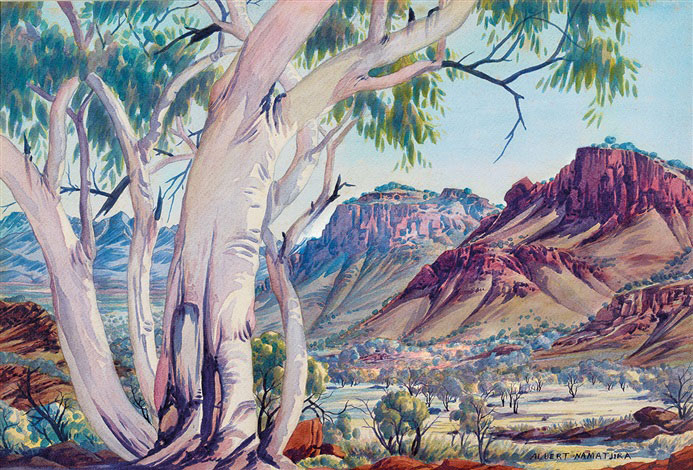
Vincent Nanala is a Western Australian painter from the Balgo Community. He paints in the Pintupi style of art characterised by strong line work and a minimal palette. Nanala learned this optical painting style from his father, renowned Warlayirti artist Tjumpo Tjapanangka (deceased).
Nanala completed his schooling in Balgo and has lived there most of his life, travelling to Kiwirrkurra regularly to visit his family. The Country Nanala paints in Marua is far south of Balgo near Lake Mackay, named Ngukanpalikarr. The creation stories and lore of the area are based on the snake Tjukurrpa. The artists’ father built a well on this Country so families could regularly visit and look after it.
In 2022, Nanala was a Finalist in the Jury Art Prize at Port Hedland and in 2021, his work was shown by Calvin Morris Gallery in New York City.

Lynn Chadwick is one of Britain’s most celebrated 20th century sculptors.
The 1988 work Back to Venice represents a moment of reflection and retrospection for the artist as he looked back on a seminal moment in his career: his ground-breaking exhibition at the twenty-eighth Venice Biennale in 1956, where he was awarded the prestigious International Grand Prix for Sculpture. He was also included in the group show of young British sculptors at the Venice Biennale in 1952.
The sharp angles of the sculpture are carefully calculated to instil the figures with a certain ‘attitude,’ an element of the language of sculpture which Chadwick saw as essential to the power and character of his figures. Through the angles of the figure, the subtle bending of their neck, the positioning of the head or the weight within the body, Chadwick believed he could make his sculptures ‘speak’. As he once noted, ‘if you can get their physical attitudes right,’ Chadwick explained, ‘you can spell out a message.’
Famous for his large-scale bronze, Chadwick’s works are held in numerous important institutional collections such as MoMA in New York, the Tate in London and the Centre Georges Pompidou in Paris.
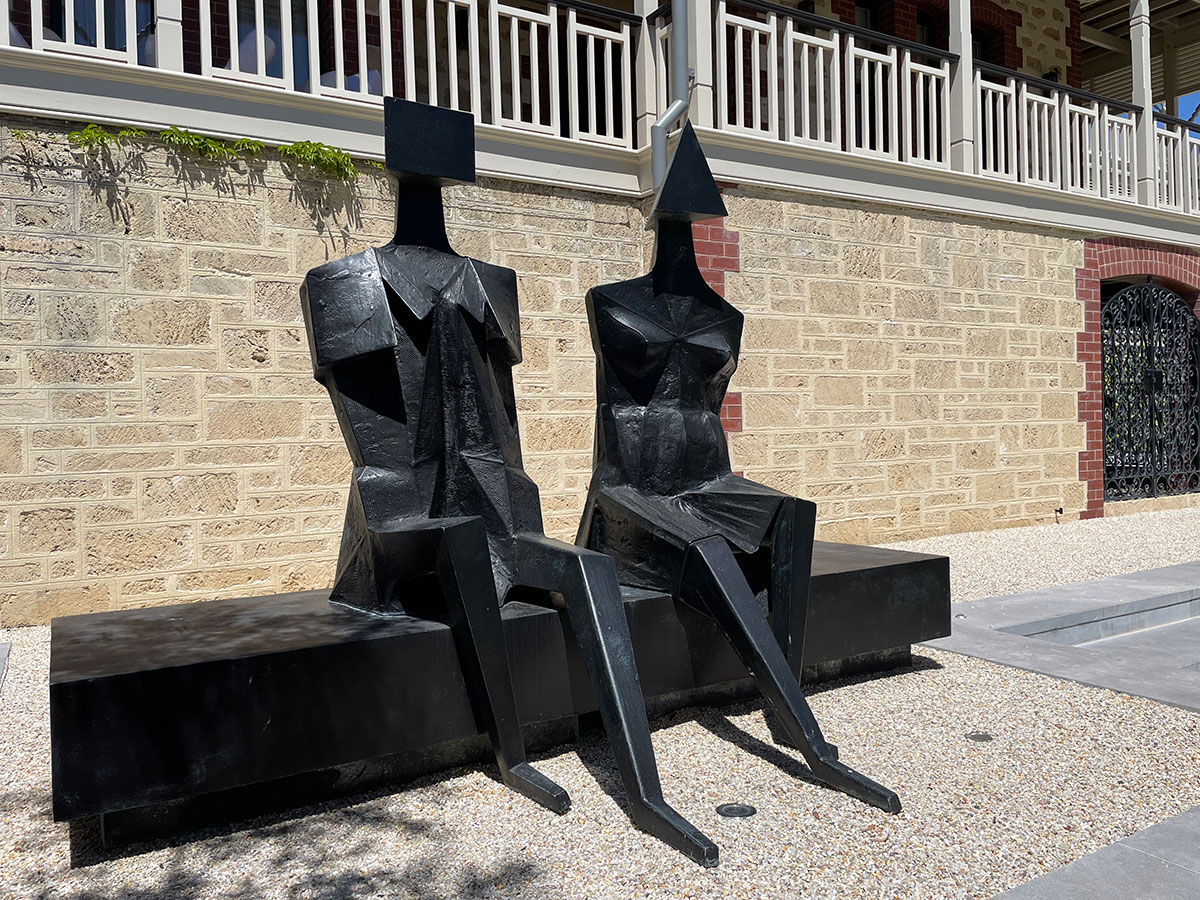
Lynn Chadwick is one of Britain’s most celebrated 20th century sculptors.
In the late 1970s and early 1980s Chadwick begun an exploration of drapery over the human form which developed into a focus on the effects of wind. The 1990 sculpture High Wind III explores the physical possibilities of pausing time as a single figure stands static in motion as a gust of wind hits them. The figure’s hair is blown over her face, eclipsing her identity. Her skirt is propelled forward which allows Chadwick to explore curved forms within this angled sculpture. The figure exemplifies the dynamic naturalism of his 1980s period, which saw Chadwick explore a whimsical style of everyday life with billowing drapery and bodies in motion.
Famous for his large-scale bronze, his work held in numerous important institutional collections such as MoMA in New York, the Tate in London and the Centre Georges Pompidou in Paris.
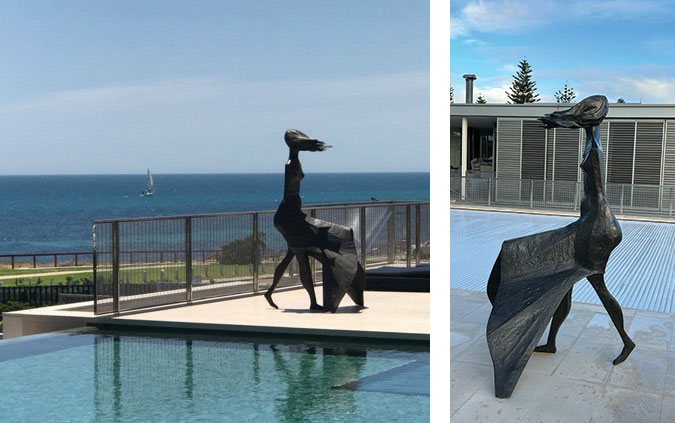
Jina Lee was born in South Korea and immigrated to Australia in 2013. Lee began her journey as a sculptor in 1999 after being accepted into the Kaywon School of Arts in South Korea.
Lee specialises in stone sculptures inspired by organic forms. Her practice uses traditional techniques of chiselling and polishing to present a tactile and timeless finish. The 2018 sculpture Cluster is carved out of marble, giving the appearance of a curved, voluptuous yet unintelligible organic form. The work illustrates Lee’s emphasis on abstract natural creations placed within the familiar landscape settings such as a beach. Despite its weight and physicality, the sculpture also holds a sense of lightness, like bubbles that have just landed on a surface.
Lee’s stone sculptures are installed in public collections internationally, including Australia (WA, SA), Italy, Albania, Japan and South Korea. She has shown her work at Sculpture at Bathers in 2015, 2017, 2020 and Sculpture by the Sea from 2015 to 2021.

Takeshi Tanabe is a sculptor from Yamaguchi, Japan. He attended the Aichi Prefectural University of Fine Arts in the 1970s and is now recognised internationally for his large-scale sculptural pieces.
Tanabe’s Origin 19-2 is part of a series of works within his ‘Big Bang Symphony’ that is concerned with the intersection of water, time and space. The works are made of stone where seawater is sealed within. For the UBE Biennale (Origin 19-1) and Sculpture by the Sea Bondi 2019 (Origin 19-2), Tanabe encouraged people throughout Japan and all over the world to participate in the work by sending seawater from their locality to seal within the work. The philosophy behind the work relates to issues around environmental pollution in oceans and waterways and the impact of garbage on life. With the water sealed within the sculpture, the stone becomes a vessel and time capsule of the vastness of the world’s oceans.
Tanabe often shows at Sculpture by the Sea Cottesloe and Bondi and has shown at international sculpture shows in Austria, Yugoslavia and China.

Francis Upritchard is an artist whose work draws from figurative sculpture, craft traditions and design, with references from literature and history. Her exhibitions typically showcase sculptures in a variety of materials including polymer plastic, natural balata rubber, bronze, glass, ceramic, and works on paper.
Ceramics have long been key amongst these for Upritchard, and Atlas Holds Universe with Feet is a relatively large work in this medium in the form of a vase. The ceramic is stoneware, thrown and woodfired in rural New Zealand. The shape and material of the work recalls ancient pottery vessels and more recent craft traditions. The work’s titular subject is hand painted as glaze: Atlas, the mythological Greek Titan condemned to hold the heavens for eternity.
Francis Upritchard lives and works in the United Kingdom, Italy, and New Zealand. She was born in New Plymouth, New Zealand in 1976. Upritchard represented New Zealand at the 53rd Venice Biennale and has made exhibitions at museums and institutions worldwide. The Art Gallery of New South Wales recently unveiled Upritchard’s new large-scale commission of bronze figures ‘Here Comes Everybody’ for the Welcome Plaza of Sydney Modern.
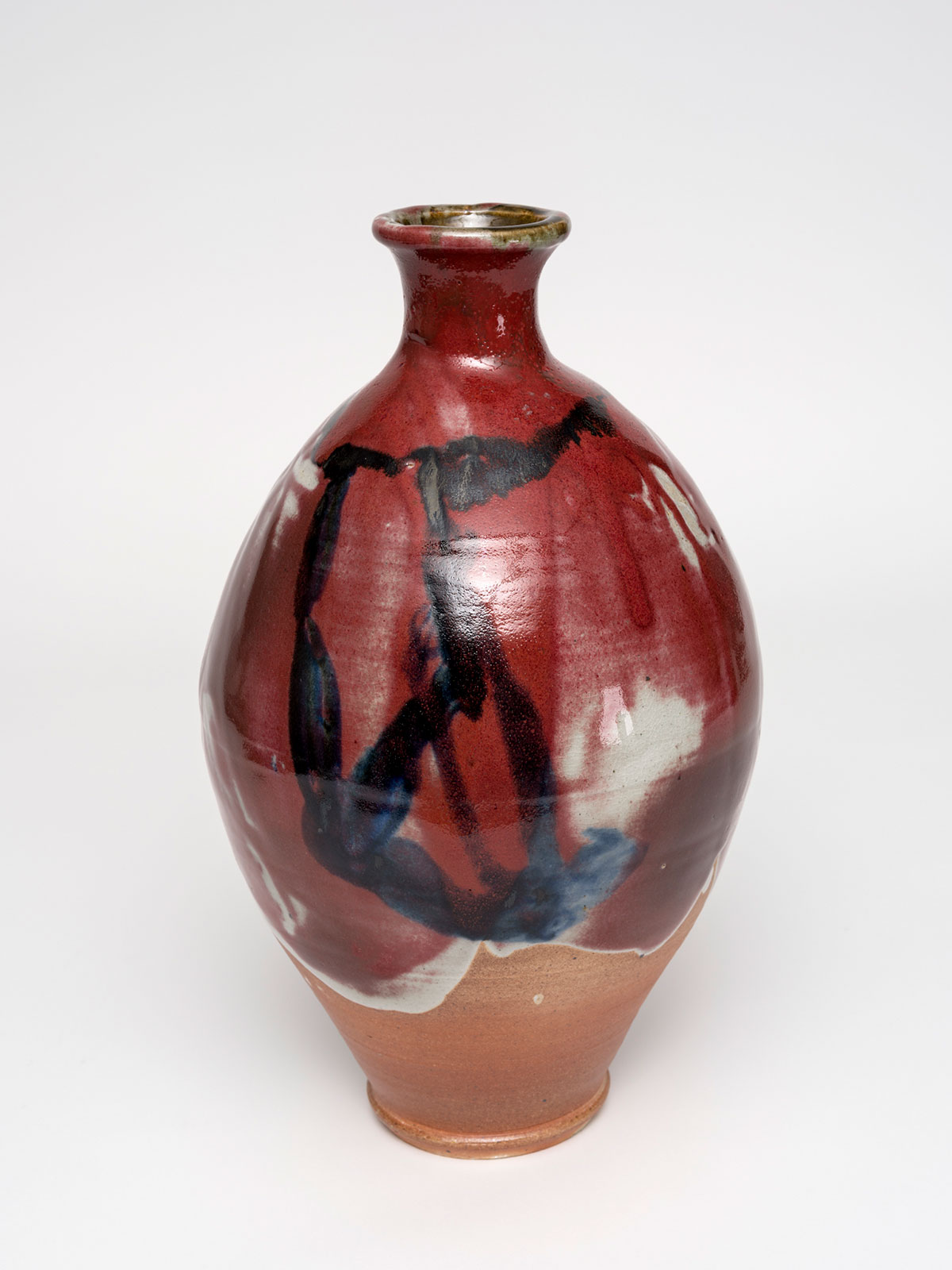
Tania Spencer is a sculptor who works in Lake Grace, Western Australia.
Regarding the copper wire work Mantle, Spencer stated “in this time of worldwide uncertainty we notice the return to a simpler life; family, nature and creativity contribute a rich sustenance for existence. I looked amongst my shell collection inherited from my Nanna and found a clamshell. I’ve created a form inspired by nature to hover over and protect you.”
Tania has exhibited in Sculpture by the Sea 9 times in Cottesloe and Bondi twice. She has won the Bunbury Biennale acquisition prize and the prestigious National Bank Western Australian Sculptors Scholarship. Other national exhibitions include the Powerhouse Museum, Sydney and the Textile Triennial in Tamworth, NSW.

Cui Yi is a Chinese sculptor whose work explores the ecological forms found in everyday life.
The work Water Drop is constructed from steel bars, inspired by a computer-generated shape of a falling drop. Yi elevates distorted industrial materials to imitate the natural growth of organic structures. The work therefore presents a symbiotic living state and ecological relationship between human-made and natural forms.
Cui Yi’s work has been featured a number of times at Sculpture by the Sea, Australia.
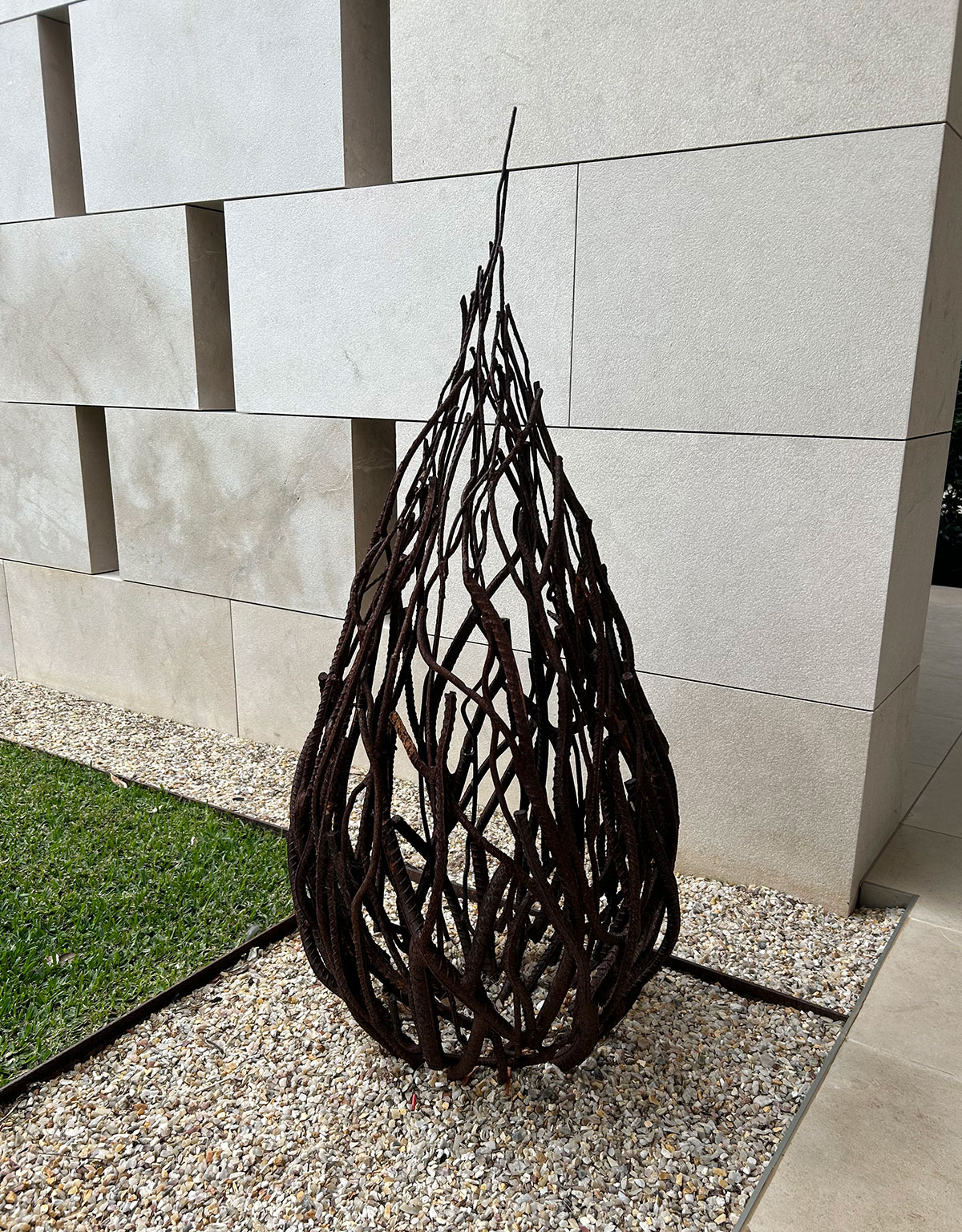
Tsutomu Matsunaga’s practice focuses on the rhythmic balance of reflection, light and shape in nature.
The work Beginning of Landscape was shown in the 2017 Cottesloe Sculpture by the Sea. The artist created this work in three pieces to warp the landscape they are placed within. The works installed next to one another create a conversation as their shining surfaces bounce off of one another, expanding the world around them.
Matsunaga has been shown on multiple occasions at in Sculpture by the Sea, both in Cottesloe and Surry Hills. In 2012, he was included in the 25th Ube Biennale at the Tokiwa Museum in Ube, Japan.
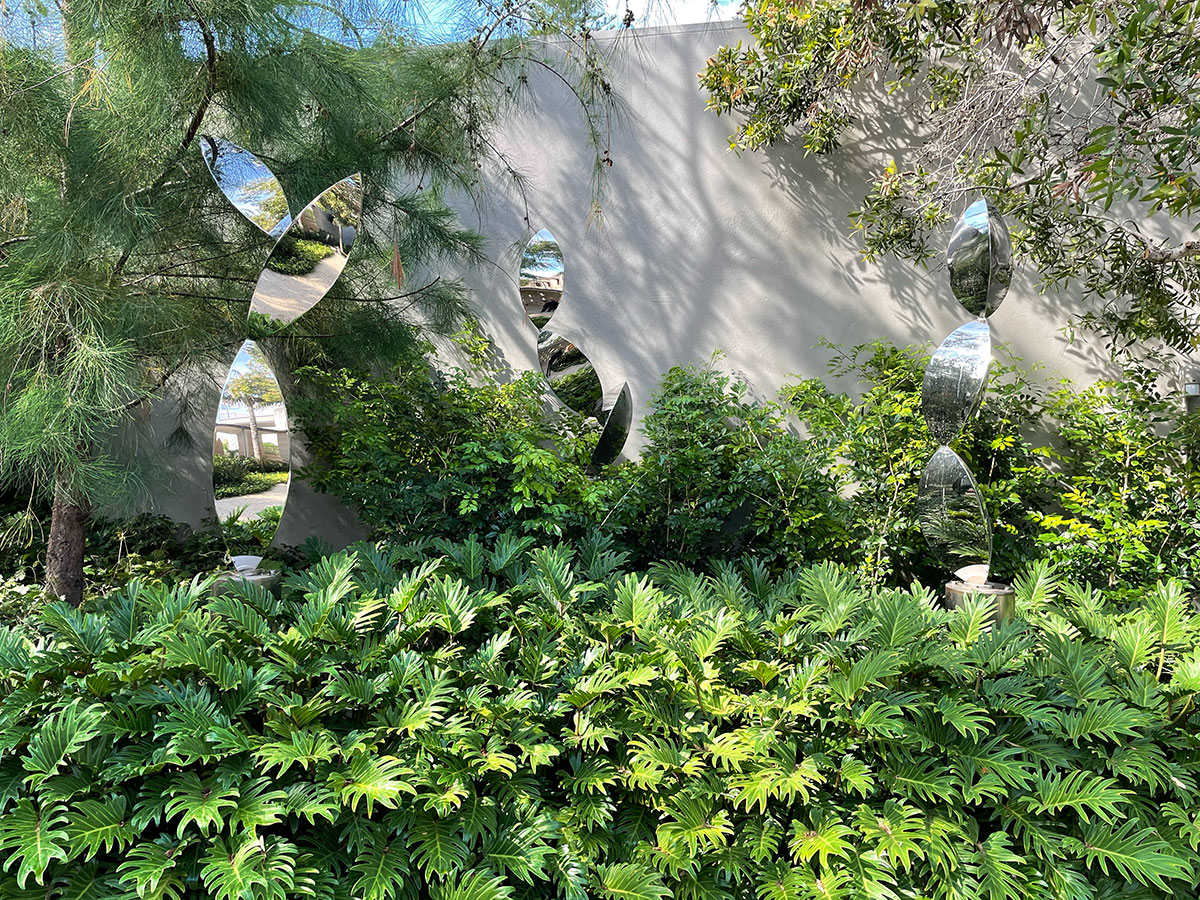
Koichi Ishino is a Japanese artist who after six years of showing at Sculpture by the Sea relocated to Gosford, NSW after finding inspiration from the Australian landscape.
The sculpture Mountain Air – Circles is a sculpture that combines materials that have very different visual and tactile qualities. The solidity and surface detail of natural granite is a sharp contrast to the bright mirrored surface of stainless steel. Ishino’s practice brings a sensation of imbalance and harmony, the material and immaterial together in one object.
Ishino’s work is held in a number of international public collections including Bournemouth University, UK, ArtsACT, Canberra, Kurashiki Municipal Museum of Art, Kurasiki City and Ikeda City, Osaka. He is further a Decade Club member of Sculpture by the Sea since 2011.
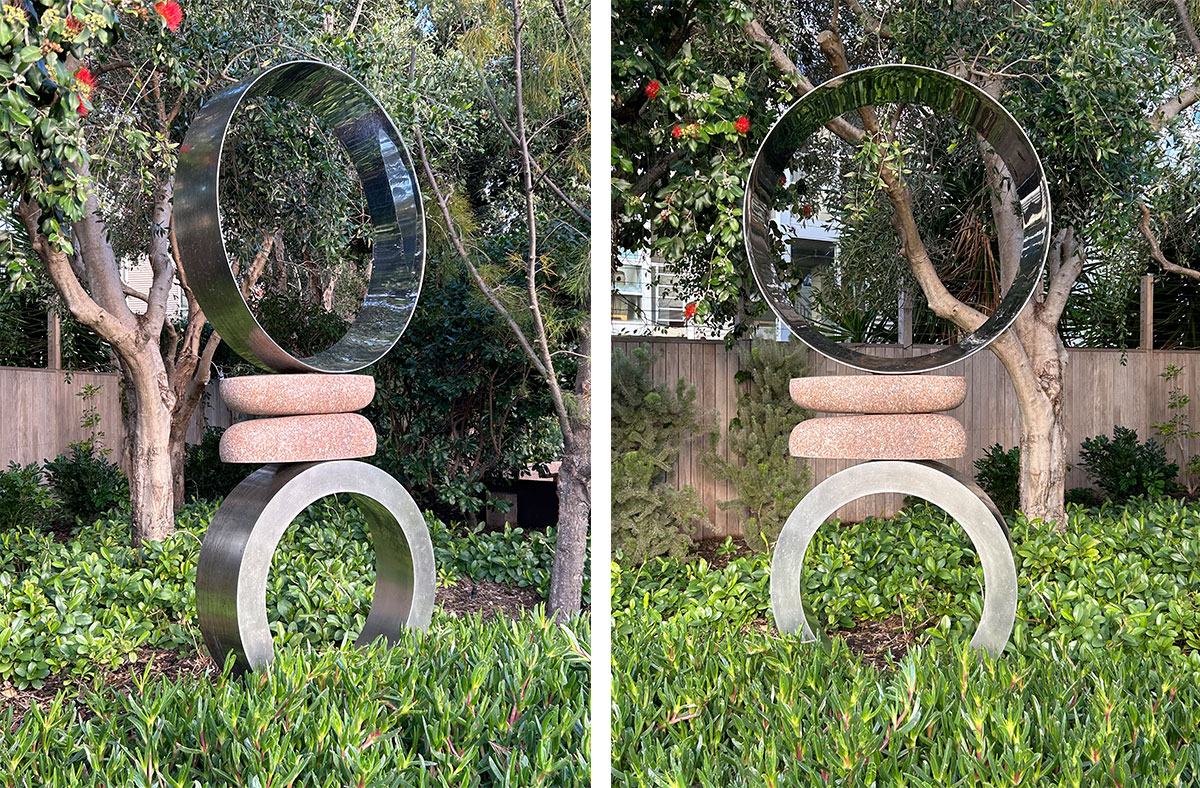
Japanese artist Toshio Iezumi creates unique contemporary sculptures using sheets of glass and a technique traditionally used for carving stone. His abstract glass sculptures change appearance depending on where they are placed and the position of the viewer.
Iezumi in an artist statement noted, “for my works to have something beyond my intention, I concentrate on grinding glass. In grinding glass, I have a conversation with it through my body: I ask the glass and the glass answers me. I ask the glass with my hands and receive its answer with my eyes. My works are born from such conversation.”
Iezumi’s glass abstract sculptures are included in several major public collections including the New York Museum of Art and Design, the Boston Museum of Fine Arts and the Tokyo National Museum of Modern Art.
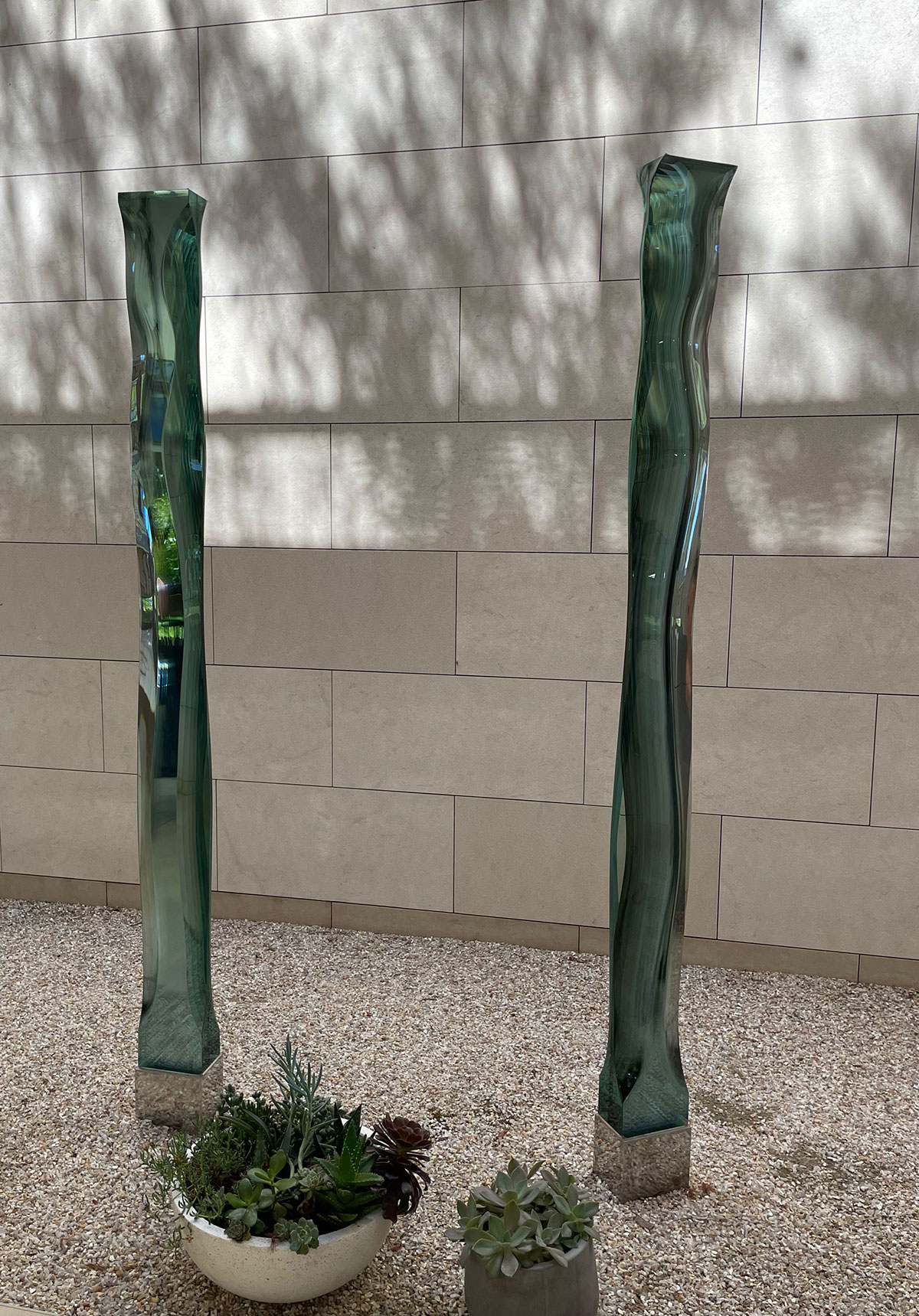
Takahiro Hirata is a sculptor from Japan whose practice focuses on the relationship between human’s primitive weaponry and their surrounding landscapes.
In an artist statement regarding his practice, Hirata stated that “in Japan, an arrowhead has a meaning of a talisman shooting against evil spirits. Evil may come from outside but also appears from inside of one’s self. Here a shining arrow breaks through darkness.
Hirata has exhibited in 10 solo exhibitions in Nagoya, Japan and is represented in many public and private collections including Asago Museum, Makurazaki City and the Town of Cottesloe, WA. He was a finalist in the in the 24th Ube Biennale International Sculpture Competition and won first prize at the 10th Asago Art Village Award Exhibition in as part of the Asago Biennale. Hirata has exhibited at Sculpture by the Sea, Bondi seven times since 2012 and Sculpture by the Sea, Cottesloe eight times since 2014.

Born in Beijing, China in 1960, Wang Shugang was one of the leading contemporary artists in the postrevolutionary breakout period of the mid 1990s.
Shugan generally uses only a few colours on his sculpture, painting them solid red, white, black or bronze. These colours have become a kind of language or a trademark of the artist. The “sweeping monks” and the “squatting” figures as shown in the Man on Ball series have further acted as motifs throughout his career. The artist stated – “These men are squatting on balls. Every second, one of the balls could roll away and the men run the risk of falling off the world. This work questions ideas about the individual and the collective.”
Shugang’s works have been shown internationally, representing China at the Vancouver Biennale in 2009 and 2011 also at the Mannheim Art Association, 2020 and the Public Sculpture Festival in Shanghai, 2019.

Completed in 2011, sculptor Brooke MacLean created these two figures based on Grace and Sophia Forrest.
The works are capturing a moment in bronze: the childhood playfulness of the Forrest daughters, throwing their hands up in the air. The two figures have been placed in the foliage of the garden, acting as a living and breathing reminder of their childhood.

Keld Moseholm is a Danish sculptor who works primarily in bronze to tell stories of humanity through comedy.
The work Project 2000 illustrates Moseholm’s sense of humour that he intertwines within his sculptural subjects. The sculpture is a satirical play on the nature of resilience, perseverance and team work through its comedic lens, as the figures are stumpy and placed in awkward positions.
Moseholm was selected to represent Denmark in the Aarhus Snowy Valley Sculpture trail as he had exhibited a number of times in Sculpture by the Sea. The Aarhus exhibition was initiated by Crown Prince Frederik and Crown Princess Mary of Denmark after they visited Sculpture by the Sea, Bondi during the Sydney Olympics in 2000.
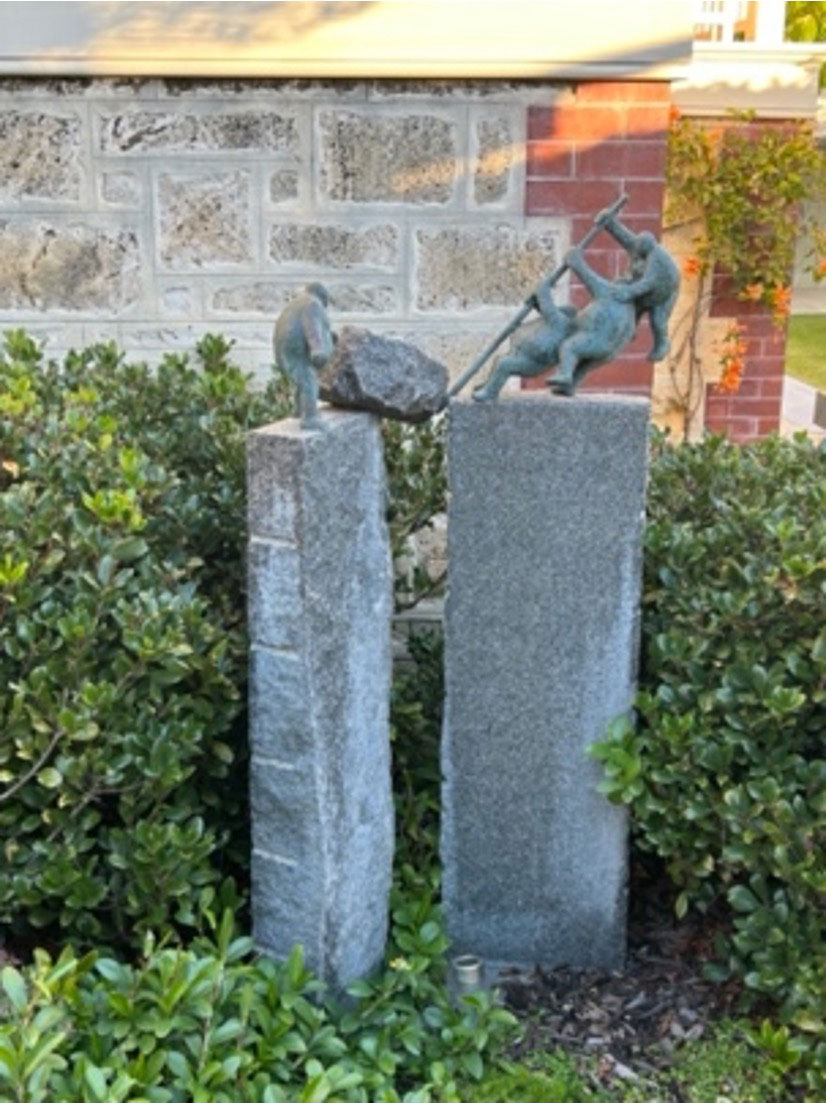
Emma Hutton is a recent graduate of the Queensland College of Art (2020), whose work deals with natural forms and organic materials.
The 2019 work Timber Skin features more than 5,000 hand-drawn, laser-cut timber pieces, threaded together with fine wire to form a scaled surface.
Timber Skin was selected for the prestigious Hatched National exhibition at the Perth Institute of Contemporary Art. The exhibition features 24 emerging artists, whose work spans painting, sculpture, photography, installation, textiles, sound and video.
In a statement from Hutton, she noted “this was my major graduation work at the QCA and for it to be on show at a national exhibition is a great opportunity… I loved transforming a solid piece of timber into something quite fluid – it was almost a meditative process, and it’s so rewarding to see your ideas take shape.”

Akiho Tata is the collaborative artist name from couple Akiho and Tata Ota, who want to share their universal message of wishing happiness to the world. The pink eggplant is representative of life, growth and prosperity.
The artists have participated in group exhibitions including the Yokohama Biennale, Kobe-Suma-Rikyu Park Modern Sculpture Exhibition and the Kagawa Arts Festival. Akiho Tata received the Takamat City Cultural Encouragement Award and Art Genki Power “Union Formation,” in 2006.
Akiho Tata have exhibited in Sculpture by the Sea, Bondi five times since 2010, Sculpture by the Sea, Cottesloe eight times since 2013 and ‘Sculpture Rocks’ in Sydney in 2021. One of their works is held in the Thompson Estate Collection in Margaret River.
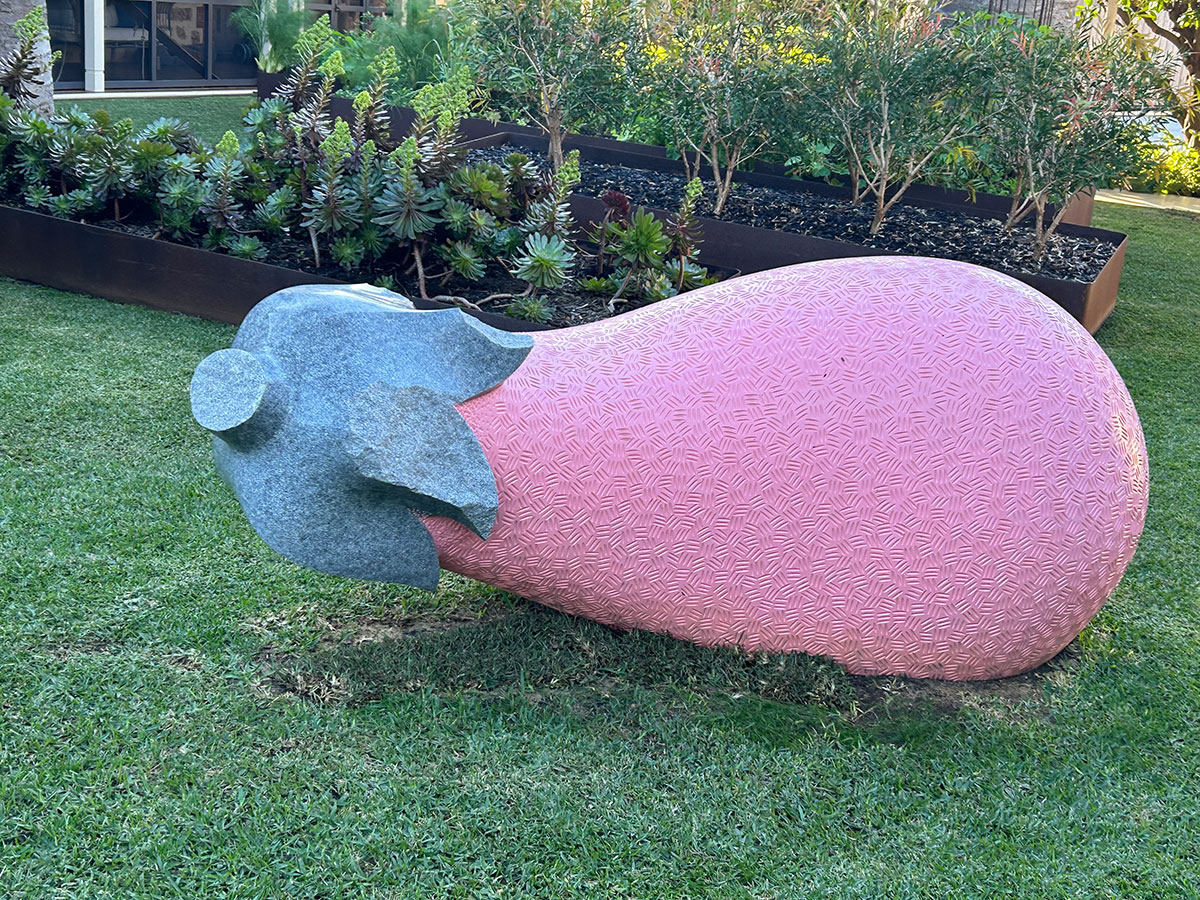
Jeffrey Smart is an acclaimed 20th century painter known for his urban and industrial landscapes. Having absorbed the influences of Australian modernism in the 1940s, he worked in a distinctive, highly finished and detailed style.
The Footbridge (1975) does not offer a faithful depiction of an exact scene. Rather, Smart here presents a composite image – carefully constructed from the complex weaving of motifs, symbols and disparate elements recalled from either real-life locations or gleaned from other artworks. As critic Barry Pearce elucidates, Smart’s paintings ‘…are, at the end of the day, expressions of himself. Container trucks which pollute cities, highways which have displaced communities, and geometric buildings which have absolved individuals from caring about each other are not in themselves beautiful.’ Smart’s paintings convey rather, a rich sense of optimism despite their occasional uncertainties – a poignant reminder that the things which seem upon first glance to reflect a brutality to the soul can become, ironically, a source of wonder.
Smart is held in all state Australian galleries. His work is further held in the international collections of Metropolitan Museum of Art, New York, Yale University, New Haven and De Beers Collection of Contemporary Art, London.
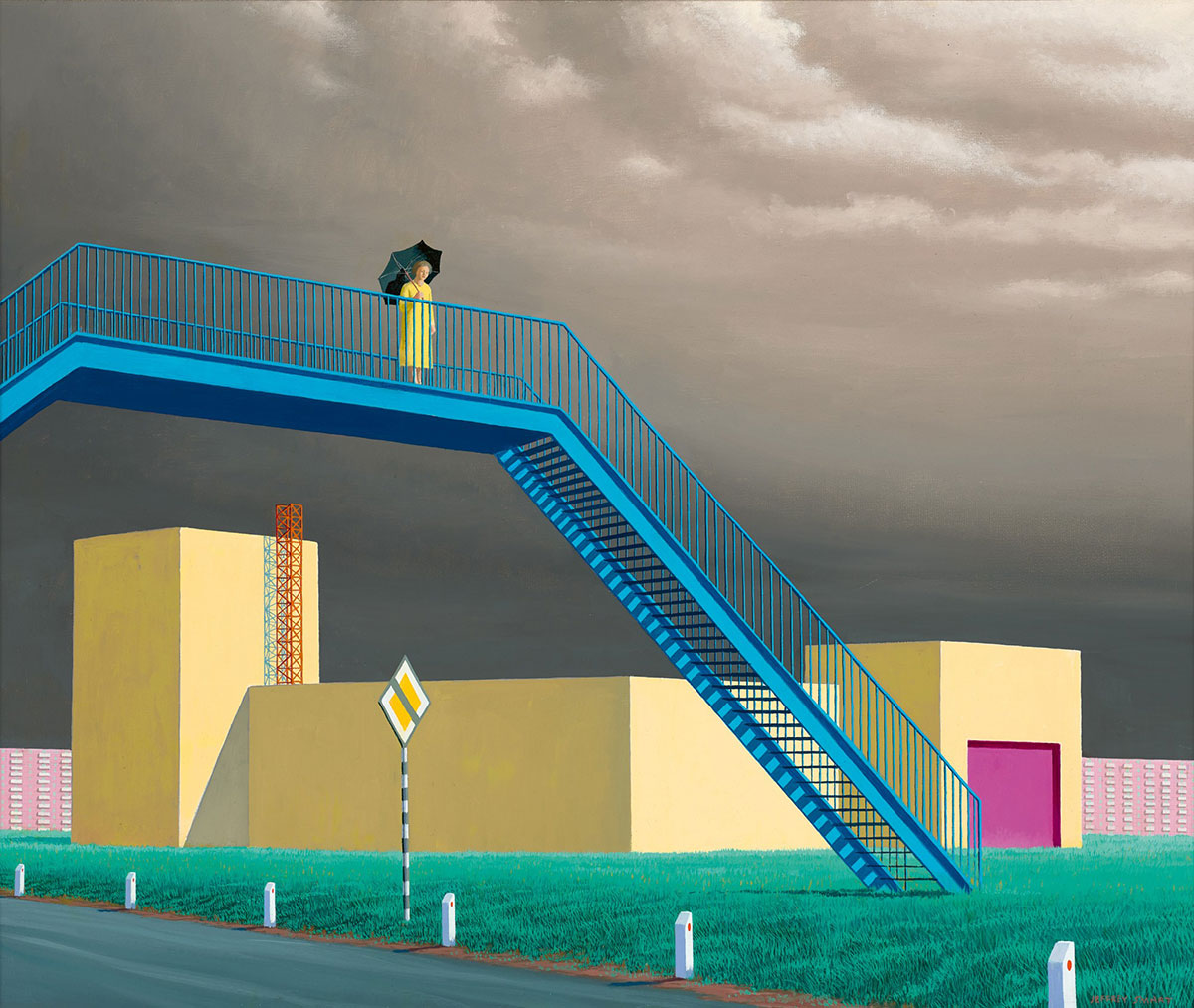
The son of a Dutch diplomat, William Boissevain is a painter who studied at École nationale supérieure des Beaux-Arts, Paris and in London before coming to Australia in 1947. His life’s practice focuses on the female form and the still life.
Boissevain has stated “I have developed a style of my own which relies strongly on outline and edges, which are formed by manipulating oil washes. A controlled effort is needed to cover the areas which are then charged with a thinner wash. I must emphasise this is quite difficult to achieve.”
The work Sunflowers and Poppies is a bright painting that gives life to the flowers and fruit within the depicted scene. The colour scheme of the background is multicoloured and blurred to extend the space beyond what we can see. This utilises Boissevain’s talent for bringing paint to life.
Boissevain was awarded an Order of the British Empire (OBE) in 1978 for his services to the advancement of art.

Robyn Mayo is a landscape painter who spent her upbringing on the Southern Tablelands of New South Wales.
Robyn’s paintings are reflections of her expeditions throughout the Australian countryside as she attempts to capture the geology, vegetation and history of the ancient landscape. Her Untitled Landscape work is a bright and vast representation of what seems to be ant mounds in the foreground with a long, deep perspective taking the eye to a far horizon. It is a quintessential, off the beaten track narrative that celebrates the vegetation and rich variety of colour in the Australian landscape, reminiscent especially of colours found in northern Western Australia.
Mayo’s work has been included in exhibitions at the Queen Victoria Museum and Art Gallery in Launceston, Art Gallery of Ballarat and Goulbourn Regional Art Gallery.
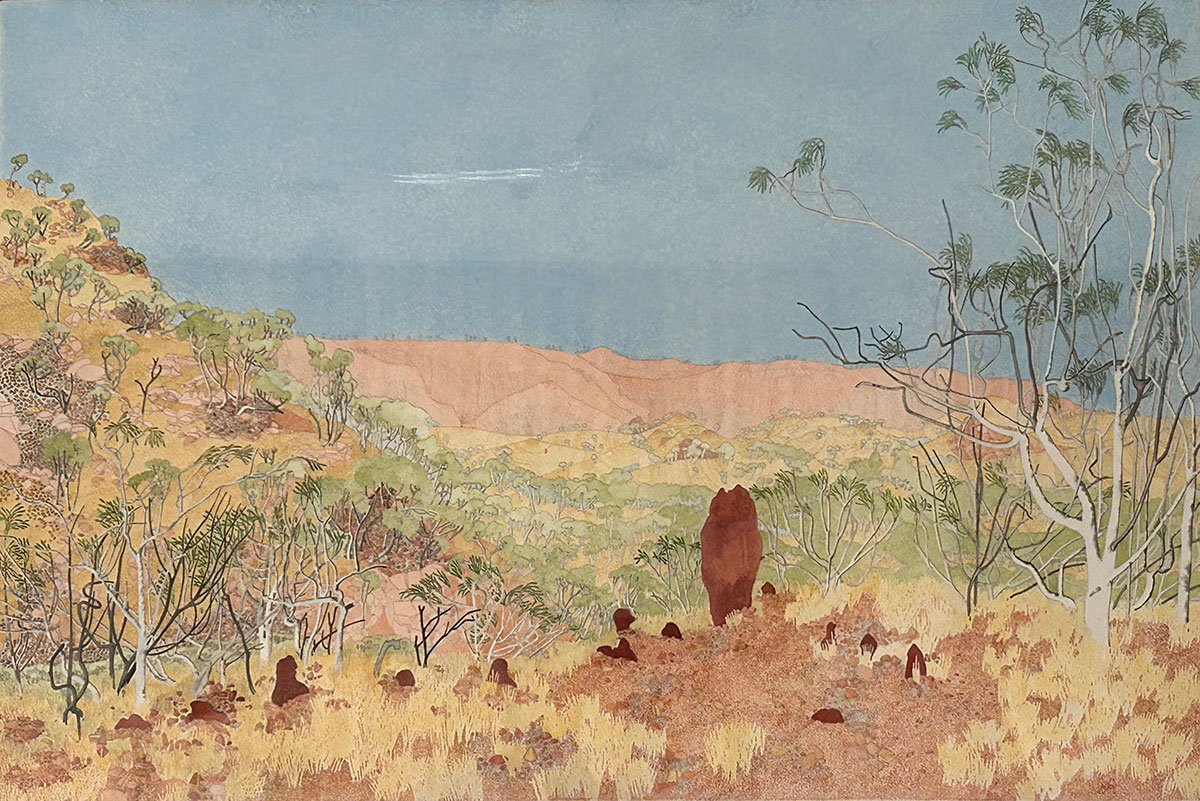
John Brack was one of Australia’s most prominent modernist painters in the 20th century and remains one of the key figures in the nation’s art history.
Brack’s fascination with the nude was a major focus within his oeuvre during the 1970s and 80s. Within these works, the artist explores a certain restrained sensuality and pleasure in depicting the female form. Within drawings like Reclining Nude, 1981, the subject looks completely at ease with her form and pose, seeming to reflect the changes in social mores and the increased informality of the late twentieth century. Brack’s Reclining Nude points also to the development of the artist’s own confidence and artistic maturity.
Brack’s work is held in all major Australian institutions including the National Gallery of Victoria, Melbourne and the Art Gallery of New South Wales, Sydney.

David Larwill was an Australian artist recognisable by his distinctive and exuberant style based on bold colour and stylised figures.
The sculpture Contemplating his place in humanity could be considered a self-portrait. Just before dying of cancer in 2011, Larwill was no doubt faced with the task of reflecting on his physical place in the world. The small figure could well be Larwill’s response to questions of self-identity.
A posthumous survey of David Larwill’s final decade of work was held at the Mornington Peninsula Regional Gallery in 2013. The 2011 bronze sculpture Contemplating his place in humanity was one of the works included and the small sculpture constitutes one of Larwill’s last works, which he was determined to finish prior to his death.
Larwill is held in a number of national collections including National Gallery of Canberra, National Gallery of Victoria, Melbourne and the Museum of Contemporary Art, Sydney. Internationally, Larwill is represented in the collection of The British Museum, London.

Ron Gomboc arrived in Australia at the age of 13 and has since become renown for his sculptures that explore the nature of human identity.
The 2020 work Embrace is a small sculpture that consists of enveloping organic, fluid forms, and is thought to be a study for a larger work included at Sculpture by the Sea that same year.
In an artist statement regarding the work, Gomboc wrote – “to Embrace is as old as time where humanity has shown love and affection for one another and the necessity of that expression regardless of gender. It can be a spiritual embrace; it can be physical without necessarily being sexual. Together in hope, the shape of the twist in the sculpture comes from fingers crossed that the relationship will last through the twists and turns of life with faith rising above it all. This would not be possible without a good partner’s embrace.”
Gomboc resides in Western Australia. He has held numerous solo exhibitions in Europe, Asia and Australia and he has completed private and public commissions including two 3.5 metre rearing horses that was commissioned by the country of Brunei.

Jens Einhorn is a German contemporary artist whose work channels the assertive energy of the urban landscape within the natural world.
Einhorn’s work incorporates shapes cut from tarpaper, layered within a vibrant collage of fabric, acrylic, string and spray paint. In the 2017 work Chlorine and Memory the gritty, plant-like silhouettes allude to East Germany where Einhorn grew up and explored as a teenager. Einhorn’s ‘natural wilderness’ is the concrete jungle of the city, where leaves cover tarpaper roofs, blending with the colours of graffiti and rust.
Einhorn has been featured in a number of international institutions including the C. Rockefeller Centre for the Contemporary Arts in Dresden and the Museo Nazionale di Capodimonte in Naples.
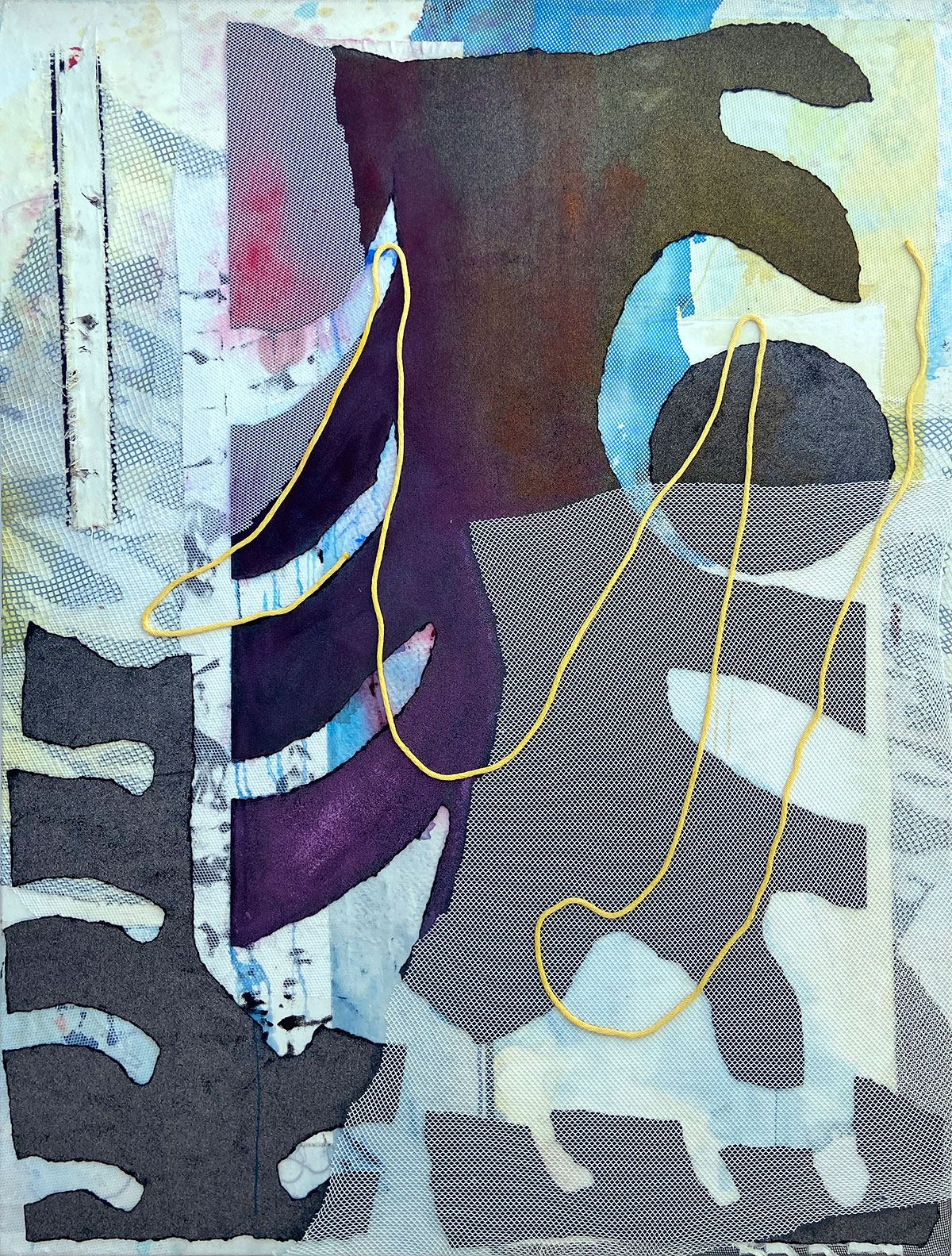
From left to right:
I Want to Get Off 1996
Skipping Girl 1996
Full Frontal Ship 1996
The Send Off 1997
Real Pirates 1997
David Bromley is a popular Australian contemporary artist.
The 1990s series of circular works I Want to Get Off, Skipping Girl, Full Frontal Ship, The Send Off and Real Pirates are a testament to Bromley’s ability to capture childhood innocence and wonder. The frames are made to look like windows on a ship and the bright colour palette brings forth a sense of play and endearing mischief.
Bromley has had more than 30 solo exhibitions in Australia, as well exhibiting regularly throughout Europe, the UK, South Africa, Asia and the United States.

Brett Whiteley was at the forefront of Australian visual arts in the 20th century, establishing himself as one of the most influential and important painters whose work related to both the urban and natural worlds.
While living in London in the 1960s, Whiteley consistently completed works at the London Zoo including the 1965 Drawing about Drawing. The artist at the time stated; “To draw animals, one has to work at white heat because they move so much, and partly because it is sometimes painful to feel what one guesses the animal ‘feels’ from inside.” The work represents this sentiment as the enclosure consists of hastily drawn lines and the animal is largely undetailed. The portrayal of the artist in the bottom left corner personalises the piece, documenting the artist’s practice in real time.
Whiteley’s work is represented in the collections of all Australian State galleries and internationally at the Tate, London. In 1978 Brett Whiteley became the first artist to win all three major Australian art prizes – Archibald, Wynne and Sulman – in the same year.
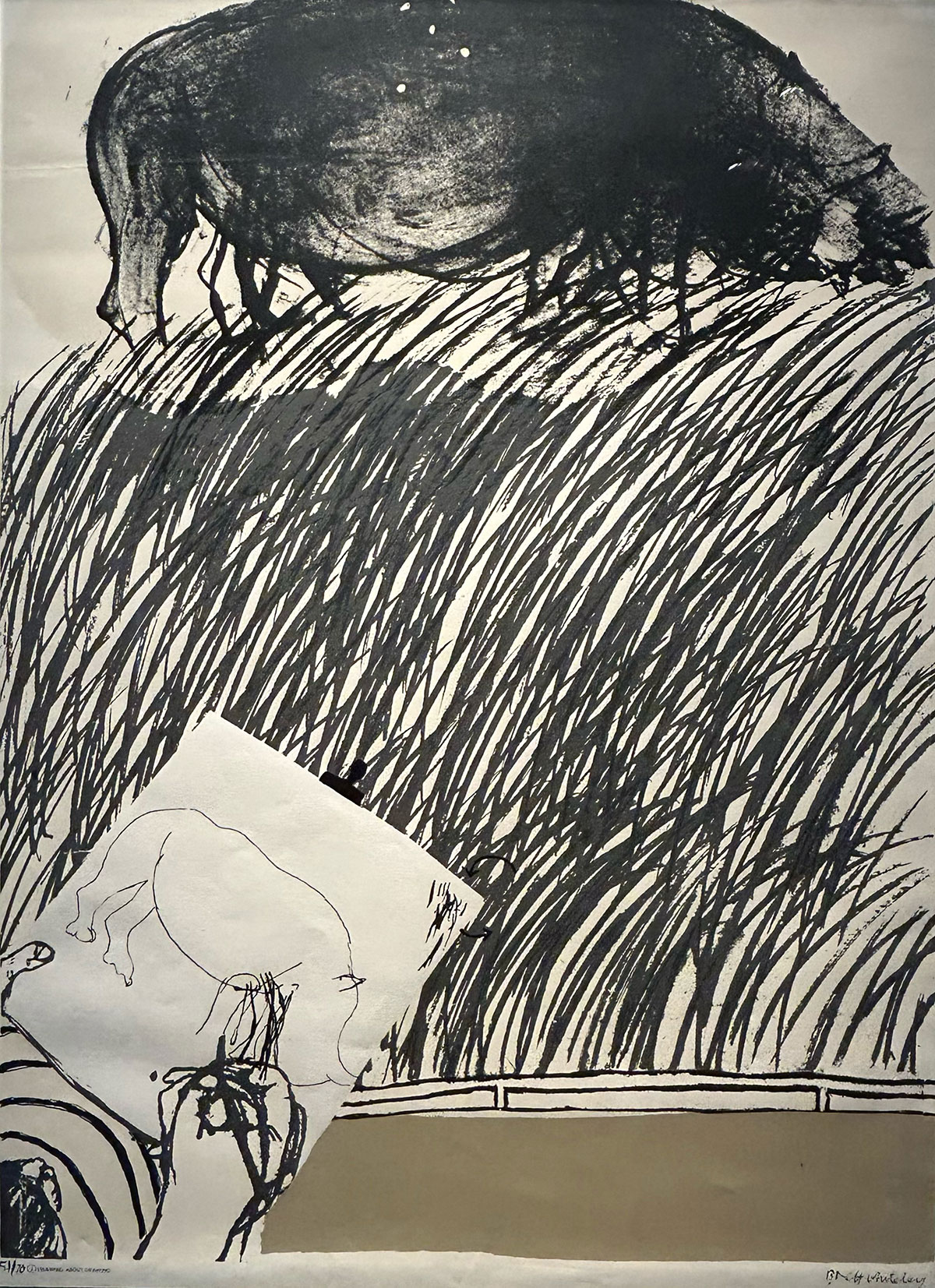
Arthur Boyd is recognised as one of Australia’s most important artists from the middle of the 20th century. As a member of the 1950s Antipodean figurative art movement, Boyd has had a wide influence over the development of Australian art.
The work Shoalhaven painted in 1982 illustrates Boyd’s fascination with the Australian bush and the connection of landscape that was deeply familiar to the artist. After a period of living in England, Boyd settled in 1971 at Bundanon on the Shoalhaven River in New South Wales where he painted many natural forms of the property. Shoalhaven portrays a single fishing boat against the backdrop of a large cliff face, a symbol of our relationship with the vastness of the Australian landscape.
Arthur Boyd’s work is held in all major State public galleries.
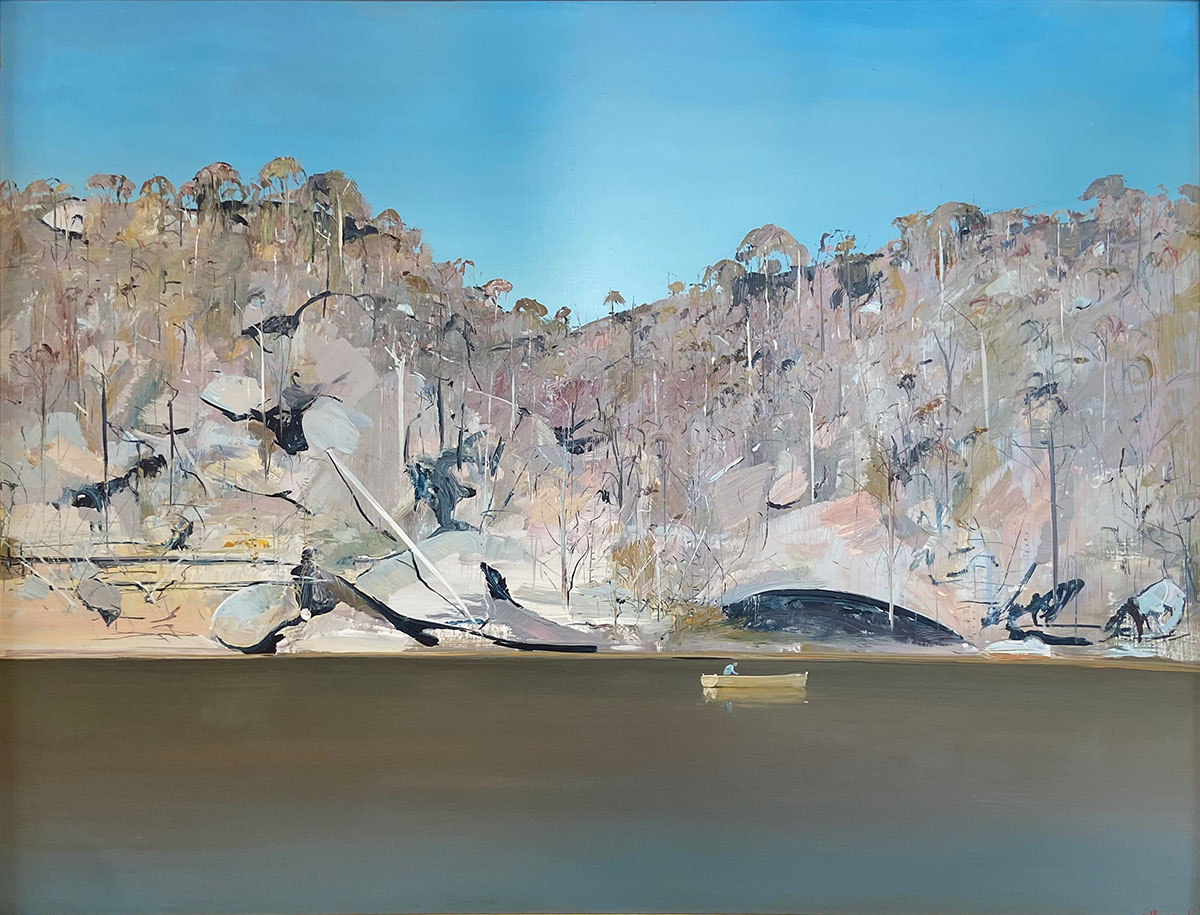
Brett Whiteley was at the forefront of Australian visual arts in the 20th century, establishing himself as one of the most influential and important painters whose work related to both the urban and natural worlds.
The 1979 watercolour, Winter Willows explores Whiteley’s painterly flow as his roads and rivers twist up through undulating hills. The work uses muted colour tones to explore the arid and quiet nature of the Australian outback landscape. The work’s strength is in its subtle details as Whiteley places the focus on the gentle movement of the land, the shrubbery, the trees and their relationship with the wind.
Whiteley’s work is represented in the collections of all Australian State galleries and internationally at the Tate, London. In 1978 Brett Whiteley became the first artist to win all three major Australian art prizes – Archibald, Wynne and Sulman – in the same year.

John Kelly was born in Bristol, UK, in 1965 and his family emigrated to Australia later the same year and settled in the Melbourne suburb of Sunshine.
The 2014 work Man Lifting Cow is a sculpture that follows Kelly’s career spanning motif of the Dobell Cow. The Dobell Cow is based on famed World War II camouflagist Bill Dobell’s papier-mâché cows. As a camouflagist, Dobell was one of a group of several artists who had been ordered to make papier-mâché cows and move them around the army base in the hope of fooling Japanese pilots. Dobell once famously stated, ‘I think the authorities underestimated the eyesight of Japanese airmen.’ The Man Lifting Cow sculpture illustrates a blend of Kelly’s humour with his interest in Australian history.
Kelly has exhibited internationally at the Samstag Museum of Art, Adelaide, the Goteborg International Biennial for Contemporary Art in Germany and the National Taiwan Museum of Fine Arts. His work is also held in a number of Australian collections including the Art Gallery of New South Wales, Art Gallery of South Australia and the Museum of Old and New Art, Hobart.

Sidney Nolan is one of Australia’s most recognisable artists whose motifs of Ned Kelly and imagery of the outback have become synonymous with the Australian national identity.
Sidney Nolan’s portrayal of the Australian landscape is often a stripped back, mythological place. In the case of Ore Train however, Nolan signals a new era of modern life. The ore train, a symbol of Australian industry, charges through the landscape with smoke billowing, taking centre stage. Nolan’s classic feathery brushstrokes are evident in the painting which announces a moment in Australia’s industrial growth not connected to the pastoral or to city life.
Nolan’s work is held in all State galleries. He was elected an honorary member of the American Academy of Arts and Letters and a member of the Royal Academy of Arts, London.

Sidney Nolan is one of Australia’s most recognisable artists whose motifs of Ned Kelly and imagery of the outback have become synonymous with the Australian national identity.
Leda and the Swan is a story and subject in art from Greek mythology in which the god Zeus, in the form of a swan, seduces Leda the Spartan Queen. As Cynthia, Sidney Nolan’s wife, recorded, “Now, over and over again, he was painting Leda and the Swan. Sometimes the woman was bloody, the swan was very savage.” Here, the woman and the Swan exist as a singular entity.
Art Historian Tom Rosenthal explains that the story of Leda and the Swan is notable for the distinct feminine features of Leda and the form of the swan in anticipation. There is a tenderness between the two figures, and, in this work, their intimate contact is evident.
Nolan’s work is held in all State galleries. He was elected an honorary member of the American Academy of Arts and Letters and a member of the Royal Academy of Arts, London.

Albert Tucker was one of Australia’s foremost 20th century painters. Tucker was a key member of the important Angry Penguins and Antipodean movements of the 1930s alongside John Brack and Robert Dickerson.
Tucker’s 1963 painting Girl Bathing is a sombre representation of a hidden figure in the Australian bush. Tucker employs predominant shades of brown to create a sense of eerie emptiness that extends throughout the landscape. In removing colour, Tucker also removes the sense of optimism normally found in Australian landscape paintings of the time.
Tucker’s work is held in a number of major Australian institutions including the Art Gallery of NSW, Sydney, the National Gallery of Victoria, Melbourne and the National Portrait Gallery in Canberra.

Pedro Wonaeamirri’s distinctive translations of Tiwi culture pulse with a refined geometry. His works – across carving, painting and printmaking – are spun from the conceptual apparatus of Tiwi parlingari (creation) narratives
The painting Pwoja-Pukumani Body Paint Design is a cultural work that reflects the importance of decoration within Tiwi funeral ceremony. Traditional Tiwi culture places special significance on the Pukumani (funeral) ceremony. Mourners are decorated using natural ochres to disguise themselves from the spirit of the deceased and song and dance is performed to honour the dead. Yirrinkiripwoja (body paint) is the source of many contemporary Tiwi designs, and performance of the pukumani as ritual helps to reinvigorate the imagery.
About the artist:
Pedro Dennis Wonaeamirri was born in 1974 at Pirlangimpi on Melville Island. His country is Goose Creek, Melville Island. A member of Jilamara Arts & Crafts Association since 1991, he lives and works at Milikapiti on Melville Island. His work is held in the collections of the Museum of Contemporary Art, Sydney and the Art Gallery of New South Wales, Sydney.

Rich in painterly colour, Judy Mengil’s practice explored natural phenomena, the presence of Dreaming and the creation of geological landforms. The Dreamtime narrative brings to life the creative energies that shaped the artist’s Country and reiterated for her the existence of a living spiritual presence.
Judy Mengil’s images are often dominated by bold colour, strong forms and the vastness of her Kimberley landscape. Within the work Binjin Baliboong, Mengil explores the intricate details of moving water, the delicacy of lush and shady waterholes and freshwater springs surrounded by waterlilies.
About the artist:
Mengil’s work is held domestically and internationally at the Musee de Confluences Collection, Lyon, the National Gallery of Australia, Canberra and the Wollongong University Collection.

Arthur Streeton (1867-1943) was one of Australia’s finest landscape painters. He was a forefather of Australian Impressionism and is oft en considered one of the most influential painters in Australia’s history of art since white settlement. His landscape paintings have become key to not only an understanding of his practice but symbolise our changing relationship with this country throughout the late 19th and early 20th century.
Influences of Romanticist J.M.W. Turner can be found in the captivating light and bravura of The Harbour from Mosman, embracing this unique, breathtaking view. For Streeton, the colour blue dominated many of his paintings of the twenties, being both the colour of the waters and the sky on the brightest of days. In a 1926 exhibition review, the art critic for The Age wrote that ‘in The Harbour from Mosman the suggestion is Turneresque in a measure, and the impressive subject, if not actually idealised, is depicted under conditions which confer on solid terrestrial material ethereal attributes.’
Arthur Streeton painted many works of this area of Sydney (day and night, large and small). This painting is considered signifi cant among them, having been included in Streeton, the major retrospective of the artist’s work held at the Art Gallery of New South Wales (2020 – 2021).
Streeton’s work is held in the permanent collections of all State museums in Australia.

Arthur Streeton was one of Australia’s finest landscape painters. He was a forefather of Australian Impressionism and is often considered one of the most influential painters in Australia’s art history since white settlement. His landscape paintings have become vital to understanding his practice and symbolising our changing relationship with this country throughout the late 19th and early 20th century.
This painting of Rouen, Normandy, emerged from Streeton’s extensive travels through France in 1912, during which the English artist, collector, and philanthropist Sigismund Goetze was present.
‘Looking down a gently sloping, grassy hill, past rows of tiny houses towards the centre of Rouen, the painting adopts a broad view of its subject, taking in the pale blue river that meanders through the landscape, flanked by towering industrial chimney stacks and other buildings, all brought together under a vast open sky.’ [1]
Streeton’s work is in permanent collections at all state museums in Australia. In 1928, he won the Wynne Prize for the work Afternoon Light, Goulburn Valley.
[1] Kirsty Grant
